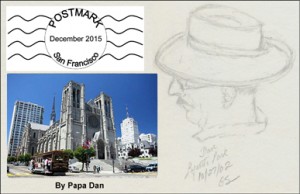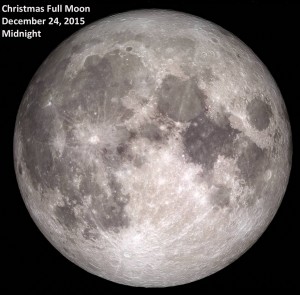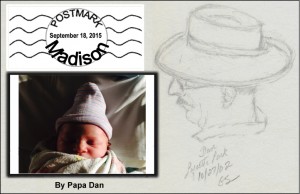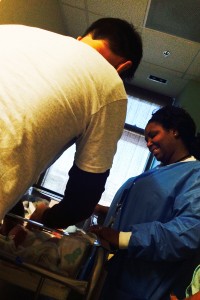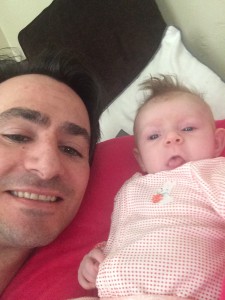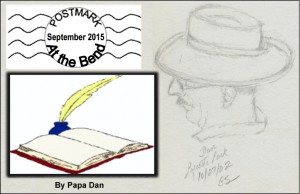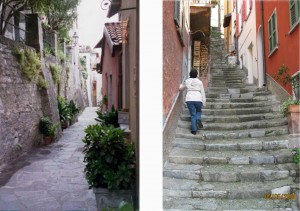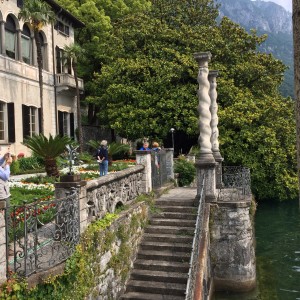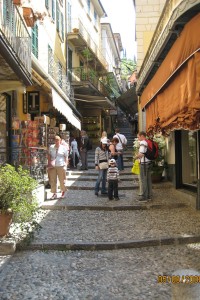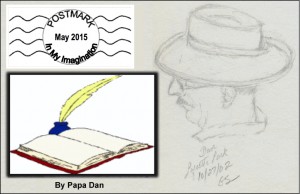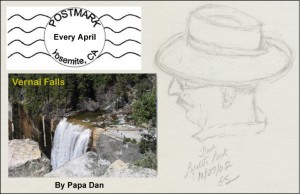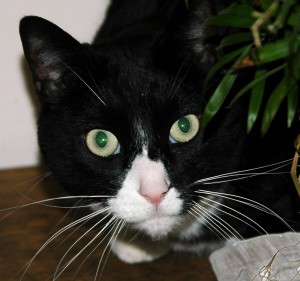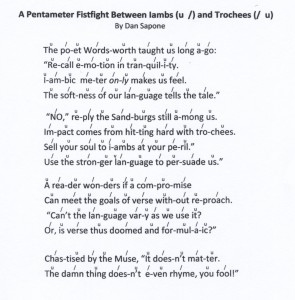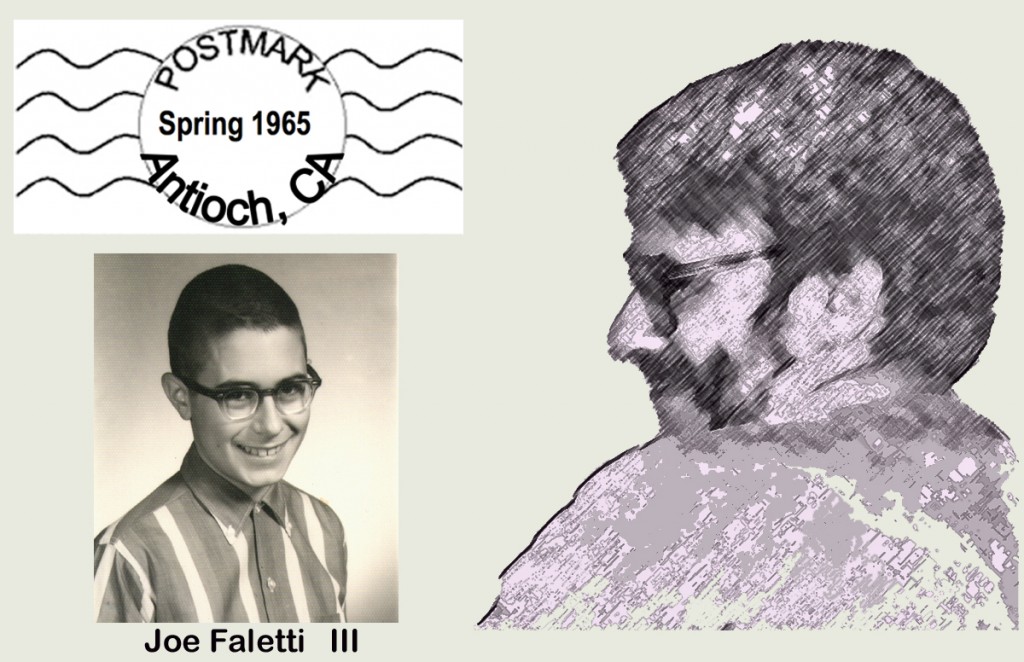An Optimist Looks At 2018

“I’m an optimist. I tend to believe that, at some point, common sense and justice
will prevail, at least for a while.
I was raised to believe that you
can make good things happen.
Let’s face it, nobody gets out of here alive.
So, if today isn’t to our liking, it’s on us to
own it and make it better. We have more than enough people trying to make it worse.”
— PapaDan.”
Click here to download a PDF of this post: Optimist_looks_at_2018_FINAL
= = = = = = = = = = = = = = = = = = = = = = = = = = = = = = = = = = = = = = = = = = =
2017 was a strange year
An optimist might be hard pressed to use 2017 as a guide for deciding what to expect from 2018. Events in 2017 were certainly not predictable from evidence provided by 2016. For most of the year, how many predicted the outcome of the election, the reversal on the Paris Climate Accord, the childish name-calling that emerged in public discourse, a disparaging attitude toward the victims of natural disasters, and the threat of war around the world. Nobody expected that 2017 would be a year of women’s empowerment with a long list of male celebrities falling from power and influence after revelations of sexual misconduct. And, those stories are NOT over yet. None of them. An optimist has to look elsewhere to make predictions.
This Optimist’s Predictions for 2018
So, with 2017 as an unreliable body of evidence, how can we decide what to expect from 2018? Here are some things that this optimist expects are possible.
We’ll start with the important stuff:
The Academy Awards: “The Post” will win the award for Best Picture. How could it miss — it highlights the value of courage, the importance of the press in holding the powerful accountable, and the indispensable role of a woman pushing against daunting obstacles — the perfect messages for our times — AND it stars Meryl Streep and Tom Hanks! Bet the farm on it. (OK, so I predicted “La La Land” would win last time; and I was right for about 30 seconds.)
The Grammy Awards: I haven’t the faintest idea, since I haven’t heard of most of the nominees. — although the album “Tony Bennett Celebrates 90” sounds promising.
The NBA Championship — The Warriors will win — nuff said. (How many players can share the MVP award?)
The World Series — I can’t comment on the outcome of a World Series between the Yankees and the Dodgers; it violates every principle of “The Optimist Creed” (take a look here) that used to hang on the wall in my Dad’s office. So, I am required to predict that My Giants will win (maybe . . . someday).
The Super Bowl — I really don’t care, except that I hope football will continue to decrease in popularity, starting at the local school-district level and permeating upward. (BUT, Nancy has a terrific Super Bowl Party that MUST continue! — It’s all about the commercials and the wine.)
Now, Let’s Get Serious . . .
The U.S. Economy:
Paid family leave will become increasingly widespread — On January 1st, New York joined California and other states requiring paid family leave in more categories of employment.
The (new) Great American Migration begins — Silicon Valley and Wall Street will follow Amazon’s example and open major campuses in American regions where unemployment is high and real-estate prices and taxes are low. Depending on how fast and how thoroughly this strategy plays out, this migration could change . . . well . . . everything we currently understand about American life from politics to economics to regional culture.
Cost of Living vs Income — Minimum wages are rising in some 18 states at the start of 2018 (ranging from $7.95 in Missouri, to $13.50 in parts of California, to $15.45 around Seattle). The Great Migration mentioned above will strengthen this trend. The U.S. inflation rate is predicted to hover around 3.2% in 2018 (up a bit from 2017); BUT, the coming budget deficits caused by “tax reform,” may dramatically inflate the inflation rate nationally. We’ll have to wait and see.
Home purchases and mortgages — High house prices left over from 2017 are likely to stay high. People who live in places that lose historic industries (say, coal mining) will find it expensive to move where the jobs are and those opportunities are likely to require different skills and more education. With all the rebuilding that will be necessary after the hurricanes and fires, housing will be a challenge for the working class. We’ll have to see how/if the “Migration” works out.
The stock market will continue to rise, and even more sharply as corporate tax cuts take effect. Some will continue to assert (citing “alternate facts”) that profits reflected in stock prices lead to increases in hiring and wages. Economic history teaches that employers don’t hire employees because they receive a tax cut. Hiring has been stimulated primarily by one overarching feature: customers with money in their pockets. Therefore, the factors likely to lead to large-scale hiring are mostly absent from the business outlook for 2018. Instead, the market boom will continue to result in higher dividends for shareholders and profitable mergers that lead to consolidation (read: layoffs). THEN, corporate celebrating will be interrupted by an Autumn sell-off like the one in 1987. Such a sell-off and the above-mentioned migration could confirm the disjointed relationship between the stock market and the rest of the economy. Is that good news or bad news? This optimist predicts the result will be a dramatic election turn-about in November.
“The Mall” vs “Downtown” — A life-and-death struggle is developing between malls, with corporate stores like Macy’s and Nordstrom, and locally owned downtown shops. AND both of these business models are threatened by Amazon-style online shopping. Will online commerce drive local stores out of business? How many? What will happen to the people working in those stores? This optimist makes a two-stage prediction. First, online shopping will continue to strain local stores well into 2018. But, I expect large numbers of people to make the conscious decision to “shop local.” We’ll get tired of sending online purchases back to Amazon because they don’t fit right or don’t look the same as they do online. More shoppers will decide that they want to try on their purchases. Amazon seems to agree, given their purchase of Whole Foods and Target. If that happens soon enough, local stores may continue to be the backbone of local economies.
Optimists are mixed on this. We’ll have to wait and see.
World Events
The Korean Peninsula will begin to show peaceful signs by the end of January, despite the bellicose influence of the U.S. president in the region.
— On January 1st, Kim Jong Un extended an olive branch to South Korea, proposing discussions about the possibility of a North Korean delegation to the upcoming Winter Olympics in South Korea. He expressed the goal of a “peaceful resolution with our southern border.” South Korea agreed to high-level discussions on January 2nd. Prediction: the U.S. will continue to become more isolated in foreign affairs as other nations — in Europe, Asia, and the Middle east — explore solving worldwide problems (like global warming, “a two-state solution,” and European cooperation) without the obstacles created by rhetoric from the U.S. president. This promises to be both a problem (Step One) and a solution (Step Two) as an eventual rebalancing begins.
The Winter Olympics in South Korea — For two weeks in February the world will focus on the games alongside the warlike rhetoric of Kim Jong Un and Donald Trump. Many have suggested that this event is a recipe for disaster in the current international climate (remember the massacre at the Summer Olympics in Munich in 1972?). This optimist has come around to the view that, this time, the Olympics will actually do what they were intended to do — bring people together and lead to better understanding among people who look at the world through different eyes. North and South Korea may come around to find common interests and make their own way without the superpower rhetoric that has kept them apart for the past fifty years.
A Royal Wedding — Prince Harry and American Meghan Markle will be married in May. It will be a day for Brits to enjoy their royal anachronism. As usual, however, America’s top-level weirdness is interfering. Will the Royal Family insist that the sitting American president be invited or will the groom simply invite his buddy Barack and cause another Trump-centered kerfuffle? This optimist predicts that Obama will be invited to the wedding as a friend of the family and Trump will announce his rejection of the (not yet offered) invitation. Most Brits will say good riddance, keep calm, and carry on. Trump will probably announce that the British Prime Minister will not be invited to his Fourth of July tea party at Club Mar-a-Lago.
Domestic Politics
Trump’s Approval Rating will dramatically increase to 25% after he resigns in June. Two possible reasons will be offered for his resignation: 1) for health reasons or 2) “It was always my intention to make Mike Pence President; so, this is another in my long list of successes.”
The American 2018 Mid-Term Election — The November election will decide the control of the House and the Senate. This Optimist predicts that Democrats will win a slim majority in both houses and begin efforts to restore America’s leadership in areas like global climate, science-based energy independence, a two-state solution in the Middle East, income equality, a sensible tax structure, and other urgent policy areas. Prediction: in the short term, they will fail in many of those efforts. The Trump (or Pence) Administration will stand in their way as best they can. But, it will be a first step. The work will continue in statehouses and city councils across America. We’ll find out what we’re made of and it will take some time in the imperfect way we optimists always conduct ourselves.
We’ll see. This optimist expects to be surprised.
Finally,
This optimist believes that the key to a better 2018 will not be found in the national news; it will have to come from the way we treat each other right here in our own neighborhoods and families. While race, class, gender, and religion will continue to be a source of national and international conflict, the way forward must be local — in our selection of the people we choose to emulate — teachers, neighbors, you and me. We can affect change, but we have to be patient. I like a line I read from distinguished journalist Eric Sevareid near the end of his life:
“I’m sort of a pessimist about tomorrow and an optimist about the day after tomorrow.”
And as President John F. Kennedy said near the end of his inaugural address in January of 1961:
“All this will not be finished in the first one hundred days.
Nor will it be finished in the first one thousand days,
nor in the life of this administration,
nor even perhaps in our lifetime on this planet.
But let us begin.”
Yes, the sun will rise in the morning, good people will do the work they do best, be a good friend, be a good parent. a good sister or brother — and oh, YES, drink some good wine. Some will find ways to bring others along with them, helping those who need help and encouraging those who need only encouragement. Optimists will take inspiration from those optimists who have gone before them — like Winston Churchill, who said:
“Success is not final, failure is not fatal:
it is the courage to continue that counts.”
Happy New Year!
![]()
The Winter Solstice: A Time for Review
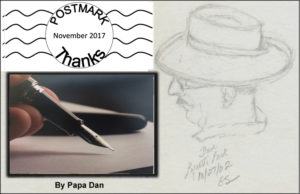
“The Winter Solstice has always been special to me, as a barren darkness that gives birth to a verdant future, a time of pain and withdrawal that produces something joyful, like a monarch butterfly extracting itself from its cocoon.”
— Gary Zukav
“The Romans, like other [ancient] nations, had nature festivals celebrating the death of winter to the life of spring — the Winter Solstice, featuring the giving of presents, the lighting of a huge log, and the burning of candles.”
— Samuel L. Jackson
Click here to download a PDF of this post: 70-ConVivio_Solstice_Dec_2017
= = = = = = = = = = = = = = = = = = = = = = = = = = = = = = = = = = = =
New Realities Are Emerging
Perhaps, it is the time of year: The Winter Solstice — the shortest day of the year. Since ancient times, the days between about November 21st and the new year have signaled a time for review and thoughtful reflection. While I have tried over the past year to avoid writing about our corrosive politics, a few writers and a couple of thoughtful voices have offered a more dignified and insightful approach to our politics than we have seen elsewhere in the media. So, I thought I’d give it a try. Two writers are worth a look:
• Steve Israel wrote a column for CNN online called “Forget red vs blue states, this is the real battle in America”
• David Brooks wrote a piece in the New York Times on Nov.9 with the strange title,
“The Existing Democratic Majority”
(Click on the titles above for links to the original articles.)
Let me attempt to briefly extract the ideas that made me sit up and take notice.
1. In “Forget Red vs Blue,” Steve Israel makes a dramatic assertion: that the divided politics that became familiar to us during the Bush and Obama years have been utterly disrupted. For years now, we had come to understand that all political issues and government decisions revolved around the divide between Red States and Blue States. Regions dominated by Republicans supported a predictable array of policies and attitudes. Likewise, those dominated by Democrats also supported largely predictable positions. With very little overlap, decisions came down to vote counts along that divide. His analysis — today two very different groupings have emerged by which decisions are likely to be made. We can call them “parties” if we want; but the designations “Democrat” and “Republican” no longer adequately define them. Some call it a struggle between “populists” and “the establishment”; but those labels don’t tell the whole story either. Steve Israel described them this way:
a) “The Normicon Party” consists of people from both traditional parties who favor respect for civility, stable institutions, and recognized ethical expectations. Normicons try to subordinate immediate emotion to long-held principles. Using a sports analogy, for them, politics is like boxing: “They may not watch it, but they understand the point of its rules, referees, and judges.” They prefer to maintain what most would recognize as “norms”
b) “The Denormocrat Party” embraces strength through attack, assaults on institutions, and the flouting of rules and regulations (i.e., “De-norming”). Denormocrats are willing to suspend long-held ethical expectations for short-term emotional gain. For them, politics is like cage fighting: “They may not watch it, but they identify with its full contact and minimalist rules.” They prefer to discard what most people recognize as “norms.”
Normicons see stability through order. Denormocrats seek salvation through disorder.
A number of writers have used words like the following (from Ezra Klein) to describe the 2016 election: “In the recent past, our divisions have been Democrats versus Republicans, liberals versus conservatives, left versus right. But not this election.” This campaign is not merely a choice between the Democratic and Republican parties, but between normal political parties and an emerging abnormal one.
2. David Brooks, in his column on Nov. 9th, proposed another way to understand the emerging American political landscape. He suggested that the “Republican vs Democrat” divide is being replaced with something different. Voters are starting to sort themselves into two groups that he calls “Somewheres” and ”Anywheres.” “Somewheres” are people whose values and priorities are rooted in their location — like “Virginia farmers,” “West Virginia Coal Miners,” or “Pennsylvania steelworkers.” These Americans tend to live in rural areas, they tend to stay put, they are often uncomfortable with cultural change, and they tend to vote Republican. The bad news for them is that, in many of these rural areas, the steel mills and coal mines are gone or declining and are not quickly being replaced by industries that require similar skills. But, the people remain — perhaps because they don’t have the skills or the will to move. Anywheres, on the other hand, value educational opportunities; they move to the cities where their skills and education are in demand, and as a result are more likely to feel comfortable with diversity and cultural change. If employment opportunities change, they tend to move to get a better job. Anywheres tend to vote Democrat.
a) Until recently, this trend kept a political balance because, while the cities tended to vote Democrat and rural counties voted Republican, the suburbs were divided and provided the balance (aka gridlock) of recent years. BUT TODAY, the growing suburbs are no longer divided. As Brooks put it: the suburbs “are ‘Anywhere’ all the way through.” This has suddenly begun to play out in local special elections: Loudon County (went Demo 60-40) and Fairfax County (67-31) are examples. The outcome of the recent Alabama Senate election may be viewed in that category. Northern Virginia’s Bailey’s Crossroads recently experienced an influx of information-age workers and ethnic restaurants. –> This is new.
b) As a result, the political map is being redrawn. Brooks’ observation, borne out by other analysts, is that Trump supporters are not at home on this new playing field. He writes, “Populism has made the Republicans a rural party and given the Democrats everything else.” The data shows that, in Virginia’s recent example, “Democrats won by a landslide among anybody who grew up in the age of globalization. Among voters aged 18-29, they won by 69-30 percent. Among voters 30-44, they won by 61-37 percent.” He goes on, “The stain Trump leaves on the G.O.P. will take some time to wash away. But it is bigger than Trump; it’s an alignment caused by the fundamental reality of the populist movement.
c) BUT, does this translate into a Democratic dominance? “Not so fast,” he says. The Democratic Party has not reached this opportunity as a result of a winning strategy. This is happening because “the Republicans have decided to shrink their coalition.” Brooks predicts that, if Democrats bet their future on their relationships with wealthy donors, they’ll give it all back. On the other hand, “if they focus on geographic, social, and economic mobility, the age of Democratic dominance will be at hand.”
What to Expect
Notice that the writers we have examined didn’t conclude their work by telling us what the outcome will be. They did a thoughtful job of describing the conditions; but the outcome is yet to be determined. So, as with so many other elements of the nation’s future, here in the age of Trump, we’ll have to wait and see. It might be easy to assume that 2018 will return to what we have come to think of as “the natural political order.” But, there are reasons to be skeptical. At around inauguration time this year, a number of writers (notably Chris Cillizza, quoted below from the Washington Post,) have been writing things like this: “Trump’s ascension to the White House feels more like the beginning of something than the end of it to me. The instability of our long-standing institutions, coupled with the creeping anxiety … and a sense that the American Dream is fading away, creates a political climate in which nontraditional politicians promising the world hold massive appeal. In short: I think we’ll see more Trump-like figures in politics, not less. And that a return to some sort of ‘normal’ never really comes.”
So, if these writers, and others, are right, we may have reached a time when “normal,” as we have come to understand it, is a thing of the past. Our two most recent former presidents have expressed that view recently and emphatically.
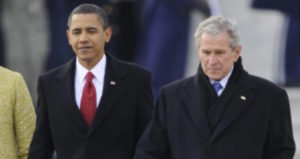
In recent speaking engagements
on the same day,
Presidents Bush and Obama reminded us: “This is not normal.”

So What?
Now, before we panic, all of this analysis doesn’t have to be a harbinger of doom. It might be that, but it could be an opportunity for America to reshape itself into a different future. Let’s not forget that such “reshapings” have happened before — some with positive results and some not so much —the 1860s, the 1910s/20s, the 1940s, the 1960s, the 1980s, are examples. Those who were paying attention during those times (and writing about it) have told us that the outcomes were not easily predictable nor were they easily controllable by those in power. But one lesson to be learned from all of that history is that those who care enough to participate can have an influence on the direction America will take. Those who simply stand and watch, will probably be surprised at how unimportant their views were. As the Winter Solstice reminds us that the world is ready to remake itself once again, those who try to influence the outcome, especially in concert with others, may be surprised at how much influence is possible. –> This is not new.
And Now?
So, after the “reflection and review” that the Winter Solstice evokes, does the coming sunlight bring with it a call for action? But what kind of action and by whom? In a Democracy, we are told that our voices are the most effective tools. And in a Republic, we select representatives to increase the reach and volume of our voices. So, it would make sense to let those representatives know what kind of action we intend.
Some sample pathways:
https://www.feinstein.senate.gov/public/
https://www.harris.senate.gov/contact/
https://swalwell.house.gov/
https://govapps.gov.ca.gov/gov39mail/
Finally, I’d like to cite two more writers who have offered useful advice for this time. One is poet Annie Finch, the author of “Winter Solstice Chant.” In an interview, she reminds us of the two-step process of moving from darkness to light: “If you don’t experience the darkness fully, then you are not going to appreciate the light.” The other — a well-known and eloquent gentleman advised us once to “become the change we seek.” Might be worth a try in the new year.
![]()
Grace — 2017

“I do not understand the mystery of grace — only that it meets us where we are but does not leave us where it found us.”
— Ann Lamott
Click here to download a PDF of this post: Grace_ConVivio_2017_LITE
= = = = = = = = = = = = = = = = = = = = = = = = = = = = = = = =
Extending a Tradition of Grace
On Saturday, December 9, 2017, Gretta and I continued our twenty-year tradition by attending an event called “A Cathedral Christmas.” It is an annual Christmas concert of the Men’s and Boy’s Chorus, orchestra, and pipe organ, at Grace Cathedral in San Francisco.
I have written about this annual event before on ConVivio (notably in 2009 and 2015), and each time my goal was to shine a light on the powerful effect it always has on our experience of the holiday season. For us, the tradition starts with its magnificent music, having the ongoing effect on the lives of real people of all types that thoughtful art can have. In addition to the music itself, the venue — Grace Cathedral on California Street in San Francisco — contributes its powerful presence and enduring heritage to our encounter with the holiday season. And last but not least, this event intentionally involves itself in the tenor of the times in which we live — for Grace Cathedral has long served to participate in the life of its broad Bay Area community not only with its Christian Anglican traditions, not only with its music, but also by contributing to the everyday issues and struggles, both diverse and universal, that affect the lives of our society.
The Venue: Grace Cathedral
 Grace Cathedral has long committed itself to be a house of prayer for all people and a place where all are welcome — prayerful or not. I observe that those two commitments set it apart from many other institutions that seem on the surface to be similar. Over the years I have noticed that the cathedral community provides many gifts, usually without a lot of fanfare, to people of all kinds whether they are part of their faith community or not. I learned, for example, of the hundreds of homeless who have been housed in the cathedral basement over the years. It also has lived up to a well-earned reputation for welcoming members of society who have not always felt welcome elsewhere in the Bay Area and the nation.
Grace Cathedral has long committed itself to be a house of prayer for all people and a place where all are welcome — prayerful or not. I observe that those two commitments set it apart from many other institutions that seem on the surface to be similar. Over the years I have noticed that the cathedral community provides many gifts, usually without a lot of fanfare, to people of all kinds whether they are part of their faith community or not. I learned, for example, of the hundreds of homeless who have been housed in the cathedral basement over the years. It also has lived up to a well-earned reputation for welcoming members of society who have not always felt welcome elsewhere in the Bay Area and the nation.
Left: “Ghiberti’s Doors,” copies of the 15th-century originals residing in Florence, reveal a welcoming heritage — the originals started the Italian Renaissance in bringing great art to everyday lives of real people.

Grace Cathedral: inside and out

Grace Cathedral can get colorful: inside and out
The Music
Usually, the Christmas concert focuses on two principal themes: 1) the joy associated with the birth of The Child — represented by well-known Christmas carols in the first and third segments of the performance — and 2) the peacefulness settling over the ‘Holy Land’ and the world, associated with the hope for peace that The Child would bring – represented by classic choral and orchestral music performed with sweetness and passion throughout the concert. The signature piece of the Grace Cathedral Music Ministry has always been a tune by Hugh MacKinnon called “Sleeps Judea Fair.” Gretta and I always look forward to this tune, in the final segment of the concert, as the highlight of the season. The lyrics and the slow, soft harmony of the voices recreate the joy and peace we expect from the season.

Settling into our usual seats at the acoustic center of the cathedral — one of America’s premier acoustical rooms — the expressions on the faces of the stained-glass figures of the saints all around the cathedral contributed to the warmth, peace, and harmony that we had come to expect. I opened the printed program and was pleased to find our favorite piece listed near the end of the program along with a few others I did not recognize.
The first segment of the concert contained the familiar choral pieces we had come to expect – like John Wade’s 18th-century carol “O Come, All Ye Faithful.” When the Men’s and Boys’ chorus left the altar for an intermission, the organ solo began. The organist’s right hand began by trying to play the familiar tune of “Christ Is Born Today,” while the left hand alternately ignored and ‘drowned out’ that melody with some deep, dissonant, and unfamiliar chords. I took this to represent the deep discord that “The Holy Land,” and much of the world, has been experiencing. We heard in the news that morning of the president’s announcement regarding the status of Jerusalem, which sparked some violent protests there and in Bethlehem itself.
Message received.
The peacefulness that The Child brought to this region centuries ago is not working out so well. I suppose this concert, to be true to its themes, needed to reflect that unrest and discord alongside the hope for peace and harmony that is the focus of so many of our prayers and greetings during this holiday season.
Then, after applause for the organ soloist, the singers returned for the final segment that traditionally conveys the message of peace and serenity culminating in their signature piece, “Sleeps Judea Fair.” It was as beautiful, soothing, and peaceful as always, offering a wish for “grace” — to Judea, to the world, and to us:
“Let the Christ Child, meekly smiling, infant wise all woe beguiling
Grant His grace to thee.”
–> Listen to it here — recorded live in Grace Cathedral:

An Acknowledgement of the Times in Which We Live
After we were treated to that reward, the Episcopal Bishop of California, Rev. Marc Andrus, thanked us all for being there and gave us some words of wisdom for the season. His ministry, consistent with the ongoing mission of Grace Cathedral, is focused on the key issues of our time and place: peace and justice, immigration reform, climate change, civil rights for LGBT persons, and health care. On this night, he reminded us that these are hard times and drew a remarkable analogy for this season. He suggested that “our brothers and sisters of the animal kingdom” tend to slow down and prepare to go to sleep as the cold days and nights of winter approach. We humans, on the other hand, are called to do something different — it is a time for us to wake up, become more energetic, and do more of the things that need to be done, especially for others. He then suggested some specific ways we can do that in our own communities.
With that, the concert concluded with its final choral pieces. The lyrics of one of those, “A Stable Lamp is Lighted,” accompanied by the orchestra and organ, provided the stark reminder that our joy must be tempered with the reality of the hard times yet to come for the child born this day and, perhaps, for us all. Just before the finale, the voices intoned this piece of reality:

So then, we could celebrate: “Hark! The Herald Angels sing: Glory to the newborn king.”
The Message — More than hope for “Grace” during hard times
As we walked out of the cathedral on that beautiful December night, our world remains a place of suffering and danger, walking right alongside an enduring hope and optimism for which we Americans are famous. The message: we are right to be optimistic and hope for peace, harmony, and relief from suffering; but it is not enough to merely admire the problem and hope for the best. Rev. Andrus suggested that we must wake up and become active. We can start in our own families, neighborhoods, and towns, giving each other what we need, when we can, and contributing to organizations that do the work we can’t do on our own — some examples: Planned Parenthood, Reach Out and Read, Boys and Girls Clubs, Sierra Club, Valley Humane Society, American Civil Liberties Union, KQED, The Kidney Foundation, Grace Cathedral, and so many others. All are hopeful, optimistic efforts. We can make a difference, starting right here.
![]()
Yosemite: Change Revisited
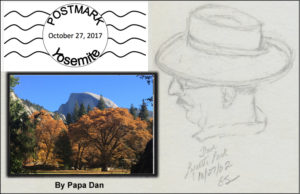
“It is easier to feel than to realize,
or in any way explain, Yosemite’s grandeur.”
— John Muir
“What a treasure to pass on . . .
(but make sure you bring your lunch).”
— PapaDan
Click here to download a PDF of this post:Yosemite, October 17, 2017
= = = = = = = = = = = = = = = = = = = = = = = = = = = = = = = = = = = = = = = =
Yosemite, October 17, 2017
 Sitting here in the middle of a meadow, looking up at Yosemite’s venerable Ahwahnee Hotel, it seems different in some way. Since you probably know some of the history of this place, you may ask with raised eyebrow and derision in your voice “Aw-come-on-now, what could possibly be different?” You might point out a few things like: the iconic stone-and-wood edifice in front of me has looked pretty much the same since it opened in 1927; the granite mountain, El Capitan, to the left of this view has looked much the same for, oh, 50,000 years or so; and the squirrels and blue jays who live here have been scurrying and squawking like this since the glacier melted — so, what could possibly be different?
Sitting here in the middle of a meadow, looking up at Yosemite’s venerable Ahwahnee Hotel, it seems different in some way. Since you probably know some of the history of this place, you may ask with raised eyebrow and derision in your voice “Aw-come-on-now, what could possibly be different?” You might point out a few things like: the iconic stone-and-wood edifice in front of me has looked pretty much the same since it opened in 1927; the granite mountain, El Capitan, to the left of this view has looked much the same for, oh, 50,000 years or so; and the squirrels and blue jays who live here have been scurrying and squawking like this since the glacier melted — so, what could possibly be different?
I’ll have think about it — you’ve asked a big question that demands a big answer; but I, of course, have a small answer:
—> It’s quiet. Nearly silent, actually. THAT’S what’s different.
Gretta and I come to Yosemite every April, for our anniversary, and one thing is a constant — Yosemite Falls is always flowing with its usual vigor. The sound is not merely of running water, but of chunks of ice and fragments of logs from the high country crashing down on the rock formations between the peak of the falls and the valley floor. All of that — plus the constant rushing of the water — creates a polyphonic orchestration complete with percussion, and you can hear it everywhere in Yosemite Valley from Half Dome to El Capitan to Glacier Point.
But, in October (for our second yearly visit), North America’s tallest waterfall is completely dry.
And silent. And, the silence of October is more noticeable than the sound of April. 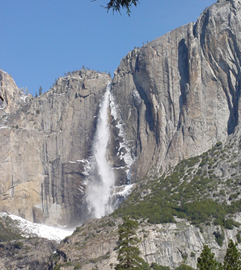
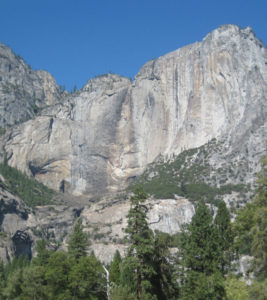
Upper Yosemite Falls (April) Upper Yosemite Falls (October/Dry/Silent)
But, before I claim that everything else around here is permanent, I come to realize that much has changed, and is changing all the time. Some of it matters, and some doesn’t.
The Water
• The water that feeds the Merced River from the opposite side of Yosemite Valley, across from Yosemite Falls (see the images below), originates at the granite dome of Liberty Cap, thunders down at Nevada Falls, sits awhile in the Emerald Pool, rumbles down at Vernal Falls, and ends up meandering through the valley floor in the Merced River. As the seasons change, that river trickles between the boulders at its low point here on October and then swells to a wide, white-water torrent in April. So, at least that much changes; but a wise observer might point out that all of this ebb and flow, the meandering and the raging, the silence and the music of the falls form a never-ending constant cycle in their seemingly eternal alternation between the extremes of life in this valley among these mountains. Yosemite has been here a very long time — longer than the life-span of humans on this planet — and the forces at work here seem to be eternal; BUT those forces are carving a work of art. Each time you look, if you are paying attention, it never looks quite the same as it did the last time you looked.



Nevada Falls Top of Vernal Falls/Emerald Pool Vernal Falls
The Granite
• Today, El Capitan slopes at a slightly different angle since last month when a slice of granite the size of an apartment building cracked and crashed down on one of its outcroppings and scattered giant boulders, many the size of automobiles, around its base. Rock falls happen all the time in Yosemite but they are seldom fatal (as this one was) and often not especially noticeable — unless you consider that this entire valley and its surrounding mountains were carved and shaped over thousands of years in precisely this manner. So, Yosemite changes its shape pretty much everywhere you look and pretty much all the time.
The Colors

The colors speak for themselves. BUT, some of us have tried to speak for them — and maybe overdone it in the attempt, or not – like our old friend Mark Twain who tries to give us a glimpse, in words, of trees in the fall that change “from green to red, from red to green, and green to gold. The tree becomes a very explosion of dazzling jewels; it stands there, the acme, the climax, the supremest possibility of art or nature, of bewildering, intoxicating, intolerable magnificence. One cannot make the words too strong.” Or so he said.
Twain’s words appeared in the New York Times in 1876, not as evidence of change, but as evidence of permanence — describing something that has been repeated every year since long before humans were here to observe it. And here, now, in Yosemite, we see it once again.
Trivial Change
Now, if we’re going to make a list, some things HAVE changed here in Yosemite, just in the decades we have known it; but those are caused by humans and, therefore, less important:
• The Ahwahnee Hotel has been renamed The Majestic Yosemite Hotel. Why? — because the previous management of the hotel claims to “own” the name “Ahwahnee” after a coupla decades of association with it. The silliness of that view comes to light when you consider that the hotel was named for the Ahwahneechi Tribe who were associated with this part of the valley since about 600 years ago — long before the United States National Park Service granted a contract for restaurants and hotels (OK, long before the United States existed). So, Gretta and I still call it by its rightful name — The Ahwahnee Hotel.
• The Ahwahnee cocktail lounge, which used to serve excellent food all day long, now serves, well … OS (i.e., other stuff). We tried it for breakfast this time … I didn’t know it was possible to screw up yogurt and granola, but now I know. It has been our habit to enjoy a cocktail and tasty appetizers here in the late afternoon. The “cocktail” part endures as it should but the “tasty appetizer” notion is missing. It also used to feature a delightful piano player in the evening (he played everything from classics to smooth jazz to show tunes to classic rock — request almost anything, he knew it). Now the piano is gone to make room for three more tables and a sound system plays, well … OS.
• The Ahwahnee main dining room used to be a 5-star restaurant that attracted outstanding chefs. Now it is just a lovely high-ceilinged, grand building with an OK restaurant surrounded by breath-taking views, pouring from a mediocre wine list, and serving … well, you know, OS. It isn’t even the best restaurant in this valley.
• Oh, and there’s Degnan’s Deli, which used to be an ideal spot to interrupt a day of hiking by ordering a hand-made sandwich, salad, or soup, crafted with fresh ingredients. Now, it is dominated by a display case full of pre-packaged “gas-station-sandwiches.” And they’ve innovated: you can stand in line to order and pay using computerized kiosks and then stand in another line to pick up your order. This “innovation” succeeded in eliminating four employees who used to make your lunch to order from fresh ingredients and take your money at enough cash registers to avoid standing in line. You can still sit at their outdoor stone tables looking up at a stunning view of Glacier Point, but … my recommendation is that you bring your own lunch. Yes, it’s changed.
So, now I’ll stop whining
and tell you why we must continue to return here twice a year.
We come back for the many wonderful things that remain the same here in Yosemite Valley. Here are a few of those in the words of some of our friends:
• Words from Teddy Roosevelt: “There can be nothing in the world more beautiful than the Yosemite … and our people should see to it that [it] is preserved for their children and their children’s children forever, with [its] majestic beauty unmarred.”
• Words from John Muir: “Climb the mountains and get their good tidings, Nature’s peace will flow into you as sunshine flows into trees. The winds will blow their own freshness into you and the storms their energy, while cares will drop off like autumn leaves. As age comes on, one source of enjoyment after another is closed, but nature’s sources never fail.
• John Muir again: “It is easier to feel than to realize, or in any way explain, Yosemite’s grandeur. The magnitudes of the rocks and trees and streams are so delicately harmonized, mostly hidden.”
• Frightening words of warning from NYT columnist Nicholas Kristof: “I can’t help thinking that if the American West were discovered today, the most glorious bits would be sold off to the highest bidder. Yosemite might be nothing but weekend homes for internet tycoons.”
• Words from Robert Redford: “I spent two summers working at Camp Curry and at Yosemite Lodge as a waiter. It gave me a chance to really be there every day – to hike up to Vernal Falls or Nevada Falls. It just took me really deep into it. Yosemite claimed me.”
• Words from Dave Brubeck: “I used to take my mother to Yosemite. When got my driver’s license, that’s where she’d want to go, so I’d go take her there for two weeks.”
• Words from John Garamendi: “Maybe you weren’t born with a silver spoon in your mouth, but like every American, you carry a deed to 635 million acres of public lands. That’s right. Even if you don’t own a house or the latest computer on the market, you own Yosemite, Yellowstone, the Grand Canyon, Golden Gate National Recreation Area, and many other natural treasures.”
• Words from Ansel Adams: “Yosemite Valley, to me, is always a sunrise, a glitter of green and golden wonder in a vast edifice of stone and space.”
• More from John Muir: “During my first years in the Sierra, I was ever calling on everybody within reach to admire them, but I found no one half warm enough until Emerson came. I had read his essays, and felt sure that of all men he would best interpret the sayings of these noble mountains and trees. Nor was my faith weakened when I met him in Yosemite.”
• And, finally, from PapaDan: “Some years, one or more of our sons bring their families up here during the same week we visit, and we have the privilege of taking our grandchildren to the bank of the Merced River (below, left) or up to the base of Yosemite falls (below, right) and watch them enjoy the spectacle in amazement. What a treasure to pass on to the next generation!”
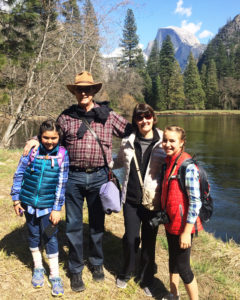

We’ll be back in April!
If you’re interested, click to take a look at a previous post on this topic:
“Of Permanence, Change, and a Sense of Wonder“
Kristof’s Poetry Contest
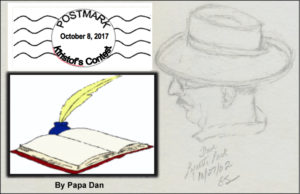
“I would like to invite you to submit entries
to a new poetry contest meant to capture
the ethos of our times in verse.
… Let’s try to examine this historical moment
through a new prism” with this poetry contest.
— Nicholas Kristof, September 15, 2017
Click here to download a PDF of this post:
Kristoff_Trump_poetry_contest_SIX_Oct_2017
= = = = = = = = = = = = = = = = = = = = = = = = = = = = = = = = = = = = = = = = = =
On September 15, Nicholas Kristof invited readers to submit entries to a new contest in the NYT — his invite: “Announcing a Trump Poetry Contest” is found at: https://kristof.blogs.nytimes.com/2017/09/15/announcing-a-trump-poetry-contest/
Below are six entries sent to the contest by two local authors:
myself and Lauren De Vore.)
Below are Dan’s three entries to Kristof’s New York Times “Trump” poetry contest.
After those are three poems submitted by Lauren De Vore. As of October 8, it is unknown if any of these six poems were selected to appear in The Times. We’ll see …
• Consistent with the topic, my intent was to reflect on a distortion of the Presidency with a distortion of the sonnet form. Like classic sonnets, my entries are written in iambic pentameter, but, unlike those others, each has 20 lines (4-7-5-4) and no rhyme, just like this Presidency.
• Another objective: to fulfill contest requirements without mentioning a certain name.
— PapaDan
= = = = = = = = = = = = = = = = = = = = = = = = = = = = = = = = = = = = = = = = = =
What This One Hasn’t Learned
By Dan Sapone
A president presides but does not claim
all triumphs and achievements for himself.
He praises goodness that we’ve all achieved
together to become the change we seek.
My Dad’s advice: “Give credit and take blame”
was offered free to any who would lead.
“Lift up the folks around you when you speak.
Say not ’I’m great’; for if you are, the world
will tell YOU so; and you can humbly say,
“It’s WE who make the world a better place,
together all,” he adds, “Unless we don’t … ”
For then, true leaders know to change the path
and say, “Together, follow me this way,
and bring with us those needing helping hands,
for hands we have; and other hands we’ll need
when harder work will be required of us.
D’yathink that HE can learn what those before
him knew and brought with them to leadership:
that greatness lies only in “Us” and “We”
and not at all alone in “I” and “Me?”
= = = = = = = = = = = = = = = = = = = = =
Dancing on the Edge at the End of the World
By Dan Sapone
Poets’ve said a lot ’bout how it ends.
Said one: “Some say in fire, some say in ice.”
Another wrote we should expect the sound
to be “a whimper” only, not “a bang.”
So, on the edge, so near the end, we dance.
We’ve grown up thinking of a sudden end
to all we’ve known — a blast, a mist, then gone.
But those who watch may notice that a slow
decline precedes the end. A lack of care,
neglect of values writ in stone by those
who came before. They warned us loud and clear:
“Take care of those who need — we’re all the same.
Become the change we seek. Beware of those
who shout the loudest, those who wish to rise
by pushing others down.” But we forgot,
and looked away, while demagogues arose.
And so we dance, here on the edge. While some
will quickly pay the price of our neglect,
it’s all of us, in time, who’ll see it end.
Yes, all of us, in time, will see it end.
= = = = = = = = = = = = = = = = = = = = =
“In a democracy people get the leaders they deserve.” — Joseph de Maistre
(popularly misquoted as having originated with Alexis de Tocqueville and Abraham Lincoln)
The Leaders We Deserve?
By Dan Sapone
A coupla hundred years ago, a few
observers offered this enduring truth,
that over time, “In a democracy,
the people get the leaders they deserve.”
That begs some questions those of us who vote
must ask ourselves: Is THIS what we deserve?
What earned us this foul-mouthed incompetent
who represents us all around the world?
Can we of right say loudly “Shame on him”
or must we own it and say, “Shame on us?”
How can we know what is it we deserve?
Do we disparage those unlike ourselves?
Or welcome others with our minds and hearts?
Do we speak of each other with respect?
Do we contribute to a common good
to help make us into a better us?”
Perhaps our leaders mindlessly reflect
the image that our honest mirror shows.
Perhaps we must admit the painful truth:
We got the leaders who are just like us.
= = = = = = = = = = = = = = = = = = = = =
Lauren de Vore’s three submissions to Nicholas Kristof’s Poetry Contest
Below are the poems Lauren submitted. In announcing the contest, Kristof asked for poems that “capture the ethos of our times” and noted that “if you can make us feel better, or laugh, or think more deeply, so much the better.” As much as I would have liked to been humorous, I do not find the current ethos to be such that verse can make anyone feel better. Rather, my poems give voice to my disgust and despair over these Trumpian times as well as the moral responsibility those of us who disagree with the current Administration and Congress have to stand in resistance and as witness to this dangerous and damaging period in our nation’s history. As for thinking more deeply, by all means do so, but not at the risk of sinking into an abyss. One must have faith in the ability to change things for the better in order to fight for the better.
Directive for the 21st Century
by Lauren de Vore
Be not numb. Turn not away. Someone must bear witness.
Hone your nerves that you may be shocked, offended,
Outraged by the sandbox-bully meanness,
By the lies and the flag-waving god-invoked hate,
That you may be horrified, anguished, incensed
In the face of act upon act of violence
And the blood-lust glee of the perpetrators.
Shrug not. Retreat not into cynicism.
Someone must feel the pain.
Though you march not on the front lines of protest
Against those who would destroy
What they envy, what they fear
And torment the weak simply because they can,
Avert not your eyes and hope it will all go away.
Rather, stand unblinking,
Witness to the rending of a nation.
And when the land lies blood-soaked and torn,
Like a troubadour of old, tell the tales of the slaughters
And the resistance, of the villains and the heroes,
That some who survive the madness may listen, may learn.
Be not numb. Turn not away. Someone must bear witness.
* Written in response to “Truth, Lies and Numbness,”by Roger Cohen, The New York Times (August 24, 2017).
= = = = = = = = = = = = = = = = = = = = =
Masquerade
by Lauren de Vore
Drivel passing as profound Sound bites
proclaimed as wisdom Bluster and bullying
ranted as righteousness Lies hustled as
truth Hatred spewed as patriotism And
bigotry cloaked in the robes of faith
Even as Tolerance is scorned Compassion
mocked Otherness reviled Restraint and
reason Spurned and derided As weakness
As foolishness and naiveté
Yet who are the naïve The foolish, the weak
But those who refuse to see This masquerade
for the farce it is And wrapping themselves
in spangles and stripes Dance on the precipice
Of our undoing
= = = = = = = = = = = = = = = = = = = = =
AWOL
by Lauren de Vore
There is no “i” in country
There is no “u” in nation
There is no peace in poverty
Or hope in homelessness
No tolerance in tea parties
No grace in zealotry
There is no trace of humbleness
In hubris, not a shred
Of decency in demagogue
What future is there for
This grand experiment that’s U.S.
When hate and blood and fear
Run rampant in the streets
When politicians sabotage
The land they claim to serve
And super-PACs buy votes and laws
To feed their appetite for ever more
When body politic prides ignorance
And presidents toss covfefe
Into the swirling winds
But there’s an “I” in nation, “you” in country too
Perhaps one day the “S of A” will find again its “U”
= = = = = = = = = = = = = = = = = = = = =
A Gratitude Attitude
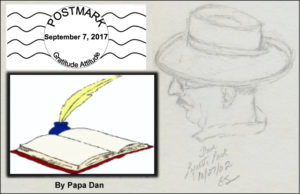
“Thank you, God, for this good life and forgive us if we do not love it enough.”
— Garrison Keillor
“On the off chance
that you won’t live forever,
maybe you should try to be happy now.”
— “Network News” (HBO)
Click here to download a PDF of this post: ConVivio_Gratitude_FINAL_Sept7_2017,pdf
= = = = = = = = = = = = = = = = = = = = = = = = = = = = = = = = = = = = = = = =
Let’s admit it — Americans are having quite a lot of anxiety these days. We could list the reasons, but they are in the news every day; and it is not my intention to trouble you with all of that. I’m thinking that we may have something more useful to do today. I grew up in a generation that acquired the confidence, or at least the suspicion, that we, collectively, have what it takes to solve difficult problems and improve our lives and the lives of others. We have been taught to believe that we can make a lot of progress — in economics, technology, and society. I will speak for myself and say that I was taught to believe in that progress by my parents, teachers, and leaders. For me, that body of belief is summarized in the distinctly 21st-century assertion:
“Yes, we can.”
But, today, we’re not so sure. Such optimism is feeling more and more like hard work.
That “dampening” of our collective self-confidence seems to have happened in a relatively short time. I suppose that uncertainty leads me to look back on my education for an alternate strategy. Just thinking out loud here — I was taught that “despair” was a personal failure. So, “giving up” was not acceptable. I was also taught that lashing out in anger against things I don’t like is not what reasonable, thinking, feeling humans should do. (I was taught that standard by observing what happened to the bully on the fifth-grade playground, when Sister Bernadette hauled him off to the principal’s office when he got too pushy on the tetherball court.) Also, somewhere in my Jesuit education back in the early 1970s, I recall hearing the saying:
“God, grant me the serenity to accept the things I cannot change,
courage to change the things I can, and wisdom to know the difference.”
This is part of what is known as “The Serenity Prayer” written by an American theologian named Reinhold Niebuhr back in the 1930s and passed on to me in a lecture by a Jesuit professor, Father Tennant Wright, at Santa Clara University in 1971. It is typically offered as a prescription for happiness in “the next life” if we accept hardships and trust in God. My observation, however, — at the urging of that same professor — suggested to me that we have opportunities, and responsibilities, to make a difference in “this life” that should not be ignored.
So, what does it mean? Is there a way to bridge the gap between “Yes, We Can” and “Serenity?” Can that “bridge” have some effect on the current anxiety I mentioned?
The Physiology of Gratitude
Really?! Physiology? OK, so I stumbled on a chapter in a book called “The Gratitude Diaries,” by Janice Kaplan. At first glance, as I saw it on the library shelf, I expected it to be mostly about talking yourself out of feeling bad. But, as I looked into one chapter — you know how you grab a book off the shelf and open it to a random page to see what’s inside — I discovered something else. On page 179, I found some very mundane and familiar medical science associated with stuff like bacteria, the body’s immune response to bacteria, the functioning of neurotransmitters, and how white blood cells swarm to the site of an infection and attack the problem by “gobbling up bacteria.” In doing that, the white blood cells leave behind inflammation, which can become dangerous in itself. You knew that; BUT scientific studies aimed at understanding inflammation have uncovered some unexpected and intriguing connections.
So, here’s the really interesting part — turns out that the immune system doesn’t ONLY respond to “germs,” it may also respond to emotions. Kaplan reports that a couple of researchers at Johns Hopkins University and Georgetown’s National Institute of Mental Health observed that worry, anger, or fear activates those same white blood cells. Even though they don’t have anything specific to attack, they leave a trail of dangerous systemic inflammation.
–> Long-story-short — one conclusion from their studies: expressing gratitude could actually inhibit that systemic inflammation effect and prevent our immune systems from causing our bodies to react harmfully to fear and worry.
“A sad soul can kill you quicker, far quicker, than a germ.” — John Steinbeck
SO, the anxiety many of us are feeling about the bad news all around us can actually do physiological damage and inhibit our ability to cope with the world, to make good decisions, and to experience happiness. People are beginning to notice. Friends of mine tell me that they have been trying to avoid watching “the news” because they don’t like the way it makes them feel. Turns out that the intentional expression of gratitude for the goodness we see around us and the people who bring it to us — in place of focusing on the troubling news — can demonstrably counteract those very real effects on our health. The operative word for this effect is healing.
The Gift of a ‘Gratitude Attitude’
Let’s admit it — we have much to be grateful for. The very fact that today’s news is disappointing confirms that we have experienced better; we have been exposed to good people doing generous and kind things for us and for others, both locally and elsewhere. We have enjoyed periods of relative stability and we have survived hard times, both individually and collectively. While we have endured troublesome people (you know who they are), we have also enjoyed people who have lifted us up and brought us kindness when it was needed (and you know who they are). In fact, there have been times when WE have BEEN those people for others. Science tells us that there are positive physiological effects of intentional gratitude; AND we have seen that serving as an example of gratitude to others can make a difference for us all.
“At times our own light goes out and is rekindled by a spark from another person. Each of us has cause to think with deep gratitude of those who have lighted the flame within us.”
— Albert Schweitzer
Heck, some of you have done that for me — and you know who you are — so, thank you.
Obligations?
So, if we acknowledge that focusing on “the bad news” can do real harm, does that knowledge carry with it obligations to each other — and to those who come after us?
If future generations are to remember us more with gratitude than sorrow, we must achieve more than just the miracles of technology. We must also leave them a glimpse of the world as it was created, not just as it looked when we got through with it.
— Lyndon B. Johnson
I have to acknowledge that my generation brought us to the “bad news” state we are in. Some might suggest that this conundrum — the apparent tension between “Yes, We Can” and “Serenity” — strains our impulse to resist the “bad news,” and by resisting, risk allowing that resistance to dominate our daily lives. Shouldn’t we resist? Isn’t that part of the “Yes, We Can” confidence we were taught to have?
Let me suggest that it is not a cop-out to say we must do both — simultaneously. I agree with the urgency of resistance — staying informed of the paths our nation is traveling, putting ourselves in a position to make a difference, contributing to organizations that can help those who are harmed by the “bad news,” and supporting those who want to push progress forward (yes, we call them “progressives”). At the same time, the science suggests that we must support each other by offering our “Gratitude Attitude” wherever we can. I must remind myself, in spite of my disappointment with “the bad news,” that I have a good home in a good community, a family full of successful and talented grown children and smart and curious grandchildren, and a wife who shares my gratitude and appreciates “us.” I have friends who demonstrate their gratitude for the goodness they have and for the time we spend together. I enjoy hearing their expressions of gratitude for their own good lives. I submit that we have an obligation to share our expressions of gratitude with the people in our lives — the people we know well and those we meet along the way. They need to hear our gratitude just as much as we need to hear theirs. OK, it’s hard to do both things at once — to “resist” while also maintaining a “gratitude attitude.” But we must, because …
“Yes, we can.”
America’s Great Anniversary Festival
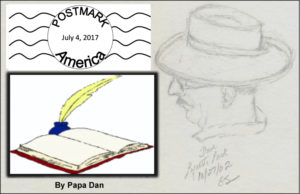
“It ought to be solemnized with Pomp
and Parade, with Shows, Games, Sports,
Guns, Bells, Bonfires and Illuminations
from one End of this Continent to the other from this Time forward forever more.”
— John Adams, July 3, 1776
Click here to download a PDF of this post: The_Fourth_2017
= = = = = = = = = = = = = = = = = = = = = = = = = = = = = = = = = = = = = = = = = =
From a letter from John Adams to Abigail Adams, July 3, 1776
 “The Second Day of July 1776, will be the most memorable Epocha, in the History of America. … I am apt to believe that it will be celebrated, by succeeding Generations, as the great anniversary Festival. It ought to be commemorated, as the Day of Deliverance by solemn Acts of Devotion to God Almighty. It ought to be solemnized with Pomp and Parade, with Shows, Games, Sports, Guns, Bells, Bonfires and Illuminations from one End of this Continent to the other from this Time forward forever more. …You will think me transported with Enthusiasm but I am not. — I am well aware of the Toil and Blood and Treasure, that it will cost Us to maintain this Declaration, and support and defend these States. Yet through all the Gloom I can see the Rays of ravishing Light and Glory. I can see that the End is more than worth all the Means. And that Posterity will tryumph in that Days Transaction, even altho We should rue it, which I trust in God we shall not.”
“The Second Day of July 1776, will be the most memorable Epocha, in the History of America. … I am apt to believe that it will be celebrated, by succeeding Generations, as the great anniversary Festival. It ought to be commemorated, as the Day of Deliverance by solemn Acts of Devotion to God Almighty. It ought to be solemnized with Pomp and Parade, with Shows, Games, Sports, Guns, Bells, Bonfires and Illuminations from one End of this Continent to the other from this Time forward forever more. …You will think me transported with Enthusiasm but I am not. — I am well aware of the Toil and Blood and Treasure, that it will cost Us to maintain this Declaration, and support and defend these States. Yet through all the Gloom I can see the Rays of ravishing Light and Glory. I can see that the End is more than worth all the Means. And that Posterity will tryumph in that Days Transaction, even altho We should rue it, which I trust in God we shall not.”
OK, so John got it sorta wrong. He figured that America’s “Great Anniversary Festival” should be celebrated on July 2nd, the day the unanimous vote was taken in the Second Continental Congress in Philadelphia. But, since July 4th was the day the Declaration of Independence was printed, distributed, and read on street corners throughout the colonies, and, well, that was the date at the top of the paper, so … here we are.
Happy Fourth of July!

And there’s the famous John Trumbull painting of the ceremony in which the members of the Second Continental Congress signed the declaration on July 4th –> nope, that didn’t happen either. Most members signed the paper on August 2nd at the Pennsylvania State House. Some signed on other dates. The New York delegation was given permission to sign the document by their legislature on July 15th (since NY had abstained on July 2nd). Some signers hadn’t been elected to Congress yet in July.
But, OK, the document we have today (a copy is framed over my workbench) has 56 signatures and it’s dated July 4, 1776. Done and done. A result, at least, of some powerful storytelling.
Happy Fourth of July!

Today, July 4, 2017, we celebrate what has been called “The Great Experiment in Democracy on the North American Continent.” We’ve been working at this experiment for 241 years and it
has required a tremendous amount of sacrifice and quite a lot of very serious compromises,
some we can be proud of, some not so much.
The signers of the document, rich, white, male property owners (many slave owners) with much to lose, pledged to support the declaration with “our lives, our fortunes, and our sacred honor.” The late eloquent American journalist Paul Harvey (Presidential Medal of Freedom, 2009), tells the stories of what those signers had to do to support that pledge. Give it a look; much of it is true and all of it is moving.
https://www.youtube.com/watch?v=SRSHA7F3mIw
———————
So, how’re we doin’?
America had a population of 2.5 million in 1776 — today we number about 326 million — and each of us has a role to play. The challenge of representative democracy as it has come down to the latest generation of Americans has required an evolving recipe of leadership and followership. We expect our leaders to represent us well on national and international stages; we judge them every day on their ability to make us proud, keep us safe, and promote the values we claim to believe in. We, in turn, ask each other to support those values as we exercise what the Declaration of Independence enshrined as our “inalienable rights”: “Life, Liberty, and the Pursuit of Happiness.” Our common expectation, or hope, is that we will find ways to pursue those inalienable rights without stepping on the rights of others; AND we agree that our government will protect the ability of each of us to exercise those rights — or at least not stand in our way.
So, what do we do if we find ourselves disappointed with the outcome of those agreements
– disappointed with the “great experiment in Democracy” on this continent, in our town, in our neighborhood? And, let’s be frank, we often — often — find ourselves disappointed in our leaders, our fellow citizens, and at times, perhaps, even our own contributions to that agreement. What do we do? What should we do? What is expected of us when we expect more? Truth is, few of us will be required to give what the signers of the declaration had to give, as Paul Harvey described; some will, but relatively few. What is our responsibility when we decide that our leaders do not represent our values and ourselves the way we expect? Is it sufficient to carry signs in crowds that express our disapproval? I think most of us believe that more is expected. After all, we’ve got it pretty good, most of us. What’s the line in the book — “Of those to whom much is given, much is expected.” Does the legacy passed on to us by our, largely immigrant, forebears require some effort to carry on the values that were passed on to us?
The closer we look at our history — as we do when we watch the musical play “Hamilton” or “1776” on our theater stages — we find that the founders were, for the most part, fairly ordinary, imperfect people. Not granite statues. Sort of like the rest of us but, perhaps with greater ambition and maybe some particular talents that got them into positions of responsibility. Maybe they did something when they saw a need. Maybe their motives were good, maybe not. Many of us decide: “I think I can find ways to contribute, but they don’t seem sufficient.” For many, on both sides of a number of challenges that we face, we want something to change. I don’t have the wisdom or talent of those who have risen to positions of leadership over our lifetime; but I can recognize some of that wisdom when I see it. I recall many words of wisdom that have been passed down to me — all the way from “nothing to fear …” to “ask not …” to “ask why not,” but, for today, these come to mind: “we must be the change we seek.”
So, here we are. How do we “become the change …” ? I’m not sure any of us can make it happen by ourselves. In honor of “America’s anniversary festival,” we’ve got to figure it out together. Time’s a wastin’ …
For further reading: https://www.nytimes.com/2017/06/30/opinion/fourth-of-july-stephen-fry.html
![]()
“The Summer of Love” — 1967

“The Summer of Love” — 1967:
More Than A Summer
“Do you believe in Rock & Roll?
Can music save your mortal soul?
Can you teach me how to dance real slow?”
— Don McLean (from “American Pie”)
Click here to download a PDF of this post: ConVivio_Summer_1967_V2
= = = = = = = = = = = = = = = = = = = = = = = = = = = = = = = = = = = = = = = = = =
The Music of My Generation
The great music of my generation reached a climax in 1967. That historic musical moment — widely recognized as the pinnacle of the music of my generation — “warmed up” around 1962-5, reached its peak in the “Summer of Love” of 1967, and culminated in the last few years of the sixties leading to the grand finale: “Woodstock” in August of 1969.
Since most of my generation was in high school at the time, we tend to think of “1967” as the school year that began in the fall of 1966 and ended late in 1967, when my friends and I settled into our senior year. Of course, nothing of cultural importance begins and ends that abruptly and crisply, so we will consider those dates to be approximate. For most of you “of a certain age,” these details may not be new, just reminders of a time in your own life.
It Started With Something New: Buying Records


I began buying vinyl records in 1964, starting with the purchase of my first Beatle album, “Introducing the Beatles,” in January (I still have it) followed a couple of weeks later by “Meet the Beatles” (my son Ben has it). This was an important milestone in my teenage life and the act of buying records quickly became a four-step ritual for me. Here was the pattern:
Step 1. I would hear something exiting on the radio played by one of the two important disc jockeys in the bay area on KYA:
— “Emperor” Gene Nelson was “The Emperor” because his loyal following carried “Royal Commando” cards, he issued his own royal currency (accepted only within “The Empire”), and counted down the “Top Thirty” every Saturday morning.
— “Big Daddy” Tom Donohue advertised acne creams and opened his show with the line: “This is your Big Daddy Tom Donohue. I’m here to clear up your face and mess up your mind.” He co-produced the Beatles last public appearance at Candlestick Park August 29, 1966. About this time, a friend turned me on to something new: FM Radio! KSJO in San Jose played music and said things that could not be heard on AM radio. Tom Donohue pioneered “album-oriented” radio at KMPX FM. We called these FM stations “underground radio.” (Our parents did not listen to these stations.)
Step 2. I would walk uptown to the record store (Don McLean later called it “The Sacred Store” in his classic song “American Pie”). I would ask the lady behind the counter if I could listen to a particular song. She would play it on a turntable if it was on a 45-RPM single (99 cents); but she wouldn’t play an album. In the case of an album, I would inspect the album cover and put it back in the rack for later consideration (albums cost more — initially, a dozen songs for $2.99.
Step 3. After due consideration (usually a day or so), I would walk back to the record store and buy the album (except in the case of a Beatle album — in that case I would have bought it immediately, without question, the first day it was released.
Step 4. As soon as I got home, I would play the entire album from beginning to end without delay or interruption, making judgments about which songs were “hits” and deciding if I preferred one side over the other. Sometimes a friend joined in this part of the ritual. In many cases (again, except for the Beatles) I ended up playing the preferred side almost exclusively after making that judgement.
My Dad encouraged me to buy records, as he had done. I still have his 78-RPM recordings of Cole Porter, Dale Carnegie (“How To Win Friends and Influence People”), and Red Motley (“Nothing Happens Until Somebody Sells Something”), and the soundtracks I heard growing up: “Carousel,” “My Fair Lady,” “Camelot,” and a little classical and opera. I don’t think he really understood my music, but I think he figured that it didn’t do any harm.
Most popular songs, especially in the early sixties, were released on 45-RPM “singles,” with a “hit” song on one side — the “A” side — and usually a throw-away song on the “B” side that would seldom be heard on the radio. The Beatles broke that mold by releasing singles with great songs on both sides. These were almost uniformly three minutes long until July of 1965 when Bob Dylan released “Like a Rolling Stone,” which was more than six minutes long. At first, radio stations played a truncated version; but it quickly became a world-wide hit, broke through that constraint, and we heard it on the radio in its entirety. Why was it such a big deal? Even though it wasn’t particularly ‘musical,’ its “street poetry” described some of the familiar experiences of many young people of my generation and then asked:
“How does it feel?
To be on your own,
with no direction home,
a complete unknown,
like a rolling stone.”
It seemed to touch something deep in the hearts of young people experiencing in the strangeness of growing up in the second half of the 1960s. There would be more to come.
So, What Records Did I Buy?
I bought a few singles; but, after a while, I stopped buying singles and stuck with albums. This change coincided with the trend among popular musicians starting around 1965-66 to record an entire album of their best songs, several of which were “hits” that might have been played on the radio. So, albums contained a lot more storytelling and developed more important themes than songwriters could convey in one three-minute song. Many of the songs of the time reflect the ideas and feelings that mattered to so many of us during that period.
Below is a link to a PDF list of the record albums released during this time that I bought then or over years that followed. It turns out to be a pretty good indicator of what was popular among teenagers, at least in my high school at the time. AND it serves as the musical content that led to the “Summer of Love” in 1967 and other major music events of 1968-9. I bet many of you had these same records or at least remember hearing many of them, either at that time or later –>–>–> AND I’d love to hear from you about the music that was important to you during this time, whether you were alive then or not — since many of you grew up listening to your parents’ records of these songs that they continued to play in later years (as I did).
Records I bought from 1964, with release dates (underlined titles are links):
Click here: Dans_Records_1964-1968.pdf
What actually happened during 1967?
The term “Summer of Love” originated with the formation of the “Council for the Summer of Love” in the spring of 1967 as a response to the convergence of young people on the Haight-Ashbury district in San Francisco. The Council was composed of The Family Dog, The Straight Theatre, The Diggers, The San Francisco Oracle, and approximately twenty-five other people, who wanted to plan for the influx. The Council also assisted the Free Clinic and organized housing, food, sanitation, music and arts, and coordinated with local churches and other social groups. So, there was some preparation.
- January 14 The Human Be-In takes place in Golden Gate Park, San Francisco; setting the stage for the “Summer of Love.”
- January 28 – The Mantra-Rock Dance, called by some the “ultimate high” of the hippie era, takes place in San Francisco, featuring Swami Bhaktivedanta, Janis Joplin, The Grateful Dead, and Allen Ginsberg.
- June 16-18 – Most consider the three-day Monterey Pop Festival at the Monterey County Fairgrounds to be the focus of “The Summer.” That event — fifty years ago this week (celebrated last Sunday) — brought together thousands of people to see and hear many of the most well-known rock & roll musicians of the era — notably, The Byrds, Jefferson Airplane, Jimi Hendrix, David Cosby, The Who, The Association, The Doors, Hugh Masekela, Grateful Dead, Country Joe and the Fish, Janis Joplin (Big Brother and the Holding Company), Eric Burden (Animals), Otis Redding, Simon & Garfunkel, and The Mamas & the Papas. The event essentially launched careers of some performers who had not yet achieved national recognition — Janis Joplin, Laura Nyro, Canned Heat, Otis Redding, Ravi Shankar, and Steve Miller are examples.
Some notables intended to perform . . . but:
— The Beatles decided that their music had become too complex to perform live and did not perform (and never toured again).
— The Beach Boys, although Brian Wilson was a leader in the planning of the event, decided not to perform — perhaps their music came out of a different mindset (surfing and fast cars) and didn’t quite fit into this particular “Summer.”
— Donovan, The Rolling Stones, The Kinks, among others, couldn’t get visas to enter the US because of drug arrests.
— Dionne Warwick had a conflicting gig at The Fairmont in San Francisco.
— Bob Dylan declined because he was still recovering from his motorcycle accident. (Hendrix paid tribute to him by performing “Like a Rolling Stone.”
— Frank Zappa (Mothers of Invention) refused to share the stage with SF performers he considered to be inferior. (Huh?)
— Organizers rejected some who asked to perform, like The Monkees (thanks); and some (like Cream) backed out hoping to perform in a venue that would provide “more exposure” (ooops!).
Other cultural/musical events took place around the world in places like New York, London, and elsewhere; and — related — on October 17, the musical “Hair” opened off-Broadway on October 17 and moved to Broadway the following April. But “That Summer” also featured a number of distressing public events. It was a difficult time in America: several large and violent anti-war demonstrations did serious damage that summer and several multi-day race riots erupted in Tampa, Buffalo, Newark, Plainfield, Minneapolis, Detroit, Milwaukee, and Washington DC, leading to more than 100 deaths and significant disruptions in communities and colleges across America. So, there was more going on than just the music.
Was It Just the Prelude?
Most would say that “The Summer of Love” was the focal point of the development of the music of the time; BUT, as an event, most say it was just the prelude leading up to the central musical event of my generation. “Woodstock” took place August 15-18, 1969, on at Max Yasgur’s 600-acre dairy farm near New York and was attended by over 400,000 people and millions of us will claim “I was there.” (I was, uh, there.) BUT, if you look at the music that was performed at Woodstock and the musicians who performed, I think you’ll agree that the music emanated from the inspiration of 1967. We can save THAT topic for another time. The cultural event had its own significance. For the purpose of remembering “The Summer of Love,” it was all about the music.
And, Yes, It Had a “Funeral”
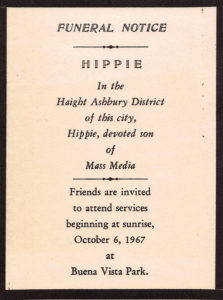
After many people left at the end of summer to resume their college studies, those remaining in The Haight wanted to commemorate the conclusion of the event. A mock funeral entitled “The Death of Hippie” was staged on October 6, 1967. Organizer Mary Kasper explained the message:
“We wanted to signal that this was the end of it, to stay home, bring the revolution to where you live, and don’t come here because it’s over and done with.”
Mock Funeral Notice
But the Music Didn’t Die
Life got tougher in America: the Vietnam War became more intense, as did protests against it, a cultural divide opened between generations, and the assassination of Rev Dr. Martin Luther King Jr. sparked riots across America. BUT — the music didn’t die. We bought the records, listed on the radio, our children heard those records growing up in our homes, and — after these fifty years have passed, the songs of that era continue to be popular landmarks in music, culture, and literature.
![]()
Talkin’ Baseball … Math
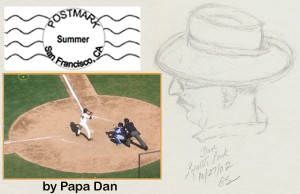 “Using wrong measurements has
“Using wrong measurements has
resulted in bad decisions on contracts,
playing time, trades, and draft picks.”
“It’s led to picking the wrong players
for MVP, Cy Young, and Rookie of the Year
and even obvious stuff like the Hall of Fame.”
“It drives conversations about teams
and players right off the cliff.”
— Keith Law,
from his new book “Smart Baseball”
…
Click here to download a PDF of this article: ConVivio_Baseball_math
= = = = = = = = = = = = = = = = = = = = = = = = = = = = = = = = = = = = = = = = = = =
Getting Baseball Wrong: By the Numbers
Baseball writer Keith Law has written an unusual book about the way we evaluate baseball players and teams — something we’ve all been doing since we were kids. He makes a case that we’ve been getting it wrong throughout the history of baseball. Let’s consider his observations.
When I saw his book, “Smart Baseball,” on the library’s ‘New Books’ shelf, I thought it was about something else — you know, how to PLAY baseball smarter. I thought it might be useful for talking about baseball with my grandchildren. But it’s about something else that all fans do: comparing players and teams during the season and, a tougher task, comparing today’s players and teams with those of the past. We use statistics; and it affects a lot of baseball judgments.
First, how DO we evaluate and compare hitters?
Most of us have known these rules since we were kids.
1. We evaluate hitters by their batting averages, runs batted in, and slugging percentage.
• Batting average (BA): the number of base hits divided by the number of official times at bat — example: a batter who gets 30 base hits in 100 at-bats has a batting average of .300. In this calculation, all hits are treated as equal.
• Runs batted in (RBIs): the number of times a batter causes a runner to score because he gets a base hit or walks in a run — examples: a batter who gets a base hit driving in runners on second and third is credited with two RBIs; a batter who walks with the bases loaded is credited with one RBI. (BTW, a batter who hits a ball “booted” by a fielder causing a run to a score on the error does NOT receive an RBI.)
• Slugging percentage (SLG): the total bases a batter reaches divided by the number of official at-bats. Regardless of the number runs that are produced, a double is counted as two total bases; a homer is four. So, this statistic claims to measure the extent to which a hitter is a “power hitter.” A batter who has 100 official at-bats and hits 20 singles, eight doubles, and two homers has a slugging percentage of .440.
These numbers have been used for making decisions on trading or acquiring players (or baseball cards), selecting a Most Valuable Player (or other batting awards), and setting salaries, literally for centuries. So, how well does that work?
Let’s See
Every year the major leagues give their “Batting Champion” award to the player with the highest batting average. The assumption is that this is the single statistic that identifies the best hitter. In 2015, the Miami Dolphins’ Dee Gordon led the National League with a batting average of .333. So, he was the 2015 NL Batting Champion. That was easy.
–> –> BUT, Bryce Harper of the Washington Nationals led the league in almost everything else that year: doubles, homers (42 to Gordon’s 4), walks (124 to Gordon’s 25), and runs scored. Harper beat Gordon in RBIs (99 to 46) and Slugging Percentage (.649 to .418). So, who was the best hitter? If the offensive goal of a baseball team is scoring runs to win games, which of them would you want on your team? Oh, by the way, Harper was also the National League’s MVP, but, Gordon was the NL Batting Champion. So, tell me — what did that mean exactly?
What about RBIs?
Maybe the number of runs that score when a batter gets base hits is a better gauge of a hitter’s ability. This statistic has long been valued in voting for MVP candidates, as it was (above) in 2015 in the National League. Despite the important role of the RBI stat in baseball reporting, many writers point out that it is one of the individual stats that depends almost entirely on the achievements of other players — specifically, how many players are on base when a batter gets a hit. Examples abound, but comparing two famous careers serves at least to consider the importance of the RBI statistic:
• As we all remember (with varying degrees of admiration for off-the-field reasons), Barry Bonds was the major leagues’ all-time career leader in home runs with 762 compared with Henry Aaron’s 755. To fill out the picture, judging them ONLY by their actual offensive statistics, Bonds hit those home runs in 300 few games than Aaron, got on base more often (.444 to .374), and hit for more power (i.e., a higher slugging percentage .607 to .555), was walked almost twice as many times (2558 to 1402), and was the National League MVP seven times to Aaron’s one. SO, what about RBIs? With all those numbers what would you guess?
Aaron had 301 more career RBIs than Bonds. Why? During his most productive seasons, Bonds batted third in a Giants’ lineup in which two of the three players who batted ahead of him were not so good at getting on base. This fact is what Keith Law refers to as one of the “stupid manager tricks” that make RBIs such a weak indicator of a hitter’s ability. Turns out that Bonds has the distinction of hitting 450 solo home runs in his career. So, Bonds’ lower RBI total has more to do with the lineup that batted ahead of him than anything about his own hitting prowess. So, what does a player’s RBI total tell us about a player’s hitting ability?
Not so much.
What about pitchers?
We evaluate pitchers by the number of “Wins,” Saves,” and Earned-Run Average (ERA). How does that work out? All our lives, starting pitchers have been labeled by the number of “Wins” they are credited with. There are other pitching stats, but they all take a back seat to the “Won-Loss” record. We all want our pitching rotation to include “20-game-winners.” This statistic is simply dumb. While team victories matter more than any other team statistic across a 162-game season, author Keith Law asserts “the idea of a single player earning full credit for a win or blame for a loss exposes deep ignorance of how the game actually plays out on the field.”
I grew up in an era when a manager hoped, and a pitcher intended, that he would pitch a “complete game.” Today — nope. Today, managers typically keep a starter on the mound for 100 pitches, certainly not more than 120. Example: in April of 2016, Dodgers’ rookie Ross Stripling was pitching a no-hit, perfect game in the 8th inning against the Giants when, after his 100th pitch, he was yanked for a reliever. The Giants wound up winning 3-2 on Brandon Crawford’s 10th-inning homer. Contrast that with a game I listened to on my transistor radio back in July of 1963 when 25-year-old Juan Marichal battled 42-year-old Warren Spahn on the mound into the 16th inning, both pitching a shutout, when Willie Mays broke up the party with a 16th-inning homer to win for the Giants 1-0. Even though Spahn had to pitch himself out of a bases-loaded situation in the 14th inning, both managers did the obvious thing — left their best pitcher in the game when they were pitching a shutout in a game they wanted to win. SO, what does it mean? In the first example, Ross Stripling pitched 7+ innings of perfect baseball and it didn’t even show up in his Won-Loss record. In the second example, Warren Spahn finished the season with a 23-7 Won-Loss record; and this game, arguably one of the best pitching performances in history, was just one of his seven losses. What did that statistic mean?
Not much.
Conversely, a “Win” doesn’t always mean that pitcher even pitched well. Example: in the 2000 season, Russ Ortiz pitched 6 2/3 innings and gave up ten runs; but he got the win because his team scored 16 runs that day. Truth is, a “Win” or a “Loss,” as a pitching statistic, depends on the work of many other players — sometimes not because of, but IN SPITE OF the pitching performance. Then, when you factor in the role of relief pitchers who preserve a “Win” for a starter and the very real contributions of the defense and offense of a pitcher’s team, the “Win-Loss” record is pretty useless in evaluating a pitcher’s ability. AND that doesn’t even consider the number of good pitchers who played long careers for bad teams.
So, let’s agree that the “Won-Loss” record is, at best, misleading.
So, what about “Saves?” Rule 10.20 determines that a relief pitcher earns a save when he:
• finishes a game his team wins and he is not the winning pitcher; and any one of these apply:
— enters the game with a lead of no more than three runs and pitches at least one inning
— enters the game with the potential tying run on base or at bat or on deck
— pitches effectively for three innings.
If he meets these criteria, he earns a “Save” — whether he pitches well or poorly; OR he can pitch very well and NOT earn a Save under the wrong conditions. Keith Law tells us: in 2015, there were 114 appearances when a relief pitcher pitched at least three innings and gave up zero runs; but only NINE of those appearances earned the pitcher a “Save.” Compare that to the thirteen saves that year earned by pitchers who allowed two runs in one inning of work, but protected a lead and finished the game. Pitch four scoreless innings in a loss — no save. Give up two runs in the last inning — save. SO, what does the “Save” statistic mean? It’s all about factors that have little to do with the performance of the pitcher. BUT, for relief pitchers, it’s a key contributor to salaries, trades, and recognition.
What about “Earned Run Average (ERA)?”
This stat is a staple on baseball cards and on-screen graphics along with the Win-Loss record. It is the number of earned runs allowed per nine innings pitched. Earned runs are, of course, those that result from base hits and not caused by errors or passed balls. But, it does not account for the ability of outfielders to hold a hitter to a single, throw out runners on the bases, or the subjective work of official scorers to distinguish hits from errors. So, aside from strikeouts and walks, the act of getting a batter out or preventing runs from scoring is shared by others.
While ERA has limited value for evaluating starting pitchers, it is even more misleading for relievers. When a starting pitcher gives up a single, a double, and an intentional walk, he is responsible for those runners. When the relief pitcher replaces him in the 7th inning with the bases loaded and gives up two more singles before retiring the side, all three of the resulting runs are charged to the starting pitcher, none to the reliever. While getting outs is the primary task of any pitcher, it is too easy for a relief pitcher to come in during a tough situation, pitch badly, and leave with his ERA intact. The resulting stat is not an accurate reflection of who did what or the effect their performances had on the outcome of the game. We could cite many examples of the assignment of earned runs in a variety of situations and none would be entirely satisfying. In general, ERA is another case of baseball math that depends more on the sequence of events and the contribution of others than the quality of individual performances.
So, what’s better?
In recent years, something called “Sabermetrics” has begun to creep into the mainstream of baseball writing and even management decision-making (remember the movie “Moneyball?”). Serious statisticians are now employed by more MLB teams every year and they are looking at some different numbers. The book “Smart Baseball” asserts that “On-Base Percentage (OBP) is the most complete of all basic hitting stats, because it includes everything a hitter does” and it excludes many factors that are not specific to the hitter’s individual performance.
OBP = (Hits + walks + times hit by pitch
divided by
(At bats + walks + times hit by pitch + sacrifice flies)
The logic is simple: take the number of times a hitter gets on base and divide it by the total number of times he came up to the plate. Using the 2015 season of Bryce Harper (mentioned above) as an example, this method would have given him an OBP of .460 (46%). If that statistic had been used in 2015, Harper would have easily been the Batting Champion instead of Dee Gordon who simply had a higher batting average by .003.
Again, statistical examples are numerous — let’s return to our previous example:
In 1987, the National League MVP was Andre Dawson. Dawson hit 49 home runs for the Cubs along with a batting average of .287 and 137 RBIs, and a slugging percentage of .568. OK.
However, Keith Law asserts that the real MVP that year should easily have been Tony Gwynn. While Dawson had more home runs and RBIs, Gwynn dramatically overshadowed Dawson in singles, doubles, triples, walks and — here’s the key: he had an On-Base-Percentage (OBP) of .447 compared to Dawson’s .328. Another way to look at it, given that they had a nearly identical number of plate appearances, Dawson made 70 more outs than Gwynn that season. SO, by their own individual contributions, which of them increased their team’s ability to score more runs? If that is the most important objective, it seems that our traditional baseball math may have chosen the wrong MVP in 1987. Using OBP could have suggested another choice.
One small refinement has emerged — the “triple slash” stat: batting average/on-base percentage/slugging percentage. In that case, here is the snapshot of those 1987 performances.
BA OBP SLG
Dawson: .287/.328/.568
Gwynn: .370/.447 /.511
What’s the effect on the recognition of pitchers?
The most prestigious single-season recognition for pitchers is the Cy Young award. As a quiz, let’s take a look at the details of the Cy Young decision in a year you might not remember, 1990, and see if we can decipher how that decision was made. Here were the top candidates:
W L ERA IP Runs
Bob Welch (Oak): 27 6 2.95 238 90 (78 earned)
Dave Stewart (Oak): 22 11 2.56 267 84 (76 earned)
Roger Clemens (Bos) 21 6 1.93 228 59 (49 earned)
Do you remember who won the award? Without looking, who would get your vote? (Hint question: does one statistic dominate Cy Young award voting?)
Bob Welch won the award. Why? Of the three contenders, Welch gave up more runs, had the worst ERA, and . . . well, he had the best Won-Loss record — the one stat that depends the most on the work of others. Was he the best pitcher that year? Heck, Keith Law observes that he wasn’t even the best pitcher on his own team! That shiny “Win” total is clearly the only reason.
The logic is inescapable, but not very useful — you have to look at a number of metrics to make such a judgment about pitchers, not just one. The goal be would to select players that can add as many wins to the team as possible, within a budget.
For those who want to dig deeper into the problem of judging pitchers — and for those who enjoy long descriptions of statistical tradeoffs — and you know who you are — I suggest you read Keith Law’s book (try chapter 14). He actually has an approach to this problem — he calls it “Wins Above Replacement (WAR),” which focusses on an elusive metric: “Runs Prevented.” For me, I skipped to the last chapter where he identifies the two main issues:
1. Baseball provides a lot of data points that are fundamentally interdependent — that is, so few baseball outcomes can be traced to the performance of a single player. It’s a team game (Duh).
2. So much of what drives the way baseball is played and viewed is more cultural than statistical. Players, managers, team owners, and fans do what they do, and like what they like about the game, for reasons they grew up with since the first time each of us was captivated by “baseball fever” when we were kids.
So, when we try to dissect the statistics of the game to understand it better, we find out that baseball is more than it seems . . . and less.
Go Giants!![]()
And Yet, Optimists Speak
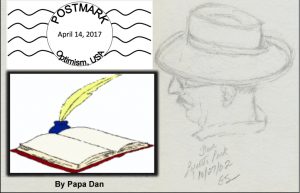
—————–
“In case you thought
optimism was dead,
the average pencil
is seven inches long
with just a half-inch eraser.”
— Robert Brault
—————–
—————–
—————–
—————–
Spoiler alert —–> Yes, it turns out that I am an optimist. Honest. Really. Maybe you are, too?
These days, such a label often elicits an insulting response, such as “How can you be an optimist? Aren’t you paying attention? Everything is going to hell in a handbasket. Just open the newspaper any day of the week.” Or “Anyone with experience knows better than to expect the future to be better than today.” Or “Right, an optimist, but I bet you look both ways before you cross the street, don’t you?”
My father was an optimist and I acquired that attribute from him. In fact, believe it or not, when he was an insurance agent back in the 1950s, he was actually the president of a club of other businessmen in town, called “The Optimists Club.” They had an “Optimist’s Creed,” which they recited at meetings. (Yes, they actually had meetings.) He was an optimist in earnest. As a successful businessman who had not completed the eighth grade and was the son of an illiterate immigrant, it was actually part of his experience to expect positive surprises.
The Optimist Creed was in a frame on the wall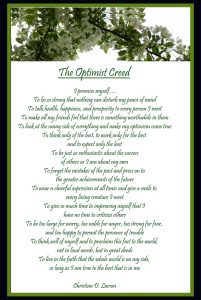
in my Dad’s office
<– <– <– — it looked like this
Why do I remember this? Back in the late
1950s, my Dad kept his office open until noon
on Saturdays; and sometimes he took me to
the office with him. I’d sit in the back of the
office and jam up the adding machine. (I think
I was supposed to be watching him in action
and developing an appreciation for the
insurance business. His plan was to hang a
sign outside that would say “And Son” and I
would one day take over the business.) But,
my actual accomplishment was to jam up the
adding machine. But I digress … why did I
bring this up? Oh yes …
A friend of his, Jerry Bassett, also a member of the Optimist Club, had a call-in talk show on the local radio station (KKIS in Pittsburg, CA). On those Saturday mornings, the show was playing on the radio in the office. One day, Jerry wasn’t getting enough callers; so, he called my Dad during a commercial and told him “I’m dying here, Al. Can you call me up with something interesting to talk about? Whuhduhyuhsay?” So, my Dad took the framed “Optimist Creed” off the wall and called him back.
I was stunned. There was my Dad, sitting at his desk, telling Jerry Bassett about the Optimist Club and why it meant so much to him. He actually read the Optimist Creed over the phone and I sat there and listened to my Dad on the radio — with the confusing five-second delay — talking about what it meant to him to be an optimist. Apparently, others called in and wanted to talk about it; so, I guess it sorta saved the show for Mr. Bassett.
For me, a ten-year-old sitting in my Dad’s office on a few Saturday mornings, while I didn’t acquire an interest in the insurance business, I did develop an appreciation for the idea of being an optimist — just by watching, listening, and observing how people responded to him.
I learned over time from my Dad and from my own observation, that being an optimist meant a number of different things to him and to others. As I read the news and listen to what people say about it all, I grant you that it requires some effort to be optimistic these days (I’m sure I don’t have to tell you that); but it seems that many of us have different views of what that might mean. So, let’s explore some of the different meanings people attribute to optimism — borrowing some words from a few others — and then, let’s try to figure out what it might mean to us to be an optimist today.
Let’s ask around. It seems there are different kinds of optimists.
The Delusional Optimist
This is a guy who falls out of the top floor of a ten-story building. As he passes the floors on his way down (the ninth, then the eighth, the seventh, etc), he says to people on those floors as he flies by on his way down: “I’m doin’ OK so far.”
This is the optimism that gets the most disdain from “realists” who are paying attention to the news (maybe you and me). This delusional optimist doesn’t get a lot of respect. He’s just wrong. In reaction to this rosy view of a harsh world, some pessimists call themselves realists and seek comfort by lowering their expectations:
The ‘Optimism’ of Lowered Expectations
“A pessimist? That’s a person who has been intimately acquainted with an optimist.”
— Elbert Hubbard
Some of us go to great lengths to avoid being called a fool. A pessimist makes clear that the world can be a bad place for real people; and asserts that a fool is someone who thinks it can be otherwise. Others, like Winnie-the-Pooh’s friend Eeyore, try to solve the problem by keeping their expectations low:
“It’s snowing still,” said Eeyore gloomily.
“So it is.”
“And freezing.”
“Is it?”
“Yes,” said Eeyore. “However,” he said, brightening up a little, “we haven’t had an earthquake lately.”
― A.A. Milne
The Patient Optimist: Two versions
“Everything will be okay in the end. If it is not okay; it is not the end.”
— John Lennon (I bet you thought somebody else said that first, didn’t you?)
This is the classic belief that, at some time in the future, something better will happen if you just wait for it.
Lin-Manuel Miranda portrays Aaron Burr as a different kind of patient optimist in ”Hamilton, the Musical.” Burr and Alexander Hamilton are both orphans who have an opportunity to impact history. Burr waits cautiously for the chance to fulfill his destiny in a very tough world and resents Hamilton’s more confident approach. He sings to the audience, “Wait For It” (click here to hear the entire song):
Life doesn’t discriminate between the sinners and the saints,
it takes and it takes and it takes
We rise and we keep living anyway, we rise and we fall and we break
We fall and we make our mistakes.
and if there’s a reason I’m still alive when so many have died,
then I’m willin’ to-
Wait for it …
Wait for it …
In the same show, Hamilton — expecting much more than waiting, says to Burr …
“If you don’t stand for something, Burr, what will you fall for?”
― Lin-Manual Miranda
Hamilton doesn’t respect those who are reluctant to risk making a commitment to something greater than themselves — a criticism he leveled at Aaron Burr, early in their fatal “rivalry.” Burr, wary of commitment, was held back by a feeling that ‘making a difference’ might be futile — or dangerous. In our own time, this very year, some of us fear that the prospects for a positive future are so bleak that there is no point in trying and the challenges we face are too big for us to make a difference. But there are optimists among us who remind us that it is too early to give up and we are pretty useless if we do:
The Resigned Optimist (aka the “No Other Choice” optimist)
“For myself I am an optimist. It does not seem to be much use to be anything else.” ― Winston S. Churchill
And then, some among us feel that we all have some responsibilities to those who will come after us:
The Burdened Optimist (aka “The Future has its eyes on you”)
“There is some good in this world, and it’s worth fighting for.”
― J.R.R. Tolkien
“The future belongs to those who give the next generation reason for hope.”
― Pierre Teilhard de Chardin
And then, some take that responsibility deeper, especially during difficult times (like war):
“Lest I keep my complacent ways, I must remember somewhere out there a person died for me today. As long as there must be war, I ask and I must answer ‘was I worth dying for?’ ” ― Eleanor Roosevelt
Ouch. Eleanor insists that we need to be worthy of the sacrifices others made for us. That brings us back to the need for a plan to make something better and the need to follow through with that plan. Optimism, of this variety, requires action since positive change doesn’t happen by itself. So, in order to avoid being called a fool, a person would have to make something better. You can’t just wait for it. So, this optimist must be bold and forceful, like this guy:
The Determined Optimist (aka “Just try and stop me”)
“My optimism wears heavy boots and is loud.” — Henry Rollins
The determined optimist has to make a show of it and get some attention. But then, that begs the question: ‘What are you actually going to DO to justify all of that stomping around? What are you going to accomplish?” What is worth the risk of being disappointed or being called a fool? From time to time, this brand of optimism can be sufficient, but not always. Some simply take a practical approach and compare optimism to a fruitless alternative:
The Confident Optimist (aka “Look, we know how to do this”)
“Pessimists are usually right and optimists are usually wrong but all the great changes have been accomplished by optimists.” ― Thomas L. Friedman
So, the need to accomplish something rears its (ugly/beautiful) head:
“One thing we know beyond all doubt: Nothing has ever been achieved by the person who says, “It can’t be done.” ― Eleanor Roosevelt, You Learn by Living
“BE the change you wish to see in the world.” ― Mahatma Ghandi
Like Eleanor and Mahatma, some notable optimists in our own time insist that despair is not helpful and we need to take responsibility to encourage others. You know this guy:
“The only thing that’s the end of the world is the end of the world.”
“Yes, we can.” ― Barack Obama
Not all of us are going to run for office, speak to an audience of millions, and change the world. For many of us it may have to be enough to serve as a good example to encourage others — our children, their children, people we meet — to BE the change that is required. Maybe all it takes is a few words of encouragement to younger minds — maybe words like “Yes, we can.” It turns out that some outcomes are possible even if we haven’t seen them before.
The “Who’s Going To Stop Me” Optimist (aka “What do you mean it can’t be done?”)
“Sometimes you have to pass through the fire swamp to get where you need to go.”
“But, we’ll never survive.”
“Nonsense. You’re just saying that because no one ever has.”
— William Goldman, The Princess Bride
Is it often difficult to distinguish the “Delusional Optimist” (you remember, the guy falling out of the building) from the “Who’s Going to Stop Me” optimist, but the difference matters. Many optimists are occasionally intimidated by the enormity of great challenges — finding that important things seem to require great effort, by a great many people. But some wise people suggest the opposite approach: taking small steps in the company of just a few people:
The “Incremental” Optimist
“The secret of getting ahead is getting started. The secret of getting started is breaking your complex overwhelming tasks into small manageable tasks, and starting on the first one.” — Mark Twain
“A year from now you will wish you had started today.” -Karen Lamb
“A small group of thoughtful people could change the world. Indeed, it’s the only thing that ever has.” – Margaret Mead
“Thou hast seen nothing yet.” — Don Quixote de la Mancha (Cervantes)
It turns out that some outcomes are possible even if we haven’t seen them before. Some look at the mixed advice we hear and get discouraged by disappointing outcomes — but some don’t.
The “Maybe this time” Optimist
One thing seems essential — that we do not settle into the extremes of “always” and “never” — that we find an optimism based on the idea that, sometimes, good outcomes are possible. Sometimes. This poem by Sheenagh Pugh reminds me that, whichever variety of optimist I decide to be, on a particular day, there is reason to believe in positive outcomes. They don’t happen by themselves, they do require our efforts, but they happen … sometimes.
And that may be enough. I may be this kind of optimist …
Sometimes
Sometimes things don’t go, after all,
from bad to worse. Some years, muscadel
faces down frost; green thrives; the crops don’t fail;
sometimes a man aims high, and all goes well.
A people sometimes will step back from war;
elect an honest man; decide they care
enough that they can’t leave some stranger poor.
Some men become what they were born for.
Sometimes our best efforts do not go
amiss; sometimes we do as we meant to.
The sun will sometimes melt a field of sorrow
that seemed hard frozen: may it happen for you.
— by Sheenagh Pugh
Sorting Out the Voices
So, what have I learned from all of these voices? My Dad taught me about “sometimes” as his Dad taught him. The other side of “sometimes” is that sometimes we need to stomp around and be “The Determined Optimist,” and march in the street with other determined optimists. Sometimes the best we can be is “The Resigned Optimist” and simply try not to give up. Sometimes we are forced to be “The Patient Optimist and “Wait for It.” Sometimes we can see a middle path and serve as a “Confident Optimist” and contribute to incremental change by contributing to organizations that can accomplish important changes with lots of small donations (examples: organizations like the ACLU, Planned Parenthood, PBS, The Yosemite Conservancy, Meals On Wheels, your local library … you probably have your own list.) Those among us with more imagination and determination may find ways to “Be the change we seek.” Perhaps our task, if we can’t BE one of them, is to support those who do.
![]()
Click here to download a PDF of this article: Optimist_ConVivio_April14
A Guy Walks Into a Bar
Sandburg—  “You teach yourselves the law
“You teach yourselves the law
but I train your minds.
You come in here with a head full of mush,
and you leave thinking like a lawyer.
But … it may not be enough.”
— Professor Charles W. Kingsfield
from “The Paper Chase”
(a movie set at Harvard Law School in 1973)
Sandburg
+++++++
+++++++
Walking down Massachusetts Avenue, on his way back to his fraternity, a first-year law student found himself in the middle of an unexpected downpour without an umbrella. As luck would have it, he was passing a popular watering hole frequented by Harvard Law students and professors. From habit, he mentally acknowledged the weird fact that The Grafton Street Pub & Grille was actually on Massachusetts Avenue; but it was forgiven for its convenient location right beside Harvard Square. Gratefully, he ducked into the dark, leather-appointed bar, since he was clearly unprepared for the inclement conditions outside. He calculated that the storm was likely to continue for just as long as it would take to sit down at the bar with a class of “Maker’s Mark,” and he could be on his way once conditions had improved. Not a bad way to pass the middle of an otherwise worthless afternoon.
Apparently, others had the same idea — the place was packed. In fact, there was just one empty barstool, at the end of the bar next to an older well-dressed gentleman — probably a professor, he reasoned. So, he took his place, and signaled to the barkeep: “Makers’ Mark neat, please.”
As the drink arrived with a bowl of nuts, the gentleman to his left cast a sidelong glance at him without turning his head, “I see you were unprepared for the forecast.”
“Well, I didn’t think …”
“So I surmised,” he said without letting him finish.
“Well, sure, uh, cheers … sir.” He figured he might as well pass the time with some idle conversation. The guy seemed rude but harmless. Start with flattery. “I haven’t seen you in here before. Are you a visiting professor?”
“Visiting? I suppose one could say that. I’ve been away a very long time.”
“My name is Hart. Kevin Hart.” He extended his hand, a courtesy that was not returned. Maybe he didn’t notice, he thought. “Where have you been so long?”
“Well, young man … “ and he finally turned to look at him directly. “I don’t suppose you’ve read any Dante.”
“The Inferno?”
“Il Purgatorio. On my way up and out, hopefully, but it seems I need to pass through here first. Unfinished business, perhaps.”
Kevin didn’t quite know what to make of this. He decided to humor him. No need to be rude; and who knows, he may find himself in this fellow’s classroom one day. “What do you teach?”
“Contracts. Or so I did at one time. Clearly with less success than I had hoped.”
“I had Professor Warren for Contracts. Pretty straightforward, I thought. You say, ’With less success’ than you had hoped … Why do say that?”
“Leaving the impression of ‘pretty straightforward’ doesn’t speak well for a course of that complexity; but I have to say that the evidence suggests that I didn’t do much better. As far as I can see, the notion of ‘Contracts’ hasn’t been well-assimilated in this society. I suppose Harvard Law, AND I, have some responsibility for that failure.”
“Well, [defensively] it seems that Harvard Law has made some significant contributions, wouldn’t you say? I mean, a number of Presidents have come from here. That would seem to suggest at least some success. Obama came from here, as did both Roosevelts and Kennedy … ”
“And both Adams’,” [he makes a face], George W. Bush [sighs loudly and takes a deep drink of his whiskey], Rutherford B. Hayes [his eyes roll] … but I’m quite sure that isn’t the ideal figure-of-merit for an institution that purports to make a difference in society. There are elements of the law — especially contract law — that seem to have fallen into disrepair of late. Not sure Harvard Law, or any educational institution up and down the spectrum, can be proud of that.”
“Well, I feel the need to speak up for my school, I think I am receiving a quality education, yes, in Contracts, and other areas.
“Go ahead. [For just the second time, he turns to look at Kevin directly.] Defend your school. Tell me about Contracts.”
Now he’s on the spot … it feels like an oral exam. He waves to the bartender and points at the two empty glasses on the bar to order another round. He begins. “Written contracts are perhaps the most forceful self-managing tools in our society. We have well-established norms that are clearly enforceable and fairly efficiently litigated. Binding contracts between known entities, signed and witnessed, are … “ [He’s interrupted.]
“Let me ask you, Mister, uh …” [gestures his question as the second round of whiskeys arrives]
“Hart. Kevin Hart.” [Deflated a bit, he was just getting started.]
“Mister Hart. As you teach yourself the law, as ‘straightforward’ as you say it is, perhaps there are questions worth exploring that you, and others of recent generations, may have overlooked. Examples: Are contracts binding only on those present for, as you say, the ‘signing and witnessing?’ Must the specifics of societal agreements be written on a piece of paper? Are there responsibilities by which one generation, for example, should be held accountable to another generation? Are there values, principles, and expectations that should provide continuity and social identity in a society over time?”
In a familiar professorial speech pattern, he doesn’t wait for an answer. “I argue that there are standards of acceptable logic and quality thinking that have historically been accepted, and expected, that have all but disappeared from public and private discourse. Standards for the assumption of truth and accuracy were practiced in my day without the necessity of challenge. I assert that Americans have a collective responsibility to understand how our institutions work and to pass that understanding on to generations that follow us.”
Kevin recognizes the pedantic behavior. “My grandfather told me about a professor who said something like that to him — something about teaching himself the law — he was a tough old bird. He used to ask questions that sounded simple but tangled grandpa in knots. Said the guy made him lose his breakfast one morning.”
Kevin took advantage of a pause while both of them sipped from their glasses. He tried consciously to extricate himself from the feeling of sitting in a lecture hall and the urgent need to be taking notes; but to no avail …
“So, young man, to answer the question that is likely to be on your partially trained mind, I do feel some responsibility, shared though it is with the rest of American education and upbringing, for the fact that the quality of American decision-making has demonstrably diminished in recent years, wouldn’t you say? You pointed out that Harvard Law provided a list of American presidents, albeit of mixed quality, along with other prominent decision-makers and thought-leaders; but I assert that Harvard Law is now contributing more professionals to Wall Street that to the halls of government [rolls his eyes again.], which is not exactly a feather in its cap. I also assert that the current abominable level of intellectual application that has created your current societal disorder is the product of abysmal application of educational principles. The Socratic method of instruction, which I grew up with and which I employed during my career, is useless on an audience without the prerequisite skill in logic, knowledge of factual precedent, means and ends, and the ability to recognize and apply common sense. The absence of those attributes, among both educators and members of society writ large has led to some dismal decision-making. I read your newspaper this morning and could not believe what I was reading. It sounded like a poorly written comic novel.”
Kevin was feeling the need to say something to avoid assenting to the lecturing nature of this conversation; so, “I agree that my country has made some terrible decisions at all levels, in the halls of government, in the voting booth, as well as on the street — heck, I came out today without an umbrella, that’s what brought me in here. But I am in law school to prepare myself to do something useful — to be part of a solution. So, professor, what is your plan to mitigate all of that? You suggest that you have some responsibility to admit and some damage to repair. So, what’s your plan? Have you come back to Harvard simply to admire the problem and confess your culpability, or do you offer a solution?”
For a third time, the professor turns to address the student directly. “I have two answers. First is to attack the crisis in Civics Education. The problem is not just my complaint about Harvard Law School, the deficiency exists at all levels of education. Among the American population, knowledge of the three branches of government, how they work, why they matter, how they balance and check each other is at the lowest point in our history. Even those appointed to the highest levels of government service seem to have a dangerously unrealistic understanding of the scope of a president’s power. Equally lacking is our understanding of the importance of the news media as the backstop to protect against egregious mistakes. A public figure while I was still at Harvard Law, Daniel Patrick Moynihan, famously taught us: “Everyone is entitled to their own opinions but they are not entitled to their own facts.” America has made serious mistakes in our history, but our strength has always been in learning from them and trying not to repeat them. Right now, I warn you, because of the ignorance of our institutions coupled with an inability to recognize facts, there are serious mistakes that you will have to make, and learn from, all over again. Some of those mistakes are beginning to happen right now. Education is the only way to avoid doing that and it’s not going to be a quick fix.
“My second solution is you.” He pauses for effect, keeping his eyes on the student while he drains the last of his whiskey. “I think the best thing I can do is to turn this responsibility over to you. I’ve given you enough to proceed on your own. You have said that you plan to graduate and fulfill some dream of making a difference. We’ve identified some fields you can plow in that effort. Perhaps the challenge can be met in the field of education or rhetoric, or maybe you will be the eighth president to come from this institution. That rests squarely on your shoulders. So, now that I’ve assigned the problem to a qualified student, I think I’ve spent enough time here.” He gestures grandly at the inside of the Grafton Street Pub. “I claim that I have fulfilled the requirements of Dante’s ‘Purgatorio.’ I’m going to call it done. Let’s agree that it’s your responsibility now. Thank you for the drink and try to stay out of the rain. I wish you well Mister . . . what was it?”
“Hart. Kevin Hart. And you, professor? I didn’t catch your name.”
“Kingsfield. Charles Kingsfield.”
Click here to download a PDF of this post: Guy_walks_into_a_Bar_Mar10_2017![]()
For those interested in the need for an improvement in Civics Education in America,
a national initiative with that goal has come out of the Second Circuit of the Federal Court system.
It’s called “Justice for All.”
Take a look here: http://justiceforall.ca2.uscourts.gov/
And It’s Still Just February
Sandburg— 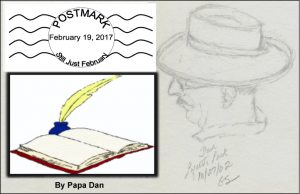
Sandburg
Sandburg
“Five hundred twenty-five thousand
six hundred minutes.
How do you measure a year
in a life?”
— from “Rent”
Sandburg
+++++++
+++++++
Some Years Stand Out
I recently wrote a piece asking “What kind of year was 2016?” Some of you participated by contributing to ConVivio’s “Thirty-Word Challenge” and sent me your assessments of how 2016 will lead to 2017. You sent me some great words. (Take a look: https://convivio-online.net/looking-back-at-2016-ahead-to-2017.) Maybe though, the bigger question is … what difference does a single year make? Is 2017 going to be just a detour or will it be a major turning point?
Over the course of my 66+ trips around the sun, some years stand out in memory — some were good, some bad, and some were turning points in the flow of history. During the first half of the 2017 Super Bowl (while the Falcons were still blowing out the Patriots), I was sitting with an enlightened friend of mine (I’ll call him Judge Danny) and somehow we got to talking about years. At halftime, the TV commentators were talking about other Super Bowl blowouts, like the 49er destruction of the Broncos (55-10) in 1990.
PapaDan: 1989 was a memorable year, too. The 49ers beat the Bengals…
Judge Danny: Then there was the 1989 World Series with the Giants and A’s…
PapaDan: I don’t want to talk about it. [Changing the subject] That was also the year the Berlin Wall came down, and revolutions popped up all over Eastern Europe.
Judge Danny: Right…the end of the Cold War.
From sports we segued to “most momentous years.”
PapaDan: 1969 — Armstrong walked on the moon…
Judge Danny: And returned home. 1963 was unforgettable. It hurt bad. I was thirteen.
PapaDan: Yes, it hurt. 1964 was better, the Beatles and lots of great music. And 1951 was a huge year in baseball. Growing up, I read all about Bobby Thompson’s “shot heard ‘round the world.” Russ Hodges went crazy: “THE GIANTS WIN THE PENNANT! THE GIANTS WIN THE PENNANT!” 1962 was another good year for the Giants, less dramatic but a big thrill.
Judge Danny: I remember; but those were just baseball, right?
PapaDan: Right. So, in our lifetime, what do you figure was the most important year of all?
Judge Danny: We’re the same age, right? We both graduated in 1968. That was the biggest year since we’ve been around. Don’t you think?
PapaDan: Wow. Yes. No question about it. 1968 was a turning point.
We were interrupted by the second half kickoff and the subject of the “most important year” didn’t come up again — we were too busy bemoaning the collapse of the Atlanta Falcons. The next morning, though, after depressing myself with the newspaper, I decided that Judge Danny had been right — 1968 was the single biggest turning point during my lifetime, both for me and for America. There was a lot going on during several years of the turbulent sixties. But 1968 stands out. The title of an important research project on the subject said it well:
“The 1968 Project — A Nation Coming of Age.”
What did we see on the Evening News in 1968?
It was a year of “just one damn thing after another.” President Lyndon Johnson began the year with his State of the Union Address noting that “Our country is challenged at home and abroad,” and the challenges began immediately. One week later, North Korean patrol boats captured the Navy intelligence ship “Pueblo” within their 12-mile territorial waters, initiating a dangerous year-long international crisis. Then, a week later, the Vietcong launched the brutal “Tet” offensive; massive numbers of troops poured out of the jungles and devastated dozens of cities and towns. The surprise invasion of the U.S. Embassy in Saigon and sudden large-scale deaths of American soldiers quickly turned public opinion against the war. Two days later, Richard Nixon declared his candidacy for president. The following week, the Pentagon announced the largest one-week casualty figures of the war and Walter Cronkite, having just returned from a tour of the battlefields, reported that the best America could expect in the war was “a stalemate.” In the White House, President Johnson said privately, “If I’ve lost Cronkite, I’ve lost Middle America.”
–> All that, and it was still just February.
As the year unfolded, the news continued to surprise and distress a lot of people.
— March 12: Senator Gene McCarthy nearly defeated the sitting president of his own party in the New Hampshire primary. Four days later, Senator Robert Kennedy withdrew his support of President Johnson and announced his candidacy.
— On March 31: President Johnson, overwhelmed by anti-war pressure, announced, “I shall not seek, and I will not accept, the nomination of my party for another term as your President.”
— April 4: one week after leading a march in Memphis that turned violent, Dr. Martin Luther King, Jr., was shot and killed while planning his “Poor People’s March on Washington,” sparking riots across the country. Robert Kennedy, hearing of the murder just before giving a speech in Indianapolis, stood up at a street corner and gave an emotional extemporaneous eulogy — pleading with the mostly black audience “to tame the savageness of man and make gentle the life of the world.”
— On April 29, the musical “Hair” opened on Broadway, dramatizing powerful social and political change and a “generation gap” between those who were coming of age in 1968 and their parents’ generation.
— May 6: In Paris, 5,000 students marched in what was soon called “Bloody Monday,” the most violent day of a student revolt. Sympathetic strikes involved nine million French workers.
— June 5: Robert Kennedy won the California Presidential Primary, a victory that all but assured him the party’s nomination. Minutes after his victory speech, he was assassinated.
— July 24: at the Newport Folk Festival, singer Arlo Guthrie performs his 20-minute ballad “Alice’s Restaurant” to rave reviews. (“You can get anything you want, at Alice’s Restaurant.”)
— August 8: The Republicans nominated Richard Nixon to be their presidential candidate.
— August 20: The Soviet Union invaded Czechoslovakia with 200,000 troops.
— August 26: The Democrats nominated Hubert Humphrey for president. Outside the convention, protests erupted and Chicago police arrested nearly 200 people and sent more than 100 others to hospitals with “night-stick” head injuries.
— September 7: “Women’s liberation” groups protested at the Miss America contest in Atlantic City. While nothing actually burned, the phrase “symbolic bra-burning” was coined.
— October 12: The Summer Olympics opened in Mexico City, boycotted by 32 nations to protest South Africa’s participation. Two U.S. medal winners in the 200-meter dash, gave the “Black Power” salute during playing of the Star-Spangled Banner at the medal ceremony.
— November 5: On Election Day, 31,770,000 (43%) voted for Nixon. 31,270,000 (42.7%) voted for Humphrey. 9,906,000 (13.5%) voted for George Wallace.
— November 14: On “Turn In Your Draft Card Day,” young men across the country burned their draft cards and protested the Vietnam War.
— December 12: Robert and Ethel Kennedy’s eleventh child, Rory, is born.
What was it like for those of us watching all of this?
For me and others born in dead-center in the 20th century, 1968 was a singular turning point. We were “The Class of ’68” at Antioch High School. Except for the stories Walter Cronkite told us on The Evening News, the future looked bright. Like most of my high-school friends, I lived in a bubble of stability and certainty. High school was good for me — I got good grades, I played varsity sports, and in May I was accepted to the college of my choice (Santa Clara University). I had a supportive family who encouraged me every step of the way, and I was surrounded by friends who were a lot like me. But 1968 was also the year I got my first look at discrimination, major disappointment, and local cruelty.
Racial Discrimination
I started kindergarten in Antioch in 1955 and it took me until I started high school to notice that there had never been ANY black students in my school or anywhere in my town. The first black kids I met were on the basketball court when Antioch High played Pittsburg High.
That year, Antioch’s foreign exchange student was a girl from South Africa. Apartheid was still in full force there and I remember hearing her speak proudly about “separate but equal.” It didn’t sound right to me.
Then came “the big story.” The parents of a student two years behind me (class of ’70) had moved to Antioch at the beginning of the school year. As new arrivals, they were visited by the city’s “Welcome Wagon” and given a basket with various household products, advertisements for local stores, and advice about the town. The “Welcome Wagon” greeter assured this new family that “This is a nice town full of nice people. And don’t worry, you won’t find any blacks here — the realtors and landlords in town make sure of that.” The new neighbors didn’t like that at all. They asked around and found that others had heard the same thing. Long story short, they filed a class-action lawsuit that gave Antioch an apparently well-deserved reputation for racism. I was stunned — discrimination in MY town!
Optimism, Disappointment, Cruelty, and Regret
Before midnight on June 5, 1968, I went to bed happy. I had turned off the TV following Robert Kennedy’s victory speech after winning the California Primary. “Let’s go on to Chicago and win there,” he concluded. It was one of the last three “school nights” before my graduation on Friday. I was a huge fan of the Senator — my father passed on to me that we were “Roosevelt/Kennedy Democrats.” I wanted very much for RFK to become president and pick up where his brother had left off. I figured Bobbie would end the war (and, therefore, the draft), support the civil rights legacy of Dr. King, and … well … save us from Richard Nixon. In the morning, I was still in bed when I heard my mother come back from retrieving the newspaper and heard her shout, “Turn on the television!” I jumped out of bed and turned on the TV to hear that Robert Kennedy had been shot right after delivering that victory speech. I stared at the TV and cried. I was 18 years old and I cried, hard.
Numb, I went to school. Some kids were stunned, a few were visibly upset, others hadn’t yet heard the news. It was the talk of the hallways by noon. After lunch, I walked into my Journalism class and found one student crying uncontrollably at her desk. She was known to be an extremely sensitive girl and prone to emotional displays. A few kids made it their business to try to protect her from bullies who made fun of her. Before the teacher arrived and before I realized what was happening, a jerk named Michael, one of those bullies who sensed weakness and attacked for the fun of it, went up to her and announced, “Those Kennedys got what they deserved. I say it’s about time. There’s just one left, and we’ll see about him.” She knocked over her desk as she ran sobbing from the room. Michael strutted as he followed her out the door. I quietly righted her desk and walked away as other students began to arrive.
This incident compounded the darkness I was feeling — darkness that got a lot worse before it got better. It took me some time, perhaps mid-summer, before the regret set in. I had never actually punched anyone in my 18 years (or since); and if I had punched Michael, nothing would have gotten better. But I have to say that the single greatest regret that endures all of these decades since my high-school days is that I didn’t do or say ANYTHING. I was the witness to something harmful done to a vulnerable person … and I didn’t do anything.
Moving into a New World
Graduation was fun. It made me feel that the future was bright. But as summer warmed up, I became aware that the “bubble of stability and certainty” that I had lived in was disappearing. I was moving out of a comfortable home and leaving behind a school and a town where I had known sort-of everybody. I realized that I would be surrounded by strangers. So, come September, I had moved into the dorm (with the help of my sister), and life began anew. Shortly after that, my roommate looked at me one day and declared, “A guy’s got to have some hair” and before I knew it, I had grown a mustache that I would have for the next forty years.
College was great! There was terrific music everywhere (that most of our parents hated). Judy Collins performed a concert in my cafeteria my first month at school. Later that year, I spent a weekend with my oldest home-town friend in his dorm at the University of San Francisco; and we saw a free concert with The Jefferson Airplane in the Golden Gate Park Panhandle, (We even got “busted” by the dorm prefect … for drinking beer. Yep, beer.)
Down the hall in my dorm, was Dan Pastorini, our quarterback (a future NFL star) and the cheerleaders were all guys. (Huh?!) Professor Misselbrook inspired me with Robert Frost and Shakespeare, Dr. Bellotti taught my first (and last) Economics class (I had applied as an Econ major), and Dr. Nyquist, the Music Department chairman, stimulated a lifelong interest in Baroque music (who wouldda thunk?). But still, who was I? Where was I going? Would I end up taking over my Dad’s business (the plan) or become a teacher, writer, or something else? How soon would I begin to feel at home … again? As the year ended, the newspaper continued its drumbeat of scary stories — 549,000 troops in Vietnam and a death toll of 17,000, the highest in the war’s history. The day I drove home for Christmas, the “Pueblo,” was finally released. I admit I didn’t notice either story. Suddenly, all of the worldwide uncertainty that I had heard on The Evening News all year, didn’t seem as important as the turning point I was experiencing as an 18-year-old college freshman on my own. I had much to learn about myself and the world around me.
Back to “the future”: 2017
So, fast-forward nearly 50 years. Here we are in 2017, trying to make sense of a year that seems to change every day. In just a month, the leader of the free world:
— Spread a series of “alternative facts” that advisors repeated and the world knew to be false,
— Initiated a potential constitutional crisis and caused chaos world-wide at airports, cities, and universities with an executive order to ban immigrants from seven countries, an order that he said had been implemented “smoothly” until it was blocked by a “so-called judge,”
— Sent a young “senior advisor” out to threaten judicial authority on the Sunday talk shows and clarify that “the powers of the president to protect our country … will not be questioned,”
— Told the Mexican president that he might send troops into his country to “take care of” some of his “bad hombres”; that same day he hung up on the leader of Australia,
— Insulted a long-term African-American congressman and civil-rights icon on the Martin Luther King holiday, calling him “all talk, talk, talk” and calling his hometown of Atlanta a “crime-ridden hellhole,”
— Promoted a political strategist (former Breitbart executive) to the National Security Council, and demoted the Director of National Intelligence and Chairman of the Joint Chiefs of Staff,
— Installed a national security advisor who had an inappropriate/illegal, back-channel relationship with America’s most dangerous adversary, then fired him for it, and blamed his firing on the news media for spreading fake news (“the information was real but the news was fake” and “I didn’t direct him to do it but I would have if I thought he wasn’t doing it.”),
— Responded to accusations of mental instability by saying “I comprehend very well, OK, better, I think, than almost anybody,” and observed that, in his chaotic first month in office, his administration was a “smooth-running machine.”
Commentators, writers, readers, listeners, citizens, others (you know, you and me) are asking questions like these: What’s true and what’s not? How do we know? Who is “we” and who is “they?” Do the things we’ve learned over a lifetime still apply to the present moment? To the future? And most important, what can we do to make sure this year is only a detour and not a turning point?
–> And it’s still just February.
Click here to download a PDF of this post: ConVivio_Just_February_Feb19_2017
— Major thanks to Gretta for good advice and to Lauren for her expert editing —![]()
Gratitude
Sandburg— 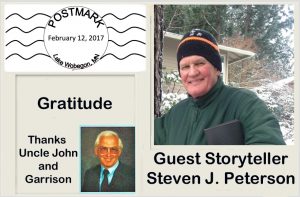
Or“Complaint is a mainstay of comedy,
so I am now experimenting
with a comedy of gratitude,
talking about parents, teachers,
lucky breaks, dumb things
that turned out smart.”
— Garrison Keillor
Watch out for “gum chewers,
cigarette suckers, and cosmetic users.”
— Uncle John
Thanks Uncle John and Garrison
On April 28, 2017, Garrison Keillor will perform at Concordia College, across the street from the Prairie Home Cemetery, in Moorhead, Minnesota, for what he is calling his “Gratitude Tour.” It is the Prairie Home Cemetery that Keillor credits for the inspiration to name his radio program.
In a recent Prairie Home Productions news release, Keillor wrote, “Complaint is a mainstay of comedy, so I am now experimenting with a comedy of gratitude, talking about parents, teachers, lucky breaks, dumb things that turned out smart.” My Uncle John would have loved to drive from his house about a mile over to Concordia to listen to Keillor’s comedy of gratitude.
From 1974 to 2016, Keillor hosted over 1500 Prairie Home Companion radio shows. That’s an astonishing number. Who knew so much could happen in a small Minnesota town out there on the edge of the prairie?

At his 90th birthday celebration, Uncle John with granddaughter Julia.
In August of 1974 I was introduced to the Prairie Home Companion radio program by my Uncle John a week or two after he first heard it on the local Minnesota Public Radio station, KCCM-FM, at Concordia College. He graduated from Concordia in 1952; I graduated in 1971. Uncle John brought his bulky AM/FM portable radio out to the picnic table in his backyard so we could listen to his recent discovery where we were eating corn on the cob and hot dogs on a humid Saturday evening. Prairie Home Companion first aired on July 6, 1974, and was broadcast on Minnesota Public Radio from Macalester College in St. Paul, not far from where Uncle John grew up with a younger brother and sister.
He was born in 1925, and after graduating high school from Minnehaha Academy in St. Paul, he entered the Navy to serve during World War II. In 1945 he was stationed at the Livermore Naval Air Station. When he and his wife Margaret visited me in the late 1980s in Livermore, we drove down East Avenue past Lawrence Livermore National Laboratory which had been the site of the Naval Air Station. Uncle John was very surprised that many buildings from when he was stationed there were still standing.
His parents died in a small plane crash in 1947 near Buffalo, Minnesota, and that tragic, life-changing event brought Uncle John and his brother and sister to Moorhead to live with an aunt. He attended Concordia, where he majored in biology, and found the professors to be especially welcoming and very supportive. All of his life he was a loyal alumnus.
This past July, two weeks after the last broadcast of Prairie Home Companion with Garrison Keillor, my Uncle John celebrated his 91st birthday. Parkinson’s disease had greatly reduced his ability to speak. His voice was weak and muddled but his intention to engage in conversation was strong. He always wanted to tell me a joke, he always wanted me to laugh, and he always wanted me to listen to “good” music, which for him ranged from a Bach hymn to songs by the Eagles.
Uncle John loved telling Norwegian jokes especially the ones about Ole and Lena. I can hear his laugh at the punch line when he told the one about Ole and Lena being married for 65 years, and Ole recounts how Lena had been with him through all his medical problems from gall bladder surgery to liver cancer, and then concludes, “Lena, I’m beginning to think you are bad luck.” Uncle John, who had been married to Margaret 64 years when he died this past September, appreciated the gift of a life-long partner with a tolerant sense of humor.
He was familiar with many communities like Garrison’s Lake Wobegon. During his career as a pharmaceutical sales rep in northern and western Minnesota, Uncle John loved talking with the local doctors, nurses, and patients, then heading to a nearby restaurant much like the Chatterbox Café in “real” places such as Ada, Bemidji, Elbow Lake, Pelican Rapids, and Thief River Falls.
I enjoyed that first broadcast I heard in 1974 at that backyard picnic table even though there was no news from Lake Wobegon. Keillor did not introduce listeners to the news from where all the women are strong, all the men are good looking, and all the children are above average, until 1977 while I was living in Europe.
In 1980 Prairie Home Companion began broadcasting to a national audience, so, when I returned to the United States in 1981 and was teaching in West Lafayette, Indiana, I was pleased to hear that the program Uncle John had introduced to me seven years before was thriving. Purdue University’s WBAA-FM aired the show every Saturday evening. Of the many amusing “sponsors” of Prairie Home Companion such as The American Duct Tape Council, Bob’s Bank (Save at the Sign of the Sock), The Fearmonger’s Shop, Raw Bits Breakfast Cereal (Oat hulls and wheat chaff — not for everybody), Powdermilk Biscuits (Heavens they’re tasty, and expeditious), I recall a phone conversation long ago made memorable by Uncle John’s asking the key question posed by one of the sponsors, “Wouldn’t this be a great time for a piece of rhubarb pie?” then singing (to the tune of Shortnin’ Bread) the Bebop-A-Rebop Rhubarb Pie jingle: “One little thing can revive a guy, And that’s a piece of rhubarb pie. Serve it up hot, maybe things aren’t as bad as you thought. Momma’s little baby loves rhubarb, rhubarb, Bebop-A-Rebop rhubarb pie.”
Keillor reported the News from Lake Wobegon with characters that were reminiscent of my relatives and friends and acquaintances while growing up in Minnesota. I suggested to my Purdue University students and colleagues that they listen to the program. One of my colleagues, a fellow Minnesotan, was an enthusiastic fan of the Prairie Home Companion. She had attended Gustavus Adolphus College, the home of the Gusties and a Swedish Lutheran liberal arts college, in St. Peter. I had attended Concordia, the home of the Cobbers and a Norwegian Lutheran liberal arts college, in Moorhead. We had a spirited, humorous rivalry about Gusties and Cobbers, and about Swedes and Norwegians. We had a common history of the folks we knew living in places like Lake Wobegon. Another Purdue colleague from New York City, proud of his Russian and Jewish heritage, was charmed by Keillor’s storytelling. He wanted to know if what Keillor said was true. He asked questions about unfamiliar things such as Luther League, lefse (a potato bread that looks like a tortilla), and ice fishing. We assured him that everything Keillor said accurately reflected the experiences we had in “real” Minnesota towns.
I have recommended Prairie Home Companion to many people since the early 1980s. I was always confident that the two-hour radio program was worth anyone’s time because of its variety of music, humor, and weekly news about people living on the edge of the prairie, in the little town that time forgot out there in central Minnesota’s Mist County.
In 1984 when I left Purdue for a career at Lawrence Livermore National Laboratory, I liked telling my new colleagues including Dan Sapone about Prairie Home Companion. Everyone I told had a favorable response and especially to the News from Lake Wobegon. Dan valued Keillor’s storytelling so I was grateful, then, and even more so now, that he taped the presentation Keillor gave at the National Press Club in 1987. I am pleased that I have kept the cassette tape, and I have listened to it numerous times.
In 1987 Keillor left Prairie Home Companion for 26 months. He explained that he had become too famous because his radio show had four million listeners. He could no longer live in anonymity, which as a shy person he wanted to do. He married his former high school sweetheart, an exchange student from Denmark, and moved to Copenhagen in the summer of 1987.
On Tuesday, October 20, 1987, Keillor appeared at the National Press Club in Washington, D.C., to promote his latest book, Leaving Home, a collection of monologues from the Prairie Home Companion. Dan taped that program for me while I was visiting the Oregon Shakespeare Festival in Ashland. It was the week that the Dow dropped 508 points (22.6%, down to 1738.74) and the Minnesota Twins were in the World Series for the first time since 1965.
In his formal comments to the National Press Club about the drastic drop of the Dow Jones Industrial Average on Monday, October 19, 1987, Keillor said, “We think the stock market crash is catastrophic but we are not sure. Is this the worst that can happen? We don’t know that. The newspapers are using second-coming type face. One says Panic! And the other says Crisis! But people back home in Minnesota are not affected by the 500-point drop of the stock market, rather they are riding high because the Minnesota Twins are in the World Series, playing the St. Louis Cardinals. We are a different kind of baseball fan. New York fans demand triumph. While in Minnesota we believe that whatever happens is probably our fault. We were brought up to wait and see. We believe that all things come to those who wait. Twins fans. Democrats. Investors. It will come around again. In 1980 I believed that Reagan could not be elected President of the United States, and in 1984 I believed that Walter Mondale could beat him. As 1988 approaches I believe that Ronald Reagan cannot be elected to a third term. Eventually you win.”
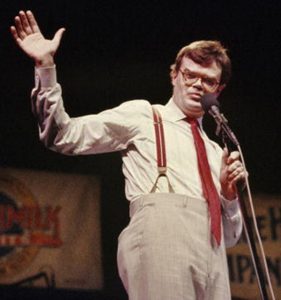
In the question-and-answer segment at the National Press Club, Keillor was asked if he missed his radio show. He replied, “I miss it terribly. I miss singing songs with people who know the words. I have found out that a storyteller has to keep working.” Fortunately, for his listeners he returned to the Prairie Home Companion in 1989. Keillor claimed that “eventually you win.” These days it is harder to believe that. We do not know the future. We do not know what is the worst that can happen.
In a July 26, 2016, New York Times column, Keillor wrote: “We made our mistakes back in the 20th century, Lord knows, but we never nominated a man for president who brags about not reading. … When I envision a Trump Presidential Library, I see enormous chandeliers and gold carpet and a thousand slot machines. God help us. I mean it. We’re in trouble down here.”
Uncle John enjoyed mimicking an old-time, extremely conservative Lutheran minister with a thick Norwegian accent warning the world about the dangers and evils of “gum chewers, cigarette suckers, and cosmetic users.” It was an amusing, attention-grabbing line because of his powerful voice and his twinkling eyes. I will always remember his warning about the untrustworthiness and dangers of these reckless people. Nowadays they do not simply chew gum or smoke cigarettes or put on cosmetics, rather they say things they do not mean.
When we celebrated Uncle John’s 90th birthday on July 18, 2015, he was wheel-chair bound, but his bright eyes assured us that he was ready for his party. He could barely speak because of Parkinson’s, but we were amazed and delighted that he could sing along with the Eagles’ “Peaceful Easy Feeling.” There wasn’t a dry eye in the room when he surprised us with his ability to sing.
Printed on the inside cover of the program for his funeral service last September: “A good fisherman knows a keeper when he sees one, he knows when to toss one back, and when to head for home.” Uncle John was a good fisherman. He appreciated the camaraderie or solitude of fishing on a lake or along the banks of a river. He enjoyed talking with other people and always found a way to find common ground. He had an infectious laugh and loved to tell a good joke. Even a bad one if it would make you groan. He always expressed gratitude for his wife and children and grandchildren, and for any day or evening he could go fishing.
Back in 1987, Keillor affirmed that a storyteller needs to work. Thirty years later in 2017, he continues to work and Uncle John would have loved to attend the Gratitude Tour this upcoming April. I suspect he would have especially wanted to hear Keillor talk about “dumb things that turned out smart.” I know Uncle John could tell a lot of stories about that.
![]()
Click here to download a PDF of this post: Peterson_ConVivio_Gratitude_2:13:17
How Lucky We Are …
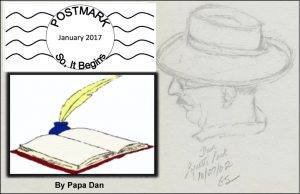 Carl Sandburg—
Carl Sandburg—
Orville Wright1
“Look around, look around,
look how lucky we are
to be alive right now.”
— Eliza Schuyler (from Lin Miranda’s “Hamilton”)
Carl Sandburg
… to be alive right now
These days, like so many others, I am immersed in “Alexander Hamilton.” The musical play has been all the rage — a roaring success on Broadway and now it’s coming to San Francisco! So, in our house, we have been listening to the brilliant hip-hop soundtrack; reading Ron Chernow’s biography of Hamilton (which inspired the musical); reading Lin Miranda’s script and commentary about the creation of the show; AND, yes, we have tickets to the show in May.
When I first heard about the show, I admit to being skeptical — a Broadway musical about the first U.S. Secretary of the Treasury (“the ten-dollar founding father”) set to “hip-hop” music (What is ‘Hip-Hop’? I asked). But once I heard the soundtrack and felt the spirit, I have become a convert. The music and lyrics combined with our founding story and spirited characters are nothing short of thrilling. At its core, “Hamilton” is a classic story of a poor immigrant who showed up at a critical time and made a powerful contribution to American history. In a useful lesson for today’s leaders, he did it by acknowledging his ignorance and educating himself. It is also a story devoid of a ‘Disneyland’ ending (spoiler alert: the hero, the former Secretary of the Treasury, gets killed in a duel by the sitting Vice President of the United States, Aaron Burr, at the dueling ground in Weehawken, New Jersey in 1804, no foolin’).
Twenty-eight years before their duel, as they prepared to join forces in the revolution, Burr gave Hamilton some advice:
“Talk less. Smile more.
Don’t let them know what you’re against
or what you’re for.”
And then, more to the point, in a much faster rhythm:
“I’m with you, but the situation is fraught.
You’ve got to be carefully taught.
If you talk, you’re gonna get shot!”
In the summer of 1776, Hamilton and Burr met in New York as the revolution was in full swing. It was an exciting time. Eliza, one of two Schuyler sisters destined to fall in love with Hamilton (yes, it’s a love story), sums it up:
“Look around, look around
at how lucky we are to be live right now.
in the greatest city in the world!”
How lucky? The excitement and optimism of the time was swirling all around them:
• talk of freedom and independence was everywhere on the streets of their city,
• revolutionary ideas (including the publication of Thomas Paine’s “Common Sense” in January of 1776) were on everybody’s lips (both for and against), and
• it was a time when young people could step forward and make a difference.
It also had a very dark side.
• War was brewing against an empire with the most powerful army and navy in the history of the world, and winter was approaching.
• Slaves were being bought and sold on the streets and wharves of their own city. Slavery had turned out to be the necessary political compromise among the colonies that made the union possible; so, abolitionists like Burr, Hamilton, and their New England compatriots had to swallow hard to believe that they could bend the future to match their principles, but … later.
• New York harbor would soon be flooded with 260 British Navy warships and thirty-two thousand British soldiers. Thousands of their neighbors would be killed in battles fought in their own towns and farmlands. Many would starve during the harsh winter that arrived with the well-fed British army and navy.
So, while these American patriots were optimists, their optimism came at great cost. The King was determined to show no mercy to his disloyal subjects and reclaim his valuable property on the American continent. In the show, the comically mad King George character sings,
“You’ll be back, soon you’ll see,
Yes, you know that you belong to me.
And when push comes to shove,
I’ll send an armed battalion to remind you of my love.”
These revolutionaries knew that many of them would personally suffer the ultimate cost for securing a future for their descendants. And they did.
To be alive right now
How lucky? Fast forward to now — here in 2017. What about us, you and me: the 21st-century descendants of those wild-eyed optimists? What can we learn from reflecting on their experience and ours? Have we preserved their vision of America? Is our vision of the future as bright as theirs? Are our challenges greater? Do we have reason to be hopeful, right now?
• Today, as 2017 dawns, many of our friends, neighbors, and ourselves are doing pretty well. Most statistics say that, overall, our economy is doing OK; the stock market is soaring. Isn’t it?
• Technology and other 21st-century advancements are improving our lives in exciting ways and many aspects of American life give us reason to believe that the future is bright. Right?
• After eight years of an African American President, shouldn’t race relations be encouraging?
• America has the unique distinction of being the world’s dominant superpower. Shouldn’t the founding fathers, and we, be proud and satisfied with the outcome of our revolution?
We are the heirs of the ideals, the optimism, and the governing principles that those brave folks earned for us, right?
–> So, today, can we repeat what Eliza sings early in Act One of “Hamilton?”
“Look around, look around
at how lucky we are to be alive right now.”
Well, sure. That was in Act One. But, before we romanticize the optimism of the revolution, let’s not forget that Thomas Paine had to publish his famous pamphlet encouraging American independence anonymously (see Aaron Burr’s advice to Hamilton, above). The threat was real.
How lucky? Today, as we read the hard, frightening, depressing news of today and listen to each other talk about it, there are growing fears lurking in our future:
• The news media, long the principal vehicle for ensuring an informed electorate, is threatened with access limitations and credibility challenges,
• Long-held American foreign-policy positions and international alliances are now in doubt, apparently without the careful study and decision-making processes we have come to expect,
• The conclusions of science, long held to be the bedrock of our understanding and the foundation of our policy decisions, are being devalued by those taking the reins of power,
• Progress in securing the safety net for retirement income and health care is threatened,
• Human rights, regarding race, gender, and national origin are being weakened by those who seem to have forgotten our long struggle to eliminate discrimination and inequality of all kinds,
• The long-held bipartisan goal of reducing the nuclear danger is now threatened by new leadership that speaks of pursuing a new arms race,
• The goal of government, to support the well-being of all Americans, is now called into question by those who are lining up to run our government for the benefit of the few.
Optimism, Hope in 2017?
In my own fear of what lies ahead, I am reminded to be confident, but patient – in words that Dr. Martin Luther King, Jr. borrowed from a sermon delivered in 1853 by an abolitionist named Theodore Parker, who borrowed it from others before him:
“The arc of the moral universe is long,
but it bends toward justice.”
But patience, while necessary, is not sufficient. Success — as illustrated by Hamilton, Parker, King, and others — is reserved for those who work actively to bend that arc. Those words were used, not at the end of successful struggles but at the beginning of hard times, when success seemed unlikely. Even when we think we’ve made progress, we do not always complete that progress without the inevitable detours. If I try to replicate the optimism of the American revolution, in the face of likely defeat; or try to emulate the hope of abolitionists, in the face bitter compromise; or support the efforts of those pursuing justice, in the face of bigotry; I conclude that 2016 must be considered a detour. It doesn’t have to be a reversal of our progress or an abandonment of the path we thought we were pursuing. We can make it into a detour – but we need to find our way back to that path. The administration of Donald J. Trump is not the end of this story nor the name of a new path to the future; it must be identified as the name of a detour.
OK, I apologize. I thought I could avoid using his name, but I decided that we must name the challenge if we are going to defeat it. We must not speak of Trump like Voldemort (“He-who-must-not-be-named” or “The Dark Lord”) in Harry Potter. The ideas he represents must be faced head-on, opposed, and defeated before we get too far off the path we were on and lose our way. So, as we approach the 2017 inaugural address, let us recall the words of the first inaugural address I watched, from a time in my youth, characterized by more optimism and confidence (and patience) than we might be feeling today:
“All this will not be finished in the first one hundred days.
Nor will it be finished in the first one thousand days . . .
nor even perhaps in our lifetime on this planet.
But let us begin.”
— John F. Kennedy, January 20, 1961
So, now the real work begins.
Along with that work comes some frustration. Those of a certain age remember marching on college campuses and engaging in political action to bring important American values into the light of day — values, among others, like these: equal justice and opportunity under the law, women’s health and reproductive rights, racial integration and civil rights, and decisions about America’s use of military force and the draft. Those battles were successful, in their day. The disappointment, and the reality, is that they must be fought all over again.
So, today — what will it take?
Remember: we know how to do this.
• Some will welcome those who are not welcome, in their own communities.
• Some will contribute time and dollars to help those who will suffer during this detour.
• Some will join movements to influence votes.
• Some will march, when the need arises.
• Those with influence — teachers, lawyers, bartenders, parents, grandparents, neighborhood leaders (you know, you and me) — may find a way to encourage compassion, common sense, and unity in small places among those who will take over when we are gone.
We know how to do this. Let’s start. (The forces on the other side have already started.)
“The only thing necessary for the triumph of evil is for good men to do nothing.”
— Edmund Burke (and others) ![]()
Click here to download a PDF of this article: ConVivio_How_Lucky_to_be_alive_right_now
Thanks to Lauren De Vore for her Editorial advice.
Looking Back at 2016 — Ahead to 2017
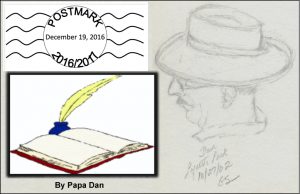
“How wonderful it is
that nobody need wait a single moment
before starting to improve the world.”
— Anne Frank
“The nation which can prefer disgrace
to danger is prepared for a master
and deserves one.”
— Alexander Hamilton
“Yes, we can.
— Barack Obama
2016/2017
Carl Sandburg
What Are Your Feelings About 2016 and Your Outlook for 2017?
(Your responses to the writing challenge: 30 words or less)
Of the fifty-some people who read ConVivio’s “2016” post, ten of you responded to its
30-word writing challenge. I admire the variety of approaches you took: some with a broad national perspective; others with observations focused on their own lives; some optimistic, others not so much; some were quite poetic.
Thanks to everyone who sent a response. Here they are:
==========================================
Overcome the recentness bias this year? I think not.
The election’s outcome could affect us for decades.
Color me cynical and sad for this fine country.
— Katie Walter, Stockton, CA
2016: The rotting corpse of the Democratic Party hopefully saw the error
of moving to the right.
2017: As Daniel said on the series finale of Rectify, “I’m cautiously optimistic.”
— Steve Rubio, Berkeley, CA (typepad.com)
I’m ready to fight against climate change and Trump’s agenda.
— Sonia Faletti, Washington D.C.
Working on myself as an active participant — How can I be more present?
How can I be more aware? How can I be a consistent critical thinker engaging with others?
— Matthew D. Sapone, Aptos CA
Incredible year, many “ups,” one YUGE “down.”
Ups: Changed from large stable company to a startup. Excellent decision!
Loving husband, strong family life, great friendships.
Downer: Won’t say his name.
— Nouanepheng Sapone, Aptos, CA
If you want someone to understand (and adopt) your viewpoint,
you must first listen to and understand theirs.
No more preaching to the choir.
— Lauren de Vore, Livermore, CA
The elections were like a pollution cloud, darkening everything.
Now, every day brings new confirmations of how bad 2017 can be,
for our country and the world. We’re worried.
— Megan Taylor, Bellingham, WA
Unexpected atheism explodes into confidence as the rush of information
restores limbic, and age of majority is reached. Zen heart at 80 beats per
minute while ruffian’s words exile paralysis.
— Jody Tims, Morgan Hill, CA
Daughter Srijana: Nepal, 1998, Scott College August;
her new boyfriend Haaroon: wants medical school;
Me: working CDC with fabulous Director Dr. Frieden;
2 dogs, 2 cats;
Me: nervous re. prez.
— Jean Smith, Atlanta, GA
After the events of the last year, I don’t know how anyone can mount a compelling defense for the theory of evolution. Are we really getting smarter and better? Show me.
— Jeannette Gosnell, Livermore, CA
Men often oppose a thing merely because they have had no agency in planning it,
or because it may have been planned by those whom they dislike.
— Alexander Hamilton, New York, NY
Looking ahead, we always think we are smart enough to predict the surprises.
My hope is that we are wrong; and the surprises will not be the ones we expect.
— PapaDan Sapone, Pleasanton, CA
A PDF of these responses can be downloaded here: Thirty_words_Grace ![]()
What Kind of Year Was 2016?
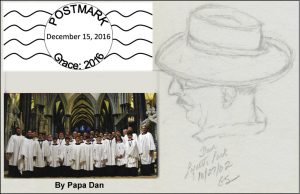 Carl Sandburg—
Carl Sandburg—
Orville Wright
Kitty Hawk, North Carolina
Fall, 1901
If we all worked on the assumption
that what is accepted as true,
is really true,
there would be little hope of advance.
Orville Wright
Carl Sandburg
This time of year, many of us take a moment and ask “What kind of year was this?” Looking back at what I posted on ConVivio at this time last year, the year 2015 was looking pretty grim. Many of us were looking for some encouragement, trying to find an excuse to feel more hopeful. In that end-of-2015 ConVivio post (“Grace”), I described our annual attempt to find some seasonal, yuletide peace, hope, and, well, grace, with the help of Grace Cathedral’s annual Christmas concert of the Men’s and Boys Chorus, Orchestra, and Organ. We followed that same recipe again this year, as we have for two decades.
More on that later.
When we try to look back and decide how we feel about a year, I suppose most of the time we decide that a year was either “terrific,” or “OK” or “terrible” based mostly on how we feel at the moment we are asking the question — near the end of the year. Michael Lewis’ recent book “The Undoing Project” describes the trick that our minds play on us with what he calls the “recentness bias,” in which we are predisposed to use the most recent evidence in drawing our conclusions. We don’t always take into account the entire year. So, I thought — why not try to avoid that “trick” and take a broad look back at some of the things that happened across the entire year and see if we can come up with a reasonable answer. Let’s give it a try and see if it helps. Then, I hope we’ll get to see your answer.
First, the usual stuff that always happens in any year:
The Sundance Film Festival, Super Bowl #50 and Mardi Gras, the Daytona 500, NCAA Final Four, the National Cherry Blossom Festival, the Kentucky Derby, a bunch of Shakespeare festivals, the NBA Finals, the Summer Olympics, the World Series, Albuquerque’s Balloon Festival, and the annual crop of new words entering the our vocabulary— notably: Brexit, Calexit, virtual reality, self-driving cars, fake news … etc. All of that happened as expected.
Second, the “special” stuff that happened in 2016:
In January, an armed militia took over a Wildlife Reserve in Oregon (and dominated the news) for six weeks; we learned that drinking water in Flint Michigan had been poisoning its residents for years; and as the primary elections heated up in March, Hillary Clinton emerged as the Democratic frontrunner causing polls and pundits to agree that her election was all but assured. Two days later, Trump’s campaign was pronounced “doomed” when Mitt Romney called him a “fraud” and a “phony,” saying, “He has neither the temperament nor the judgment to be president.” Well, I don’t have to tell you that … later on … in November … well, you know …
With the coming of a hopeful Spring, marriage equality became a reality in California but also in surprising places like Georgia; the ban on gays in the US military was lifted; and the supposedly paralyzed US Supreme Court struck down a Texas law restricting abortion 5-3. A few large states raised their minimum wage and progress was reported in preserving some endangered wildlife around the world. About that time, Britain did two seemingly contradictory things, perhaps inspired by the 90th birthday of their Queen: they elected the first Muslim mayor of a western city (London) and voted to withdraw from the European Union, reversing a 60-year trend toward European unification.
In June, the Broadway production of Hamilton received 16 Tony nominations, won the Grammy for Best Musical Theater Album, and captured the Pulitzer Prize for Drama
— not bad for a guy of questionable parentage who was killed in a duel 212 years ago.
In two technological triumphs, NASA’s Juno spacecraft entered Jupiter’s orbit after a 1.7-billion-mile, five-year journey to study the planet and a solar-powered plane flew around the world without using a drop of fuel (it took 16 months). Encouraged by the Paris Climate agreement, India reported that 800,000 volunteers worked 24 hours to plant almost 50 million trees on July 11th, beating the Pakistani’s previous one-day record of 1 million set in 2013 — reminding the world that, a month earlier, Donald Trump declared his intention to withdraw the US from the Paris Climate Agreement. (“It’s a hoax. Nobody believes it.”)
Third, some stuff happened that was NOT supposed to happen:
The Cleveland Cavaliers came back from a 3-1 deficit (a historic first), winning their first NBA title by defeating the Golden State Warriors. The National League playoffs between the Giants and the Cubs happened and I don’t want to talk about it. Immediately after that, the Chicago Cubs won the World Series, after waiting 108 years, by beating the Cleveland Indians, who are still waiting after 68 years. (The San Francisco Giants, were supposed to win the World Series this year and I don’t want to talk about THAT either.) Then, Americans elected a president who promised to Make American Great Again by employing a unique strategy … (and we’ve already talked about that too much, haven’t we?) Two weeks later, the Dow Jones responded to doomsday predictions after the Brexit and Trump wins and topped 19,000 for the first time (begging the question “What does it mean?”). Finally, in this “not supposed to happen” category, Gwen Ifill, a longtime PBS News anchor, died at the age of 61. Those who admire real news and respectful discourse mourned.
Finally, two more things happened that mattered to me:
1. I retired from a long career and was given a wonderful party (thank you Jessica & Brytni);
2. The 2016 Grace Cathedral Christmas Concert restored the uplifting and grace-filled themes that have inspired audiences (including Gretta and me) throughout its long and generous history (see https://convivio-online.net/grace/). Grace Cathedral’s musical signature, “Sleeps Judea Fair,” was again reassuring, peaceful, and hopeful — filling that magnificent cathedral with its transformational sound and powerful spirit. The blending of the mature and youthful voices and faces of the men and boys in that chorus, transported us all to a place we came there hoping to experience. The dissonance we heard and felt last December was gone — for now. I must admit that we needed that encouragement to look forward with hope to the year ahead. They came through for us and, for that, I am thankful.
OK, So How Do We Feel About 2016, Really?
Well, now that you’re really annoyed that I left out your favorite “most important” event from 2016 (and I know you were looking for it), it’s time to commit: how do we really feel about the year that’s ending and prospects for the year ahead? Again, I’m trying to avoid that “recentness bias” — you know, trying to ignore the feeling that the events of the past six weeks must completely overshadow our judgement about the whole year and color our anticipation of 2017. The year we’re just now completing suggests the likelihood that 2017 will bring some surprises. So, I offer two things:
One — A Request for 30 words from you: I am asking you (yes, you) to put your thinking hat on (no, not THAT hat) and try to sum up your feelings about 2016 and your outlook for 2017 in 30 words or less and send them to me. It’s a writing challenge — you can do it. Many of you have demonstrated that you are very clever with words. If you take a few minutes and send me your words, I will publish them here on ConVivio (with your name if you give me permission). Thirty words. Can you do it? (Repeat after me: “Yes, We Can.”)
Two — I offer my own 30 words anticipating how 2016 will lead to 2017:
Looking ahead, we always think we are smart enough to predict the surprises.
My hope is that we are wrong; and the surprises will not be the ones we expect.
I wish you all Happy and Hopeful Holidays!
PapaDan Download a pdf of this post: Grace_2016_ConVivio_Final![]()
A Good Man
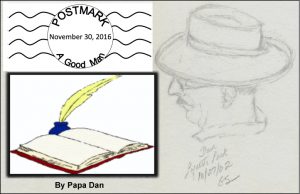
Carl Sandburg—
“The human race has one really effective weapon,
and that is laughter”
Few things are harder to put up
with than the annoyance
of a good example.”
“Forgiveness is the fragrance
that the violet sheds
on the heel that has crushed it.”
— Mark Twain
Carl Sandburg
Occupant
1600 Pennsylvania Avenue NW
Washington DC 20500
January 19, 2017
Dear Sir,
It has come to my attention — well, I guess it’s just starting to sink in — that you are about to leave a job that has kept you constantly in the public eye for the past eight years. While much attention has been focused on the next guy, I was thinking that it would be polite to drop you a note to say . . . well . . . thank you.
People have been talking about the job you did. So, sure, we can talk about that first, if you like; but I have something more important in mind; and we’ll get to that. So, first — how’d you do? Here’s a list of the usual kinds of things — and, as you know, some people consider these successes and others call them failures. You:
- Avoided a deep recession that you inherited when you first showed up for work
- Rescued the US automobile industry
- Ended the US formal combat role in Iraq
- Banned torture and brought Osama bin Laden to justice
- Initiated a program that insures about 20 million people who couldn’t get healthcare
- Appointed Sonia Sotomayor and Elena Kagan to the Supreme Court
- Supported marriage equality
- Initiated heavy investment in renewable energy technologies
- Crafted a multinational agreement to end Iran’s nuclear weapon program
- Led 120 nations to agree to reduce emissions that threaten the worldwide climate
- Opened the US to Cuba
You know, the usual kinds of things. Now, some want to quibble about that list; but as I mentioned, I have something more important to talk with you about.
I want to thank you for being . . . you know . . . A Good Man.
Now, I grant you that being a “good man,” by some agreed-upon definition, has never been a job requirement in your profession. We’ve had lots of the other kind – we seem to vacillate on that score. Over time we’ve had to look the other way on a lot of things. But in your case, sir, we can look you in the eye without being embarrassed.
I admit that all of that economics and foreign policy stuff are all pretty standard for a guy in your profession; but a person in your job has other impacts that are sometimes overlooked. I know it seems like a small thing, but you have had this habit of thinking first before you talk; and after you do that, the things you say come out in complete sentences and paragraphs, which I tend to enjoy. And, when those ideas get translated around the world, those clear sentences can be pretty useful.
I also appreciate that you don’t stomp around and lose your temper, even when they say rude things about you that aren’t true. You seem to have overlooked even the worst of the lies. You don’t seem to get into the “revenge thing” that some others do. I appreciated your comment when some people predicted that the election results were “the end of the world.” You lowered the temperature a bit and quoted Yogi Berra: “I always say that the only thing that is the end of the world is the end of the world.” Even when guys tell gullible people that you weren’t born in the US, I’ve heard you make jokes about it. Oh, yes that reminds me — guys in your profession are not usually good at telling jokes; but you have some real comic timing. I still remember during a debate, Mitt Romney kept making a face and sputtering about “Obamacare” with obvious distaste. You mentioned that it was called “The Affordable Care Act,” but you looked at him and said, “Hmmm. Obamacare, I like it. I think we should call it that.” Even Mitt had to laugh.
I suppose the thing I admire most is that your time on the job featured eight years without a hint of scandal — that’s not normal for guys in your profession. You have been a steady husband and father and have behaved with a combination humor and dignity, even in the face of public insults. Some of us forget that a guy in your job serves as a role model for other people, whether they want to or not, notably for little boys who look around to figure out how grow up to become a man. Other public figures don’t seem to have an eye for that. In your case, we can feel comfortable that little kids might look at you and say to themselves, “I want to be like him.” OK, I know there are those, like Mark Twain, who said “Few things are harder to put up with than the annoyance of a good example.” But, you know, I have grandchildren. I hope they’ve been watching.
So, I want to say ‘Thank You.’ All of that policy stuff is a subject for another day; but today I want to thank you for being a good man on the world stage, personally representing us in a way that made me proud. It’s not mentioned in the news much; but it’s worth a lot to me.
Regards to you and your family,
PapaDan Download a PDF of this post: convivio_agoodman_nov30_2016![]()
Where to? What Next?
My Syllabus
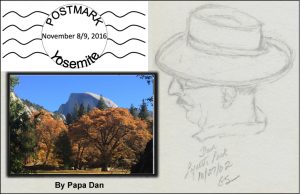
Where to?
Carl Sandburg—
“The people will live on;
The learning and blundering people
will live on.”
“They will be tricked and sold,
and again sold.”
“You can’t laugh off
their capacity to take it.”
— Carl Sandburg
Carl Sandburg
November 8, 2016
As I write this, I am sitting in a chair, surrounded by the spectacular beauty of Yosemite. Looking up from my pen and notebook, the carved granite of Half Dome stands directly in front of me; I can hear the constant roar of Yosemite Falls from my left; and the silent flow of the Merced River drifts downstream ten feet to my right.
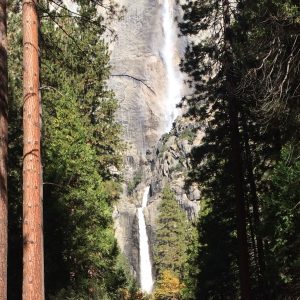
Yosemite Falls
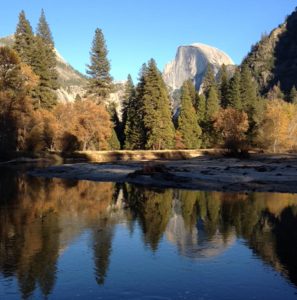
Half Dome

The Merced River
There is a spirit here — a spirit that (or who) inspires big ideas.
Today is a big day. Today is Election Day (outcome yet to be determined); but this piece is not about the election. It is about something much bigger: It is about you and me, you know, America. In the 1830s, Alexis de Tocqueville defined America as “the great experiment in democracy on the North American continent” with grand, historic intentions. And, as I mentioned, America — that is, you and me — is much more than elections; and it is also much more than the good intentions that initiated that great experiment. Henry Ford once famously said, “You don’t build a reputation on what you are going to do” (I read it on my tea bag this morning). We are what we do; and that’s how we must be remembered.
So, what have we done? “We” — that is, America before you and me — built a nation on some important ideas that had been brewing in Europe for quite some time, and “we” applied those ideas in an experiment. “We, the People,” applied them to the lives of some of the people who lived on this continent; allowed lots of people from around the world to come here to participate; and actually welcomed many of them — not all of them, and some more than others. And, while we were doing that, “we” (again, before you and me arrived on the scene) “we” built great things on those big ideas:
- government institutions,
- institutions of justice and law,
- practices in support of banking and commerce,
- transportation systems,
- foundations to encourage the arts and sciences,
- technology to change the world over and over,
- systems to enable a historic level of prosperity,
- traditions for how we treat one another,
- and much more.
Along the way, we fostered an adventurous spirit that expanded the great experiment — America — across the length and breadth of the continent and, by doing all that, we built a reputation that influenced the lives of people around the world.
Yes, that was a lot of doing on which to build a reputation.
Now, granted, the expansion across the continent incorporated/appropriated a lot of land and resources that had for a long time ‘belonged’ to other people; and, granted, the prosperity we created was made available to some of us and not others; and the worldwide influence America wielded resulted in both good and ill; BUT …
Here we stand today — standing on the shoulders of giants (well, OK, some of them were giants and some of us made it to their shoulders). Nevertheless, here we stand, here in the twenty-first century, you and me. We are the heirs of what has been passed down to us and the stewards of all that America IS.
So, now that American IS you and me (yours and mine), what have we done? And what are we doing?
Remember, this is NOT about the election, honest, I promised. Besides, we haven’t actually had the election yet — voting is still in progress cross the land as I scribble these words here beside the river; but we have been doing some things as stewards and owners of America — “We the People,” collectively — that really do define the time in which we live and the variety of experiences that we are all having. Those of us who read and listen have been hearing a lot of the details by which the news media keeps score of how we are doing:
- more people are employed today than were working a year or two ago,
- the average income of Americans has increased gradually in the past year or two,
- the stock market, although fluctuating with the news cycle, is at an all-time high,
- our achievements in science and technology are breathtaking,
- there are more students attending American universities than ever before,
- and much more.
AND, as has always been the case, America and its institutions face more dramatic and difficult challenges than ever before:
- the benefits of American prosperity are shared unevenly, with more wealth at the top and more people at the bottom;
- people less fortunate need more help than ever;
- in spite of historic advancements by people of color throughout our society, more violent incidents of racial animosity are reported in the news almost every day, many of which include deadly encounters between law enforcement and minority citizens.
One observation every American seems to agree with is that “we” are more divided ever.
Technology enables our social interactions to be instantaneously and widely distributed — that’s both the good news and the bad news — allowing us to instantly distribute far and wide the most beautiful and the most vile ideas. We try to use that capability to help us discuss the collective decisions we have to make; and then we have elections — like today.
A famous line, attributed to several of our forebears reminds us that:
“Democracy is that form of government in which the people get the government they deserve.”
As we wait for the results of today’s election, we might well ask, what do we deserve? Whether we like it or not, I suppose we will see the answer to that question in the election returns. Will we all agree that we deserve what we get? Perhaps we will look to those who have gone before us for guidance. We have been warned about what we might deserve.
Thomas Jefferson: “I tremble for my country when I consider that God is just.”
So, do our forebears teach us what to do when we are disappointed? On that subject., one of the most important speeches of our time is remembered by only a few. After losing his challenge of the results of the Florida vote count (he lost by 533 votes) in a decision by the U.S. Supreme Court (on a 5-4 vote), Al Gore reminded us, on December 13, 2000, of the longstanding importance of the peaceful transfer of power:
“Let there be no doubt, while I strongly disagree with the court’s decision, I accept it. It has been resolved as it must be resolved, through the honored institutions of our democracy.”
This week, Al Gore spoke to a ‘get out the vote’ rally: “Every vote counts. Trust me on this.”
So, after listening to the rhetoric over the past few weeks, can we be sure that wisdom passed down to us about the ‘peaceful transfer of power’ will prevail at the end of this day?
So, how’d we do? Tomorrow will tell the story.
November 9, 2016
This morning, we took a walk from Yosemite Lodge across Cook’s Meadow to the bridge on the Merced River. A woman pointed up at a tree, “Look,” she said, “an American eagle!” Sure enough. There he was, perched high in a tree, his large white head turned to one side of his dark torso the way we always see him when he plays his role as the symbol of our nation. Question: was he here to bring a message of encouragement to us up here in the mountains or did he come here to escape what had happened down in ‘the world below?’ OK, silly question — he LIVES up here in the mountains and doesn’t much care what happens down in ‘the world below.’ But for us, the symbolism was strong.

An American Eagle
OK, so we learned what had happened yesterday down in the world below. It was a shock, to say the least. Some were asking, can we survive this? But, as I said, this piece of writing is not about the election. It asks the question – in light of where “we” have been and what we have done to get where we are today, what are we supposed to do now? Regardless of which way the course of human events takes us, what are our responsibilities going forward? Can “We the people” (you know, you and me, America) survive and prosper even when we make big mistakes and when things don’t go the way we had hoped?
Fortunately, there are optimists among our forebears who reach out from their own difficult days to offer hope to us in ours. Carl Sandburg is one of those. Below are words from his poem about what “the people” do in times of crisis.
The People Will Live On — Carl Sandburg, 1936
“The people will live on.
The learning and blundering people will live on.
They will be tricked and sold and again sold
And go back to the nourishing earth for rootholds,
The people so peculiar in renewal and comeback,
You can’t laugh off their capacity to take it.
In the darkness with a great bundle of grief
The people march . . . ‘Where to? What next?’ “
We have begun hearing from people who are concerned about the effects of yesterday’s outcome. A friend of mine, seriously depressed about yesterday’s news, told me in an e-mail that she decided that she must do something. Whining about our disappointment is not enough, she reasoned. She plans to volunteer where she might be needed to help mitigate the effects of what happened yesterday. Another friend told Gretta “I don’t know if I can get over this.” Gretta’s answer: “Maybe we’re not supposed to get over it. Maybe we have to accept it and find something we can do to help. People are going to need help.” Others have suggested that it is time to increase our contributions to organizations that can help those who are going to suffer from the news — immigrants, those who will lose their health care, kids in school programs that will be cut, those who receive necessary assistance from government programs threatened by yesterday’s news, those who had hoped that “we the people” would try to mitigate global warming — you know, you and me: America. There are many choices one can make. As a first step, we have decided to increase some of our contributions. These are some of our favorites: The American Civil Liberties Union, The Natural Resources Defense Council, Planned Parenthood, The Sierra Club, and The Yosemite Conservancy. Many other approaches are available — an organization that supports the homeless? A school district, maybe even one in another town? I suspect that we all have ideas to add to that list.
Yesterday, November 8, 2016, “We, the people” spoke in the form of 290 electoral votes; and today, “we the people” have the opportunity to speak in other ways as well.
Looks like some difficult times ahead for a lot of people.
What must I do to help?
What must you?
Download a PDF of this piece: where_to_what_next_convivio![]()
Personal Syllabus — Lauren de Vore
My Syllabus

My Personal Syllabus
The Personal Syllabus Exercise:
“What are the books, stories, characters,
and ideas that help form a person?”
~Lauren de Vore~
My Personal Syllabus
~Lauren de Vore~
When I read The New York Times recent Op-Ed piece, “My Syllabus, My Self,” by Christy Wampole, I was caught by her premise that a syllabus is more than a reading list, that it’s “a personal and political statement.” I wondered, what would I include in a personal syllabus? Could I reach back across the years and identify the books and other pieces that have influenced me, that have shaped me? Could I put together a list such that someone who read those pieces could gain an understanding of me beyond what I put forward for the world to see?
Although there are myriad other “influencers” that have contributed to making me “me,” from music and artwork to movies, seminal events and remarkable people, for the purposes of this exercise, I limited myself to written pieces. In putting together my syllabus, the hard part was (1) separating favorite pieces from those that influenced me and then (2) trimming the list to a reasonable length. I kept thinking, “Oh, I should add that…and that…and that…” In the end, I offer a dozen or so poems and quotes and another dozen or so books. The first four (the Milton, Wilcox, Guest, and Whittier pieces) were regularly quoted from during my growing-up years; the others I collected along the way in the decades that followed. You probably already know some of these; for the others, who knows, you may be intrigued enough to go look them up.
Poems and Quotations
“Paradise Lost” (John Milton, Book 1)
“The mind is its own place, and in itself
Can make a Heaven of Hell, a Hell of Heaven.”
This is particularly compelling when you realize that this is Lucifer speaking shortly after he’s been expelled from Heaven …
“The Winds of Fate” (Ella Wheeler Wilcox)
One ship drives east and another drives west
With the self-same winds that blow.
Tis the set of the sails
And not the gales
Which tells us the way to go.
Like the winds of the seas are the ways of fate,
As we voyage along through the life:
Tis the set of a soul
That decides its goal,
And not the calm or the strife.
“Myself” (Edgar Albert Guest)
I have to live with myself and so
I want to be fit for myself to know.
I want to be able as days go by
Always to look myself straight in the eye;
I don’t want to stand with the setting sun
And hate myself for the things I have done.
I don’t want to keep on a closet shelf
A lot of secrets about myself
And fool myself as I come and go
Into thinking no one else will ever know
The kind of person I really am;
I don’t want to dress up myself in sham.
I want to go out with my head erect,
I want to deserve all men’s respect;
But here in the struggle for fame and wealth
I want to be able to like myself.
I don’t want to look at myself and know
Than I’m bluster and bluff and empty show.
I never can hide myself from me
For I see what others may never see
And I know what others may never know.
I never can fool myself and so,
Whatever happens, I want to be
Self-respecting and conscience free.
Quotes/Poems (John Greenleaf Whittier)
“If thou of fortune be bereft,
And in thy store there be but left
Two loaves, sell one, and with the dole
Buy hyacinths to feed thy soul.”
“Of all sad words of tongue or pen,
The saddest are these, ‘It might have been.”
“O Me! O Life!” (Walt Whitman, Leaves of Grass, 1892)
Oh me! Oh life! of the questions of these recurring,
Of the endless trains of the faithless, of cities fill’d with the foolish,
Of myself forever reproaching myself, (for who more foolish than I, and who more faithless?)
Of eyes that vainly crave the light, of the objects mean, of the struggle ever renew’d,
Of the poor results of all, of the plodding and sordid crowds I see around me,
Of the empty and useless years of the rest, with the rest me intertwined,
The question, O me! so sad, recurring—What good amid these, O me, O life?
Answer.
That you are here—that life exists and identity,
That the powerful play goes on, and you may contribute a verse.
“The Need of Being Versed in Country Things” (Robert Frost, 1920)
The house had gone to bring again
To the midnight sky a sunset glow.
Now the chimney was all of the house that stood,
Like a pistil after the petals go.
The barn opposed across the way,
That would have joined the house in flame
Had it been the will of the wind, was left
To bear forsaken the place’s name.
No more it opened with all one end
For teams that came by the stony road
To drum on the floor with scurrying hoofs
And brush the mow with the summer load.
The birds that came to it through the air
At broken windows flew out and in,
Their murmur more like the sigh we sigh
From too much dwelling on what has been.
Yet for them the lilac renewed its leaf,
And the aged elm, though touched with fire;
And the dry pump flung up an awkward arm;
And the fence post carried a strand of wire.
For them there was really nothing sad.
But though they rejoiced in the nest they kept,
One had to be versed in country things
Not to believe the phoebes wept.
“Nothing Gold Can Stay” (Robert Frost, 1923)
Nature’s first green is gold,
Her hardest hue to hold.
Her early leaf’s a flower;
But only so an hour.
Then leaf subsides to leaf.
So Eden sank to grief,
So dawn goes down to day.
Nothing gold can stay.
“The Summer Day” (Mary Oliver, 1992)
Who made the world?
Who made the swan, and the black bear?
Who made the grasshopper?
This grasshopper, I mean—
the one who has flung herself out of the grass,
the one who is eating sugar out of my hand,
who is moving her jaws back and forth instead of up and down—
who is gazing around with her enormous and complicated eyes.
Now she lifts her pale forearms and thoroughly washes her face.
Now she snaps her wings open, and floats away.
I don’t know exactly what a prayer is.
I do know how to pay attention, how to fall down
into the grass, how to kneel down in the grass,
how to be idle and blessed, how to stroll through the fields,
which is what I have been doing all day.
Tell me, what else should I have done?
Doesn’t everything die at last, and too soon?
Tell me, what is it you plan to do
with your one wild and precious life?
“Kissing a Horse” (Robert Wrigley, 2006)
Of the two spoiled, barn-sour geldings
we owned that year, it was Red—
skittish and prone to explode
even at fourteen years—who’d let me
hold to my face his own: the massive labyrinthine
caverns of the nostrils, the broad plain
up the head to the eyes. He’d let me stroke
his coarse chin whiskers and take
his soft meaty underlip
in my hands, press my man’s carnivorous
kiss to his grass-nipping upper half of one, just
so that I could smell
the long way his breath had come from the rain
and the sun, the lungs and the heart,
from a world that meant no harm.
“Touched by an Angel” (Maya Angelou, 1995)
We, unaccustomed to courage
exiles from delight
live coiled in shells of loneliness
until love leaves its high holy temple
and comes into our sight
to liberate us into life.
Love arrives
and in its train come ecstasies
old memories of pleasure
ancient histories of pain.
Yet if we are bold,
love strikes away the chains of fear
from our souls.
We are weaned from our timidity
In the flush of love’s light
we dare be brave
And suddenly we see
that love costs all we are
and will ever be.
Yet it is only love
which sets us free.
“The honorary duty of a human being is to love.” —Maya Angelou
“All my work, my life, everything I do is about survival, not just bare, awful, plodding survival, but survival with grace and faith. While one may encounter many defeats, one must not be defeated.” —Maya Angelou
“No man ever steps in the same river twice, for it is not the same river and he is not the same man.” —Heraclitus of Ephesus
Books
Black Like Me (John Howard Griffin, 1961)
A real eye-opener for an 11-year-old white girl living in suburban California.
Messages from My Father: A Memoir (Calvin Trillin, 1997)
“You might as well be a mensch.”
Alexander and the Terrible, Horrible, No Good, Very Bad Day (Judith Viorst, 1972)
“Some days are like that, even in Australia.”
The Pastures of Heaven (John Steinbeck, 1932)
Striving , ever striving to achieve unfulfillable aspirations (for love, connection, belonging, etc.) yet failing due to personal foibles or weaknesses—an everyman version of the classic hero myth.
The Red Pony (John Steinbeck, 1933)
“The Gift”: The hazard of loving…as soon as you admit you want something or care for somebody or something, it’s taken from you.
“The Promise”: Be very careful what you wish for; it often comes in ways you didn’t expect and with a cost far higher than you anticipated.
“Junius Maltby”: The soul-crushing effect of accepting another’s view of yourself instead of your own, of following the dictates of convention instead of being true to yourself.
Siddhartha (Herman Hesse, 1922)
“What could I say to you that would be of value, except that perhaps you seek too much, that as a result of your seeking you cannot find…”
“Words do not express thoughts very well. They always become a little different immediately after they are expressed, a little distorted, a little foolish. And yet it also…seems right that what is of value and wisdom to one man seems nonsense to another.”
1984 (George Orwell, 1949)
Newspeak, the fragility and strength of language, the idea that by eliminating words, their very concepts can be eliminated—particularly relevant vis a vis today’s thin skins combined with the current intolerant obsession with political correctness.
Tales from Shakespeare (Charles and Mary Lamb)
Planted the seeds for a love of Shakespeare, playing with words, live theater…
The Winter’s Tale: “Exit, pursued by bear.”
Hamlet:
“A man may fish with the worm that hath eat of a king, and eat of
of the fish that hath fed of that worm. … What dost you mean by
this? … Nothing but to show you how a king may go a progress
through the guts of a beggar.”
Penseés (Blaise Pascal, 1688)
The great gamble—believe/live as if God exists and he does, you have gained everything; believe and he doesn’t exist, you have lost nothing… I vehemently disagree—you have lost dreadfully if you have not valued this life and lived it fully.
Black Beauty (Anna Sewell, 1877)
“…there is no religion without love, and people may talk as much as they like about their religion, but if it does not teach them to be good and kind to man and beast, it is all a sham…”
Bulfinch’s Mythology: The Age of Fable, or Stories of Gods and Heroes
Don’t piss off the gods.
Into the Woods (Stephen Sondheim and James Lapine, 1986)
Beware what comes after “happily ever after.”
Candide (Voltaire, 1759)
“All is for the best, for we live in the best of all possible worlds.”
“We must cultivate our own gardens.”
My Required Reading List
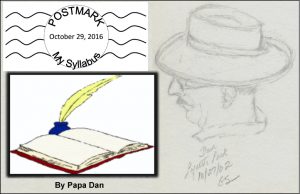
My Syllabus
“Be as careful of the books you read
as of the company you keep;
for your habits and character will be as much influenced by the former as the latter.”
— Paxton Hood
“Books don’t change people, paragraphs do; sometimes even sentences.”
— John Piper
What are the books, stories, characters, and ideas that help form a person?
My writing colleague, Lauren de Vore, recently directed my attention to an Op-Ed piece in The New York Times written by Christy Wampole of “The Stone.” It is titled “My Syllabus, My Self.” It got my attention in a big way (notice I didn’t use the recently made-up bogus word “bigly”) and I am hoping it will interest you as well.
–> What is a “syllabus?” If you recall, when you walked into a college class on the first day, the professor would hand out the syllabus of the course. Back in those days, we knew it as the required reading list of the course; but in the years between those days and these, it has come to mean much more. Ms. Wampole’s definition is described in detail at: http://www.nytimes.com/2016/10/17/opinion/my-syllabus-my-self.html?emc=eta1, and it’s worth reading. She wrote, “It’s more than a reading list. It’s a personal and political statement.”
For my purpose today, I’d like to use part of her definition – a compilation of the books, stories, paragraphs, sentences, songs, and characters that have contributed ideas to making someone into the person they have become. Try answering two questions for yourself: If you made a list of books you have read, words you have heard, ideas from movies, song lyrics, and/or characters that have meant a lot to you, and identified WHY they matter to you, even if the list were incomplete, would that help someone know more about who you are?
I realize, of course, that such an exercise would be incomplete. It has to be. The forces that shape each of us are complicated, interrelated, maybe even contradictory, they probably span a long period of time, we can’t remember them all, and they can’t easily be put into a complete and tidy list. Even if I tried to do it, I reasoned, as soon as I showed it to someone I’d have to quickly say, “Oh, I left out some important things. There could be lots more.”
Well, I’ve taken a shot at making such a list — anyway — and my first reaction is . . . well, I left out some important things. There could be lots more.”
In my case, I narrowed it to a fairly short list of novels, plays, poems, and the ideas found in them. After my first try, all I can say is that it isn’t a complete picture; but it does reveal some things that matter to me and, well, could give someone the opportunity to explore those ideas further if they wanted to. In addition to the titles, I decided to quote some words from each of them that matter to me (brief excerpts), and I’ve identified a “Message” — that is, a single idea that summarizes what matters to me about it.
So, here goes . . .
If this seems like an interesting project, in whatever form that makes sense to you — even if it is just a list of titles or ideas — I encourage you to share it with us. With your permission, I will publish it here on ConVivio. Anonymously, if you want. Might be interesting.
Dan’s (Incomplete) Required Reading List
The Plague — Albert Camus, 1947
“I have no idea what’s awaiting me, or what will happen when this all ends. For the moment I know this: there are sick people and they need curing.”
“For who would dare to assert that eternal happiness can compensate for a single moment’s human suffering.”
“What’s true of all evils in the world is true of plague as well. It helps men to rise above themselves.”
“The evil that is in the world almost always comes of ignorance.”
“The most incorrigible evil being that of an ignorance that fancies it knows everything and therefore claims for itself the right to kill.”
–> The MESSAGE: “We learn in time of pestilence: there are more things to admire in men than to despise.”
It Can’t Happen Here — Sinclair Lewis, 1935
“Why, America’s the only free nation on earth. Besides! The country’s too big for a revolution. No, no! Couldn’t happen here!”
“Said Doremus, “Hm. Yes, I agree it’s a serious time. With all the discontent there is in the country to wash him into office, Senator Windrip has got an excellent chance to be elected President, and if he is, probably his gang of buzzards will get us into some war, just to grease their insane vanity and show the world that we’re the toughest nation going. And then I, the Liberal, and you, the Plutocrat, will be led out and shot at 3 A.M. Serious? Huh!”
–> THE MESSAGE: “First you are afraid, then you carry a gun.”
The Odyssey — Homer, late 8th century BC
(Odysseus:) “We are Achaians coming from Troy, beaten off our true course by winds from every direction across the great gulf of the open sea, making for home, by the wrong way, on the wrong courses. So we have come. So it has pleased Zeus to arrange it.”
“(Zeus): ‘Oh for shame, how the mortals put the blame on us gods, for they say evils come from us, but it is they, rather, who by their own recklessness bring sorrow beyond what is given.”
–> The MESSAGE: “Over a long journey, loyalty, self-control, perseverance, and compassion may be the keys to a successful return ‘home.’ ”
The Princess Bride — William Goldman, 1973
“Inigo Montoya: Hello! My name is Inigo Montoya! You killed my father! Prepare to die!
Count Rugen: Stop saying that!
Inigo Montoya: HELLO! MY NAME IS INIGO MONTOYA! YOU KILLED MY FATHER! PREPARE TO DIE!
Inigo Montoya: Offer me money, to save yourself.
Count Rugen: Yes!
Inigo Montoya: Power, too, promise me that.
Count Rugen: All that I have and more. Please…
Inigo Montoya: Offer me anything I ask for.
Count Rugen: Anything you want…
Inigo Montoya: I want my father back, you son of a bitch!”
“Vizzini: You fell victim to one of the classic blunders—the most famous of which is, “Never get involved in a land war in Asia”—but only slightly less well-known is this: “Never go against a Sicilian when death is on the line”! Ha ha ha ha ha ha ha ha ha … ”
“The Grandson: Grandpa, maybe you could come over and read it again to me tomorrow.
The Grandpa: As you wish.”
–> The MESSAGE: Sometimes you have to pass through the fire swamp to get where you need to go.
The Moon Is Down — John Steinbeck, 1941
“We have defeated them.” . . . Defeat is a momentary thing. A defeat doesn’t last.”
“[The people] are orderly under their own government. I don’t know how they will be under yours.”
“The people don’t like to be conquered. Things are going to happen. It is a great mystery that has disturbed rulers all over the world — how the truth of things fights free of control.”
“Fear began to grow in the conquerors, a fear that it would never be over. A fear that one day they would crack and be hunted through the mountains like rabbits. For the conquered never relax their hatred.”
“We told our soldiers that they were brighter and braver than other young men. It was kind of a shock to them to find out that they aren’t a bit braver or brighter than other young men.”
“They think that just because they have only one leader and one head, we are all like that. They know that ten heads lopped off will destroy them; but we are a free people; we have as many heads as we have people, and in time of need leaders pop up among us like mushrooms.”
“Free men cannot start a war, but once it is started, they can fight on in defeat. Herd men, followers of a leader, cannot do that and so it is always the herd men who win battles and the free men who win wars. You will find that is so, sir.”
“If I tell them not to fight; they will be sorry, but they will fight. If I tell them to fight, they will be glad, and I who am not a very brave man will have made them a little braver. You see, it is an easy thing to do, since the end for me is the same.”
The Mayor’s wife: “I wish you would tell me what all this nonsense is all about.”
The Mayor: “It is nonsense, dear.”
The Mayor’s wife: “But they can’t arrest the mayor.”
The Mayor: “No, they can’t arrest the Mayor. The Mayor is an idea conceived by free men. It will escape arrest.”
The Mayor: “Yes, the debt shall be paid.”
–> The MESSAGE: “My people don’t like to have others think for them.”
The Great Gatsby — F. Scott Fitzgerald, 1925
Nick: “If personality is an unbroken series of successful gestures, then there was something gorgeous about him.”
Daisy: “Do you ever wait for the longest day of the year and then miss it? I always wait for the longest day of the year and then miss it!”
Nick: “Gatsby believed in the green light, the orgiastic future that year by year recedes before us. It eluded us then, but that’s no matter—to-morrow we will run faster, stretch out our arms farther. . . . And one fine morning——“
Nick: “His dream must have seemed so close that he could hardly fail to grasp it. He did not know that it was already behind him.”
Nick: “And as the moon rose higher the inessential houses began to melt away until gradually I became aware of the old island here that flowered once for Dutch sailors’ eyes – a fresh, green breast of the new world. Its vanished trees, the trees that had made way for Gatsby’s house, had once pandered in whispers to the last and greatest of all human dreams; for a transitory enchanted moment man must have held his breath in the presence of this continent, compelled into an aesthetic contemplation he neither understood nor desired, face to face for the last time in history with something commensurate to his capacity for wonder.”
–> The MESSAGE: “So we beat on, boats against the current, borne back ceaselessly into the past.”
Lost Horizon — James Hilton, 1933
“The will of God or the lunacy of man – it seemed that you could take your choice, if you wanted a good enough reason for most things. Or, alternatively, the will of man and the lunacy of God.”
“The jewel has facets; and it is possible that many religions are moderately true.”
“We have reason. This vision was so vivid and so moving that I determined to gather together all things of beauty and culture that I could and preserve them here, in Shangri-la, against the doom toward which the world is rushing. Look at the world today. A scurrying mass of bewildered humanity crashing headlong against each other. The time must come, my friend, when brutality and the lust for power must perish by its own sword. For when that day comes, the world must begin to look for a new life. And it is our hope that they may find it here.”
“If I could put it into a very few words, dear sir, I should say that our prevalent belief is in moderation . . . the virtue of avoiding excesses of all kinds—even including, if you will pardon the paradox, excess of virtue itself.”
–> The MESSAGE: “The time must come when brutality and lust for power must perish by its own sword.”
The Swerve — Stephen Greenblatt, 2011
“Something happened in the Renaissance, something that surged up against the constraints that centuries had constructed around curiosity, desire, individuality, attention to the material world, the claims of the body.”
“Just when the gods had ceased to be, and the Christ had not yet come, there was a unique moment in history, between Cicero and Marcus Aurelius, when man stood alone.”
“If you can hold on to and repeat to yourself the simplest fact of existence — atoms and void and nothing else, atoms and void and nothing else, atoms and void and nothing else– your life will change … and you will be freed from the terrible affliction – what Hamlet many centuries later described as ‘the dread of something after death/the undiscovered country from which/no traveler returns.”
“I am,” Jefferson wrote to a correspondent who wanted to know his philosophy of life, “an Epicurean.”
–> The MESSAGE: “It became possible – never easy, but possible … to find the mortal world enough.”
Le Morte d’Arthur (“Camelot”) — Thomas Mallory (and many others), 15th century (and earlier and later)
From Mallory (Translated)
“Whoso pulleth out this sword of this stone and anvil, is rightwise king born of all England.”
Arthur: “I have promised to do the battle to the uttermost by the faith of my body, while me lasteth the life, and therefore I prefer to die with honour than to live with shame.”
“Yet some men say in many parts of England that King Arthur is not dead, but had by the will of our Lord Jesu into another place; and men say that he shall come again, and he shall win the holy cross. I will not say it shall be so, but rather I will say: here in this world he changed his life.”
From “Camelot,” Lerner and Lowe, 1960
Arthur: “By God, I shall be a king. This is the time of King Arthur when violence is not strength and compassion is not weakness!”
Arthur: “I have stumbled on my future. I-I-I’ve done – the right thing!”
Lancelot Du Lac: “Did you ever doubt it, your majesty?”
Arthur: “Oh, of course. Of course. Only fools never doubt.”
Merlin: “Thinking, boy, is something you should definitely get into the habit of doing, as often as possible. Thinking helps in everything but love. Love is a sort of seventh day, so thinking can rest.”
Arthur: “Ginny, suppose we create a new order of chivalry? A new order where might is only used for right! To improve instead of to destroy. Look, we’ll invite all the knights, all the kings of all the kingdoms, to lay down their arms to come and join us. Oh yes, Ginny. I will take one of the large rooms in the castle, put a table in it, and all the knights will gather at it.
Guinevere: And do what?
Arthur: Talk across it. Debate. Make laws. Plan improvements!
Guinevere: But, Arthur, do you think all the knights will ever want to do such a ridiculously peaceful thing?
Arthur: We’ll make it a great honor. Very fashionable! Everyone will want to join! Only now, the knights will whack only for good. Might – FOR – right. That’s it, Ginny. Not might IS right. Might – FOR – Right!
Guinevere: It’s very original.
Arthur: Yes. Yes-Yes. And civilized, Ginny.
Guinevere: Arthur, it will have to be an awfully large table. Won’t there be jealousy? All the knights will be claiming superiority and want to sit at the head.
Arthur: We’ll make it – a round table. So, there is no head.
Pellinore: (After newly knighted Young Tom of Warwick leaves): “Arthur, who was that?”
Arthur: “One of what we all are, Pelli! Less than a drop in the great blue motion of the sunlit sea. But, it seems, that some of the drops – Sparkle, Pelli! Some of them doooooo – Sparkle!”
–> The MESSAGE: “Sometimes the sole purpose of great deeds is the telling of the story.”
Where the Wild Things Are — Maurice Sendak, 1963
“Max, the king of all wild things was lonely and wanted to be where someone loved him best of all.”
“And the wild things roared their terrible roars and gnashed their terrible teeth and rolled their terrible eyes and showed their terrible claws.”
“And now, cried Max, let the wild rumpus start!”
“And [he] sailed back over a year and in and out of weeks and through a day
and into the night of his very own room, where he found his supper waiting for him
and it was still hot.”
Our Town — Thornton Wilder, 1948
George: “Emily, if I do make a big change … would you be … I mean could you be…?”
Emily: “I … I am now; I always have been.”
George: “So I guess this is an important talk we’ve been having.”
Emily: “Yes … yes.”
Emily: “Live people don’t understand, do they?”
Mrs. Gibbs: “No, dear — not very much.”
Emily: “They’re sort of shut up in little boxes, aren’t they?”
Simon Stimson: “That’s what it was to be alive. To move about in a cloud of ignorance . . . trampling on the feelings of those about you. To spend and waste time as thought you had a million years. . . . Ignorance and blindness.”
Mrs. Gibbs: “Simon Stimson, that ain’t the whole truth and you know it.”
Emily: “They don’t understand, do they?”
–> The MESSAGE: Mrs. Gibbs: “No, dear. They don’t understand.”
A FEW POEMS (there are so many!)
The People Will Live On — Carl Sandburg, 1936
“The people will live on.
The learning and blundering people will live on.
They will be tricked and sold and again sold
And go back to the nourishing earth for rootholds,
The people so peculiar in renewal and comeback,
You can’t laugh off their capacity to take it.”
“In the darkness with a great bundle of grief
The people march . . . “Where to? What next?” “
–> The MESSAGE: “This old anvil laughs at many broken hammers.”
Mending Wall — Robert Frost, 1916
He is all pine and I am apple orchard.
My apple trees will never get across
And eat the cones under his pines, I tell him.
“He only says, “Good fences make good neighbors.”
Spring is the mischief in me and I wonder
If I could put a notion in his head:
“Why do they make good neighbors? Isn’t it
Where there are cows? Here, there are no cows.
Before I built a wall I’d ask to know
What I was walling in or walling out,
And to whom I was like to give offense.”
Something there is that doesn’t love a wall,
That wants it down.”
Directive — Robert Frost, 1946
“Back out of all this now too much for us,
Back in a time made simple by the loss
Of detail, burned, dissolved, and broken off
Like graveyard marble sculpture in the weather.”
“And put a sign up CLOSED to all but me.
And make yourself at home.”
“First there’s the children’s house of make-believe,
Some shattered dishes underneath a pine,
The playthings in the playhouse of the children.”
“Weep for what little things could make them glad.”
“I have kept hidden in the instep arch
Of an old cedar at the waterside
A broken drinking goblet like the Grail
Under a spell so the wrong ones can’t find it,
So can’t get saved, as Saint Mark says they mustn’t.
(I stole the goblet from the children’s playhouse.)
“Here are your waters and your watering place.
Drink and be whole again beyond confusion.”
Short Pieces
The Complete Humorous Sketches and Tales of Mark Twain, 1863-1904
From “Speech On Babies” (a speech in honor of the President of the United States, 1879)
“And in still one more cradle, the future illustrious commander-in-chief of the American armies is so little burdened with his approaching grandeurs and responsibilities as to be giving his whole strategic mind at this moment to trying to find some way to get his big toe into his mouth — an achievement which, meaning no disrespect to the illustrious guest of this evening turned his entire attention to some fifty-six years ago; and if the child is but a prophecy of the man, there can be no doubt that he succeeded.”
From “Speech On the Weather” (1877)
“Mind, in this speech I have been trying merely to do honor to the New England weather; no language could do it justice.”
“If we hadn’t our bewitching autumn foliage, we should still have to credit the weather with one feature which compensates for all its bullying vagaries – the ice storm – when a leafless tree is clothed with ice from the bottom to the top – ice that is as bright and clear as crystal; when every bough and twig is strung with ice beads, frozen dewdrops, and the whole tree sparkles, cold and white, like the Shah of Persia’s diamond plume. [Applause.] Then the wind waves the branches, and the sun comes out and turns all those myriads of beads and drops to prisms, that glow and burn and flash with all manner of colored fires, which change and change again, with inconceivable rapidity, from blue to red, from red to green, and green to gold; the tree becomes a spraying fountain, a very explosion of dazzling jewels; and it stands there the acme, the climax, the supremest possibility in art or nature, of bewildering, intoxicating, intolerable magnificence! One cannot make the words too strong.”
Prelude to a song from a musical (just one, there are so many …)
The Fantasticks — T. Jones and H. Schmidt, 1960
For further study: http://www.thefantasticks.com/
(Prelude to The Perfect Time To Be In Love (30th Anniversary Tour, 1992)
“You wonder how these things begin. Well, this begins with a glen. It begins with a season which, for want of a better word we may as well call- September. It begins in a forest where the woodchucks woo, and the leaves wax green, and vines intertwine like lovers; try to see it, not with your eyes, for they are wise, but see it with your ears: the cool green breathing of the leaves. And hear it with the inside of your hand: the soundless sound of shadows flicking light. Celebrate sensation! Recall that secret place. You’ve been there, you remember: That special place where once- Just once- in your crowded sunlit lifetime, you hid away in shadow from the tyranny of time. That spot beside the clover where someone’s hand held your hand and love was sweeter than the berries, or the honey, or the stinging taste of mint. It is September- before a rainfall- a perfect time to be in love.”
–> The MESSAGE: “Don’t let it slip away for it may never come again.”
Sophie’s World — Jostein Gaarder, 1991
“The stupidest thing she knew was for people to act like they knew all about the things they knew absolutely nothing about. Wisest is she who knows she does not know.”
“A philosopher knows that in reality he knows very little. That is why he constantly strives to achieve true insight. Socrates was one of these rare people. He knew that he knew nothing about life and the world. And now comes the important part: it troubled him that he knew so little.”
“So now you must choose… Are you a child who has not yet become world-weary? Or are you a philosopher who will vow never to become so? To children, the world and everything in it is new, something that gives rise to astonishment. It is not like that for adults. This is precisely where philosophers are a notable exception. A philosopher never gets quite used to the world. To him or her, the world continues to seem a bit unreasonable – bewildering, even enigmatic. Philosophers and small children thus have an important faculty in common. The only thing we require to be good philosophers is the faculty of wonder…”
“Life is both sad and solemn. We are led into a wonderful world, we meet one another here, greet each other – and wander together for a brief moment. Then we lose each other and disappear as suddenly and unreasonably as we arrived.”
“What if you slept? And what if, in your sleep. you dreamed? And what if, in your dream, you went to Heaven and plucked a strange and beautiful flower? And what if, when you awoke, you held the flower in your hand? Ah, what then?”
–> The MESSAGE: “Acting responsibly is not a matter of strengthening our reason but of deepening our feelings for the welfare of others.”
Bobby McGee — Janis Joplin, 1970
“I’d trade all of my tomorrows for one single yesterday/to be holding Bobby’s body next to mine.”
“Freedom’s just another word for nothin’ left to lose / Nothin’, don’t mean nothin’ hon’ if it ain’t free, no no / And, feelin’ good was easy, Lord, when he sang the blues / You know, feelin’ good was good enough for me, good enough for me and my Bobby McGee.”
Watching the Wheels — John Lennon (there are so many), 1980
“People asking questions lost in confusion
Well I tell them there’s no problem, only solutions.”
“I’m just sitting here watching the wheels go round and round
I really love to watch them roll
No longer riding on the merry-go-round
I just had to let it go.”
Maybe I’m Amazed — Paul McCartney (there are so many), 1970
“Baby, I’m a man, maybe I’m a lonely man
Who’s in the middle of something
That he doesn’t really understand.”
“Maybe I’m amazed at the way you help me sing my song,
Right me when I’m wrong-
Maybe I’m amazed at the way I really need you.”
From the collected works (there are so many) — Bob Dylan (Nobel Laureate), 1960s
“But you know somethin’s happ’nin’ but you don’t know what it is,
Do you, Mr. Jones?”
“How does it feel, to be on your own, with no direction home
Like a complete unknown, like a rolling stone.”
“The line it is drawn, the curse it is cast
The slow one now will later be fast
As the present now will later be past
The order is rapidly fadin’.
And the first one now will later be last.”
–> The MESSAGE: “For the times they are a changin’.”
Chantilly Lace — The Big Bopper (Jiles Perry Richardson — shhhh), 1958
“Chantilly lace and a pretty face; And a pony tail, hangin’ down …”
“There ain’t nothing in the world like a big-eyed girl
To make me act so funny, make me spend my money
Make me feel real loose, like a long-necked goose
Like a girl – yeah baby, that’s a what I like!”
–> The MESSAGE: “Something lives on from every person, even a teenage boy.”
The Love Song of J. Alfred Prufrock — T. S. Elliot, 1958
“Do I dare disturb the universe?”
–> The MESSAGE: “Same as the lesson from The Big Bopper.”
Sonnet #116 — William Shakespeare, 1609
“If this be error and upon me proved, I never writ, nor no man ever loved.”
–> The MESSAGE: “Same as the lesson from The Big Bopper.”
“That’s my list. How about YOU write your own ‘required reading list?’ I’d love to see it.
Download a PDF of this post: my_syllabus_convivio ![]()
Decades We Have Known
(and one we’re still getting to know)
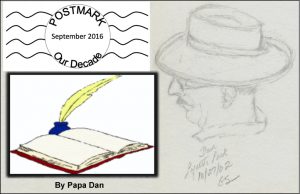
“Yes, here we are
right in the middle of it;
but what should we call it?”
Those of us who went to school around the middle of the 20th century were taught to understand the passing of time in distinct eras, each having its own character and name. For example, the thousand-year period called “The Middle Ages” was a characterized principally by ignorance and short life spans. Following that, it seems, the focus of history narrowed to individual centuries. The 15th century (roughly, 1450 to 1550) is remembered for its intellectual and artistic awakening and discovery and thus called “The Renaissance.” Today, our understanding of distinct definable time periods comes down roughly to decades, both in our education and in popular culture.
So, as I read the news and listen to the pundits of our day, as they attempt to identify the trends of our times, I am driven to ask:
- given the pattern of the decades we have come to know best, what name would a thoughtful person give to the decade in which we live today? How will the 2010-2020 decade be remembered in the years to come?
Of course, since this decade is not finished, our judgments must be preliminary. But let’s give it a try. As a start, let’s review the decades of the most accomplished and truly “American” century of them all, the 20th century.
1900 to 1910 — “The Good Years”
During the first ten years of the 20th century, from an American point of view, the world was mostly at peace. Shirts cost 23¢, but the children who made them earned a mere $3.54 a week. Teddy Roosevelt proposed to strengthen the U.S economy with his Square Deal and sent the U.S. Navy around the globe to introduce the world to the idea of American power. My grandparents, like 3 million other immigrants escaping a crushing depression in Southern Italy, sailed in the belly of big ships from Naples to New York. Last but not least, my father rounded out the decade by being born in Red Jacket, West Virginia on October 10, 1910.
For many Americans, according to a commentator of that time (John Clark), “The future was simple; rewards would go to the virtuous” and Americans perceived themselves to have “the personal material out of which a millennium would grow.” Historians have called this decade “The Good Years” (see Walter Lord’s “The Good Years,” Harper and Row, 1960).
1910 to 1920 — “The End of Empire, War in Europe”
A powerful worldwide upheaval began. In America, much of the population moved to cities and there was a dramatic reduction in immigrants from Europe compared to the mass migration of the previous decade. The world began to see the end of a long-established world order, disintegrated into World War I, and suffered the historically unprecedented destruction and loss of life that went with it. A “new world order” was established once “the war to end all wars” finally … well, so we claimed … ended war itself and, in America, ushering in …
1920 to 1930 — “The Jazz Age” (or “The Roaring Twenties”)
This decade began, inauspiciously, on January 16, 1920 with the onset of Prohibition. It is hard to accept that the alcohol-marinated events of “The Jazz Age” could possibly have begun with a national decision to prohibit alcohol consumption; but as Will Rogers famously said, “Prohibition is better than no alcohol at all.”
Songwriter and philosopher Jacques Brel summed up ‘The Twenties’ this way:
“We must dance because the Twenties roar,
The Twenties roar because there’s bathtub gin,
Vo-de-oh-do and the road to sin,
The road to whoopee and a whole lot more.
Charles A Lindberg, tons of confetti,
Dempsey, Tunney, Sacco and Vanzetti
Black, Black Monday and the market drops
But we keep on dancing, dancing, we can’t stop.”
For many Americans, the party didn’t stop, until …
1930 to 1940 — “The Great Depression”
On the day the Jazz Age ended, the Thirties began: October 29, 1929, with the stock market crash and the beginning of the Great Depression. Unemployment and bread lines became the dominant images. Across the Atlantic, the world darkened further with the growing power of Fascism and Nazism in Europe and the pervasive fear that all of Europe would plunge into war again. The lights went out, virtually worldwide, for the better part of the decade, until …
1940 to 1950 — “World War II, Victory, The Seeds of Prosperity”
The Forties arguably began on September 1, 1939 with Hitler’s invasion of Poland, formally starting World War II. Many Americans, led by Charles Lindberg and other vocal isolationists, insisted that America should stay out of the troubles in Europe and focus on our own economic challenges. While most remember December 7, 1941, as the day that got America into the war, it was actually December 11 – the day that Hitler declared war on the U.S. and Russia. That gave President Roosevelt the clear justification to actively enter the war. The disastrous unemployment of The Great Depression was “solved” with the massive ramp-up of industrial production to support the war effort, which put Americans back to work (although the war killed 60-80 million people worldwide.
1950 to 1960 — “Stability, The Cold War, and Prosperity … for Most of Us”
Looking back as someone born in 1950 into a middle-class community, the Fifties was a period of stability and order, a large-scale expansion of the American middle class, and the re-establishment of a calm and mostly prosperous domestic life for much of America that hadn’t really been seen since the start of the century. A new brand of celebrities like Allen Ginsberg and Maynard G. Krebs introduced Americans to the new vocabulary of “The Beat Generation.” But …
The Cold War started. It began with the Berlin blockade on June 24, 1948, or maybe with the establishment of NATO on April 4, 1950, or perhaps with Joseph McCarthy’s “Wheeling” speech on February 9, 1950. Domestically, the uneven (mostly white) prosperity of the Fifties, coupled with the return to ghettos of many returning U.S. soldiers, the Fifties surely germinated the seeds of the turmoil that burst forth in the next decade.
1960 to 1970 — “The Age of Aquarius”
The Sixties began with a sense of optimism and inspiration epitomized by the election of an eloquent and youthful president, but those hopes were dashed dramatically on November 22, 1963. While the polarization, cynicism, and youth rebellion often associated with the Sixties is traced back by many to the Kennedy assassination, the Era of Rock and Roll as well as much of the colorful wildness and anti-establishment post-Woodstock psychedelia and self-actualization associated with the the Sixties really didn’t come into full flower until the early 1970s. In the middle of the decade, discontent among those who did not benefit from the prosperous “normal” of the Fifties (i.e., African Americans) erupted violently in cities all across America as a reaction against brutal racism and income inequality. Others marched in the streets to protest a war that those who grew up in the Fifties did not understand; once they did understand it, they liked it even less. THAT Sixties was not colorful, prosperous, or peaceful (and 50,000 U.S. soldiers did not come home from that new war).
1970 to 1980 — “The Me Decade”
The Seventies really began on June 17, 1973, even though few people noticed at the time. Five associates of the Committee to Re-Elect the President (yes, known as CREEP) were apprehended while breaking into the Democratic National Committee Headquarters in the Watergate office complex in Washington D.C. In spite of efforts by the president to “make one thing perfectly clear,” one thing led to another and introduced some enduring phrases into the American lexicon: “The Plumbers Unit,” “The people need to know that their president is not a crook,” articles of impeachment, a resignation, and, perhaps most lastingly, the suffix “-gate.” Some would argue that American politics would never be the same. Others argued that “the same” was exactly what it was … and continued to be.
1980 to 1990 — “The Beginning of Fact-Free American Politics”
The Eighties began on January 20, 1981, minutes after the presidency had passed from Jimmy Carter to Ronald Reagan and Iran released the 52 Americans who had been held hostage for 444 days. The decade that followed featured the distortion of American conservatism, from a moderate notion of limited government (actually practiced by Republicans from the 1950s through the era of Watergate) to the excessive expansion of government under the Reagan administration. (Surprised? Look up the numbers – highest Federal budgets per GDP, most Federal employees in history, widespread international intervention, etc.). And all of this took place amid the simultaneous “Small-Government” rhetoric of…well…Ronald Reagan.
1990 to 2000 — “The Best Decade Ever” (so reported by the WSJ and the NYT)
The Nineties were characterized by the rise of multiculturalism, the collapse of the Soviet Union, and the spread of capitalism in that vacuum. In American politics, the Nineties were dominated by a battle between the centrism of the Clinton administration and the politics of personal destruction perfected by the other party, later named RINO by the fictional Will McAvoy of Newsnight (for “Republican In Name Only”). The American economy grew at a strong 4%, median household income rose by 10%, the poverty rate fell from 15% to 11%, the U.S. murder rate declined by 41%, the federal government ended the decade with a budget surplus, the Stock Market quadrupled in value, and the wearing of neckties in offices began to diminish. But,
On the world stage, wars broke out in the Congo, the Persian Gulf, Chechnya (twice), Kashmir, Kosovo, Yugoslavia, Croatia, and Bosnia, to name only a few, and a host of civil wars redrew maps on at least two continents. However, apartheid in South Africa came to an end. The Nineties also featured an unprecedented explosion of the Internet and computer technology (although these advances were soon to be dwarfed by a greater explosion of the Internet and computer technology just around the corner).
2000 to 2010 — “The Rise of Terrorism and The Great Recession ”
The Oughts, the first decade of the 21st century was initiated by the arrival of large-scale terrorism on American soil. This heinous crime was followed by a panicked attempt to combat terrorism through the dismantlement of civil liberties at home and a misdirected military response against a country and a dictator who had nothing to do with 9/11.
Oh, yes, the U.S. had a historic period of anti-intellectualism, manifest in the depletion of education budgets and leadership of a president “misunderestimated” for his lack of interest in intellect, let alone possession of it (stimulating an all-but-forgotten quote from Garrison Keillor: “Who needs a fifty-dollar haircut on a fifty-cent head?”).
The housing finance and stock market investment disaster during the Dubya era sent the U.S. economy into a tailspin. Recession and unemployment were stopped just short of a Depression by an infusion of fiscal stimulus and government regulation (who wouldda thunk it?).
2010 to 2020 — “Whah?”
Well, that brings us to the present decade, of which we stand approximately in the middle and the question that I started with:
• What should we name this decade? More precisely, what are we likely to call it when this decade is done? So, let’s explore what we know about this current decade, so far.
The ?????
- The West’s war against terrorism becomes terrorism’s war against The West.
- The end of “carefree” in America and the avoidance of crowds.
- A generalized paranoia, growing gun ownership, and gun violence.
- A gradual, but dramatically uneven increase in prosperity.
- A decline in the power of labor unions and a decrease in the size of the middle class.
- The re-emergence of racial tension, especially between minorities and law enforcement.
- The maturing of “Fact-Free Politics” and the trend toward “voting against” in which nobody believes fully in the available choices.
• I invite you, dear reader, to send us your suggestions. What should we call this decade we inhabit today? I am interested in your ideas. ![]()
Download a PDF of this post: convivio_decades_sept2016_final
For fun, below is an added bonus for those who, like me, identify decades with music …
The Soundtracks of the Decades
(The most popular songs listed on U.S. Billboard)
The Tens:
When You Were Sweet Sixteen (1900)
Stars & Stripes Forever (1901)
Bill Bailey (Won’t You Please Come Home) (1902)
In the Good Old Summer Time (1903)
Sweet Adeline (1904)
Give My Regards to Broadway (1905)
Yankee Doodle (1905)
Auld Lang Syne (1907)
My Gal Sal (1907)
Take Me Out to the Ball Game (1908)
I Wonder Who’s Kissing Her Now (1909)
Swing Low, Sweet Chariot (1909)
The Teens:
Let Me Call You Sweetheart (1910)
By the Light of the Silvery Moon (1910)
Alexander’s Ragtime band (1911)
When Irish Eyes Are Smiling (1913)
By the Beautiful Sea (1914)
Carry Me Back to Old Virginney (1915)
I Didn’t Raise My Boy to Be a Soldier (1915)
O Sole Mio (My Sunshine) (1916, Enrico Caruso
Over There (1917)
For Me and My Gal (1917)
Rock-A-Bye Your Baby (With a Dixie Melody) (1918)
I’m Always Chasing Rainbows (1918)
The Twenties:
Swanee (1920, Al Jolson)
My Man (1922, Fannie Brice)
Yes! We Have No Bananas (1923)
Rhapsody in Blue (1924. George Gerschwin)
California, Here I Come (1924, Al Jolson)
Sweet Georgia Brown (1925)
Ain’t She Sweet? (1927)
Stardust (1927, Hoagy Carmicheal)
Ol’ Man River (1928)
Mack the Knife (1928)
Ain’t Misbehavin’ (1929)
Tip Toe Thru’ The Tulips With Me (1929)
The Thirties:
Happy Days Are Here Again (1930)
Dream a Little Dream of Me (1931)
It Don’t Mean a Thing (If It Ain’t Got That Swing) (1932, Duke Ellington)
Stormy Weather (Keeps Rainin’ All the Time) (1933)
Brother, Can You Spare a Dime? (1932, Bing Crosby, others)
On The Good Ship Lollipop (1935, Shirley Temple)
Summertime (1936, Billie Holiday)
They Can’t Take That Away From Me 1937, Fred Astair)
Blue Moon (1935)
Sing, Sing, Sing (With A Swing) (1937, Benny Goodman)
September in the Rain (1937)
Thanks For the Memory (1938, Bob Hope and Shirley Ross)
Over the Rainbow (1939, Judy Garland)
God Bless America (1939, Kate Smith)
Back in the Saddle Again (1939, Gene Autry)
The Forties:
When You Wish Upon a Star (1940)
In the Mood (1940, Glenn Miller)
Blues in the Night (1942)
White Christmas (1942, Bing Crosby)
As Time Goes By (1943)
Don’t Fence Me In (1944, Bing Crosby)
This Land is Your Land (1944, Woodie Guthrie)
The Christmas Song (Chestnuts Roasting on an Open Fire) (1946, Nat King Cole)
Some Enchanted Evening (1949, {Perry Como)
All I Want For Christmas is My Two Front Teeth (1949 Spike Jones)
Rudolph, the Red-Nosed Reindeer (1949, Gene Autry)
La Vie En Rose (1949, Edith Piaf)
The Fifties:
How Much Is That Doggie in the Window (1953, Patti Page)
Mister Sandman (1954, The Chordettes)
Sh-Boom (Life Could Be a Dream) (1954, The Crew-Cuts)
Three Coins in the Fountain (1954, Four Aces)
Mambo Italiano (1954, Rosemary Clooney, yep George’s mom)
Stranger in Paradise (1954, Tony Bennett)
Sixteen Tons (1955, Tennessee Ernie Ford)
Rock Around the Clock (1955)
Heartbreak Hotel, All Shook Up, Hound Dog, Don’t Be Cruel (1956, Elvis Presley)
Que sera sera (Whatever will be will be) (1956, Doris Day)
At the Hop (1957)
It’s All in the Game (1958, Tommy Edwards)
Johnny B Goode (1958, Chuck Berry)
All I Have to Do is Dream (1958, Everly Brothers)
Venus (1959, Frankie Avalon)
The Sixties, Seventies, Eighties, Nineties, Oughts, etc
YOU KNOW THESE, DON’T YOU?
For a these songs and more – check out: http://tsort.info/music/ds1930.htm
Click here to download a PDF of this post: ConVivio_Decades_SEPT2016_FINAL
Back To School: 2016
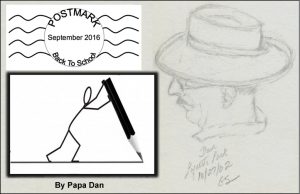
This past month,
as my grandchildren head back to school,
this former ‘pencil pusher’ reflects:
How has “Back to School” changed?
Back to School: A ‘Pencil Pusher’ Looks Back
Who’s Your Daddy?
Growing up in Antioch, a middle-class California town, in the 1950s, the boys I knew competed on the school playground in the same ways, I assume, that boys did in other places. Hierarchies were established, often starting with a conversation like this one:
“Hey, you can’t cut in front of me, I’m up next.”
“Well, I called it.”
“What do you mean you ‘called it?’ You can’t just call it!” (Remember when you could call it, you know, “I got dibs.”)
“Nobody wants you to bat with runners on base. You never hit the ball out of the infield. You’re an automatic out.”
“Oh, YEAH? (then comes the big one at this early stage of the argument):
“And you throw like a girl.” (It didn’t get much more personal than that in 1959.)
Next comes the appeal to fairness. “You gotta wait your turn.”
Fairness fails and is trumped by an appeal to personal strength. “Who’s gonna make me, YOU?”
Up to that point, that’s pretty standard stuff; but, unless the boys were willing to throw punches or were stopped by some external interruption, the argument could move completely outside of the playground into more sensitive territory.
“You’re as wimpy as your dad.”
So, where did that come from?
Antioch was a serious factory town in the 1950s. We had a DuPont plant, two Fiberboard plants, a Crown Zellerbach paper mill, a Glass Containers factory, Fulton Shipyard, Continental Can, Kaiser Gypsum, Union Carbide, Dow Chemical, a rubber mill, two canneries, Dexter Hysol out on Bailey Road, the Redwood Manufacturing Lumber Yard, and a U.S Steel plant just outside of town on Loveridge Road. Turns out that a major percentage of the dads in the vicinity worked in one of these facilities. (By the late 1960s, about one-third of the local moms also worked outside the home, but in Antioch back in the fifties it was mostly dads – just like a script from TV shows we watched like “Father Knows Best” or “Leave It to Beaver.”) So, when a guy was challenged on the playground, some portion of his status was wrapped up in his dad’s occupation; so the next level of insults could take a new direction, refining the playground hierarchy:
“I bet your dad’s the smallest guy at Fiberboard.”
“He doesn’t work at the stupid Fiberboard plant; he drives a forklift – the big one that hauls tons of stuff.”
“Tons of what? Peaches at the cannery? My dad works at U.S. Steel. They make steel for cars and airplanes and big stuff.”
“Big deal! My dad’s a foreman. He orders guys like your dad around all day long.”
“Yeah, well . . . “ he searches for something to top that –> and here it comes,
“Your dad doesn’t do REAL work, he’s just a pencil pusher.”
What’s a ‘Pencil Pusher?’
If these boys were lucky, the inning ended or the bell rang or Sister Bernadette showed up with her uncanny ability to sense when boys were heading for trouble, so it seldom escalated to an actual fistfight. But those of us watching from outside of the argument were left wanting to know: What’s a ‘pencil pusher?’ What kind of job was that? It was made to sound pretty insulting. Guys, and gals, were wondering: was my dad a ‘pencil pusher?’ If he was, just how embarrassed should I be? Was that as low on the totem pole as the kid on the playground made it sound? Did that insult win the argument? It would have been instructive — to us fourth-grade bystanders at least — if the exchange had been allowed to run its full course and we could find out who won the argument in the only definitive way we knew: which one ended up on the ground crying and which one walked away with all of his teeth?
Of course, one way or another most of us who cared eventually learned, or decided for ourselves, what it meant to be a ’pencil pusher.’ To those who used it as an insult, it meant a job that didn’t require physical strength and skill to build things — the work that made someone a ‘real man’ in a factory town like this one. After all, as we were all taught by our ‘Greatest Generation’ parents and teachers, the post-war economy was built on production of things like cars and trucks and refrigerators and all the other things that TV commercials told us we needed to buy. Those products, the stuff they were made of, and the containers they came in were produced with physical labor in factories like those in our town. Many Antioch dads did that work.
But gradually, as the 50s turned the corner into the late-60s, we baby boomers were presented with other choices. To some, a ‘pencil pusher,’ it turned out, was someone who used his brain to plan or organize or communicate the ideas and processes that made the manufacturing economy successful. He might have been an accountant or insurance broker, a union leader or a lawyer, a newspaper reporter or a manager. AND, increasingly, gradually, pencil pushers turned out to be women, as well (a feature that distinguished the 1960s and beyond from the 1950s).
My dad, who worked in the steel mill after completing less than a junior-high education in the Santa Clara Valley, went to night school to become a pencil pusher (i.e., an insurance agent). So, from my earliest memories, my dad made clear to me that I was going to college so I could become a pencil pusher of some kind. He never used that word, but there was no question that he didn’t want me to work in one of the Antioch factories. Increasing numbers of us who graduated from that playground, later graduated from high school and went to college fully intending to become very good at pushing a pencil and, eventually, using other ‘labor-saving devices’ like typewriters, telephones, calculators, and much later, computers. Pencil pushers, it turned out, helped turn many kinds of labor jobs into well-paying union careers and provided opportunities for promotion that broadened the middle class and made it increasingly prosperous as the 1960s matured in our town.
Boing! With the 1960s, athletics begin to dominate
The ‘Pencil Pusher’ conflict of the late 1950s, which I observed mostly as a bystander, didn’t have much of an effect on me personally, since it was all about competition on the playground; and I was not perceived as competing with anyone. I was a kid who carried around a leather briefcase that my father gave me to carry my books. Reading was the ‘sport’ that he encouraged every way he could. On the playground of the 5th and 6th grade, I was pigeonholed in the category of the “uncoordinated,” which kept me safely out of competition with other boys. I was picked last when teams were picked (when I HAD to play baseball in PE), I found that if I gravitated to tetherball, while it was technically a ‘sport,’ it seemed to keep the competitive forces of the playground at a distance. But then, as I went back to school in the fall of the 7th grade, everything changed. EVERYTHING. During the summer and fall of 1962, I grew six inches.
As I described in an earlier story on ConVivio (https://convivio-online.net/a-moment-in-the-sun/ ), the basketball coach (in conspiracy with Sr. Bernadette and my mother), forced me to join the 7th-grade basketball team — VERY much against my will.
At first the others on the team seemed amused when I showed up; but to my (and their) surprise, I did pretty well without embarrassing myself too much. I got a bunch of rebounds, blocked some shots, threw the ball down court to Gary to start the fastbreak, and helped the team win. For the others, it was no longer amusing when the coach made me one of the starting five. Then it became serious; but some of them got used to having a formerly uncoordinated kid become one of them. After a few weeks of this, one day Tom Augustine — an all-sport athlete — gave me a nickname. He said, without malice, just stating the facts, “You’re not really any good, are you, you just have ‘BOING,’ right? You know, like a spring.” We were friends, so I took it well. He was right. I didn’t have the usual set of athletic skills. I had ‘boing.’
As a result of some coaching and persistent practice in my backyard, by the time I showed up in high school, I was a real-live starting high-school basketball player, with all of the privileges and respect that went with it. No foolin’. Apparently, by the last half of the 1960s, the fact that my dad was a ‘pencil pusher,’ no longer did me any harm. Perhaps that stigma had begun to disappear, even in a factory town like Antioch, and we had to earn our own respect (or lack of it).
In High School — What next? The ASVAB Test
So, at Antioch High School, basketball wasn’t going to get me much more than a little respect on the basketball court; it was time to take the next step, whatever that turned out to be. The next step, as my guidance counselor informed me, was to find out what I was good at to prepare myself to go to college. She had spoken to my dad and, she told me, ”He made some things clear – you are going to college whether you like it or not, you know that don’t you?” I hadn’t heard it put quite that way exactly, but it wasn’t a surprise. And she said something more: “He also told me that he was hoping that you would take over his insurance agency after you graduate. You know, ‘A. J. Sapone Insurance And Son’ and all of that.” So she told me, “I advised your father that he would have to wait and see if that turned out to be what your son is good at. He may have other skills and other interests that he’ll figure for himself. So, he may end up taking a different path.” She told me that she didn’t think he would be thrilled with that outcome, but he seemed to accept that as a possibility. She also suggested a strategy. “The Armed Services Vocational Aptitude Battery (ASVAB) of standardized tests was going to be offered in a few weeks,” she told me. I want you to take that test and we’ll see what it tells us.”
“I won’t have to join the army, will I . . . because, you can for… “
“No, everybody gets to take it. It tells us what kinds of professions you might be best suited for, based on your interests and talents. It might help.”
So the test came and went and we waited for the results. The background: by 1967, the values of popular culture began to be influenced by some recognizable themes. Appreciation for the outdoors, for individualism, for public service, and other attributes that came to us from music and TV resulted in some predictable answers to questions designed to identify personality traits. So when the results came back and were reported to us, I learned that I was most suited to becoming a forest ranger. The wonderful joke was that more than half of my friends learned that they had the same destiny. One saw me holding the familiar envelope and said “Forest ranger, right?”
“Right.”
When I asked my counselor about it she confirmed the glitch in the data analysis, “Yes, I guess you’re going to have to figure it out for yourself.” That, of course, had been her real advice all along. So, “back to school” had new meaning. I went off to college with that question: did my future have an “And Son” sign hanging on it, or was there something else I had to choose?
As my grandchildren head back to school at various stages of their education, perhaps they are in the middle of a similar process.
With the 2016 Version of “Back to School,” What has Changed?
Looking back across the decades that followed, many things changed. The education I receive prepared me for a long career as a ‘pencil pusher’ — a writer and editor. Pencils began to take a back seat to other tools that dramatically accelerated the advancement of ‘pencil pusher types’ of an increasing variety. As the 20th century passed into memory, in an equally dramatic reversal, the middle class itself has begun to shrink as many labor jobs — jobs that were so well esteemed on my playground in the 1950s — began to draw a diminishing share of the benefits of the increasingly globalized and technology-driven economy.
As an older guy recently retired from my career as a ‘pencil pusher’ — a guy with seven grandchildren growing up on very different playgrounds — I have some questions:
- Are the conversations on their playgrounds different today?
- Does the occupation of their parents play a greater or lesser role than it did on my playground?
- What will be the shape of the middle class that they will graduate into? What will it take for them to access the quality of life that was made available to me?
- Will the education available to them prepare them for the world they will meet when they graduate?
My grandchildren seem to have some advantages — they all seem to be smarter than I was at their age; they all have university-educated parents; they have access to vastly more technology that I had (I had a transistor radio, and electric train, and a bicycle and they have . . . well, other stuff), and they are exposed to much more cultural diversity than I was (my town and my playground had none). The technology they have at their fingertips provides them with information and answers that my generation had to dig for by going to the library. Is their instant access to information an ‘advantage’ or does it bypass some of the learning experiences I had? Will they be sufficiently prepared in subjects related to 21st-century science and technology? AND — equally important to this ‘English major’ — will they have a solid foundation in the Humanities necessary to be a well-rounded human being?
I think they will. The evidence for that optimism is my observation that their parents (our children) are providing them with experiences that expose them to reading, science, the arts, and personal interactions that are helping them develop into curious, confident observers of the world around them and smart thinkers. I see those parents actively involved in their children’s school, extracurricular music and arts programs, and sports teams. And the kids are proud of the things they do. So, I am optimistic. Still, I suspect that there are things we older folks can do here in this 21st-century ‘back-to-school’ season to help them succeed.
As for the conversations they have on their playgrounds – I guess I’ll have to ask them.
Download a PDF of this post: convivio_backtoschool_sep7_2016 ![]()
Snow Globe
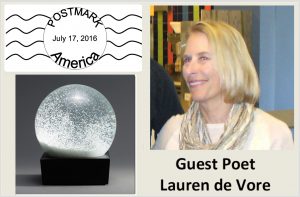
I read the news this morning. Yet another shooting, this time, police ambushed in Baton Rouge. Even as my heart wrenched, my cynical (benumbed?) mind wondered what it would be tomorrow—civilian or law enforcement? terrorist or home-grown? individual or mass? As horrid as these events are, we must bear witness to them. We must talk. We must act. Otherwise, nothing changes.
====================================================================
Snow Globe
A shot, a siren.
A siren, a shot.
Does it matter which is first?
Either way someone’s dead.
One life ended,
Others destroyed—
The shot, the shooter,
Those left behind.
The act, the image.
The image, the outrage.
Marches, protests,
Funerals.
Pulpits, airwaves
Fill with eloquence,
Prayers and pleas
And vows for change.
Yet where’s the outrage
When nothing changes?
Black skin, brown skin,
White skin, tan,
Blue jeans, badge,
Crescent, cross, six-point star.
Does it matter who bleeds first?
Either way blood is spilt,
Hands are stained,
Souls are rended.
Vengeance, justice,
Someone tell me,
What’s the difference?
Shake a snow globe,
Glittering flakes in fury swirl,
Slacken, then subside.
A shot, a siren.
A siren, a shot.
Yet again a life is ended.
Yet again the globe’s upended.
Yet again nothing changes.
(Lauren de Vore, July 17, 2016)
Download “Snow Globe” in PDF: ConVivio_Snow_Globe_DeVore_7_17_2016
Where Do I Start? Where Do You?
“Unless someone like you
cares a whole awful lot,
nothing is going to get better.
It’s not.”
— Dr. Seus
This week in Dallas, in the depth of despair, once again, we heard the President of the United States tell us that we must reject the despair we see all about us. He said, “Scripture tells us that in our sufferings, there is glory, because we know that suffering produces perseverance; perseverance, character; and character, hope. Sometimes the truths of these words are hard to see. Right now, those words test us because the people of Dallas, people across the country are suffering.”
Words of hope — but the words are hard to hear. Despair and suffering speak with loud voices that can drown out words of hope, making it difficult to move past suffering and get all the way to “perseverance and character” before getting to hope.
And he said, “I understand. I understand how Americans are feeling. But Dallas, I’m here to say we must reject such despair. I’m here to insist that we are not as divided as we seem. And I know that because I know America. I know how far we’ve come against impossible odds.”
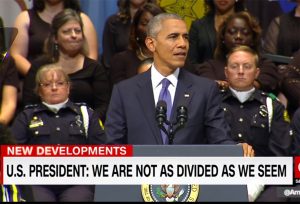
A big challenge — bold words delivered to an audience in mourning. He told us things we know, but things that are hard to hear while we’re in the middle of the suffering.
And he said, “The pain we feel may not soon pass, but my faith tells me that they did not die in vain. I believe our sorrow can make us a better country. I believe our righteous anger can be transformed into more justice and more peace. Weeping may endure for a night but I’m convinced joy comes in the morning.”
He reminded us of the promises made to Ezekiel I the old testament: “ ‘I will give you a new heart,’ ” the Lord says, ‘and put a new spirit in you. I will remove from you your heart of stone, and give you a heart of flesh.’ ” The President cited examples of those with such new hearts who had made progress possible, right here in Dallas. But still, we mourn.
Much earlier in my lifetime, a man I admired (who would not become president) stood on a street corner on the back of a flat-bed truck and talked about a terrible thing that had happened that day. Robert Kennedy told a small gathering of Africa Americans in Indianapolis that Dr. Martin Luther King Jr. had just been murdered. What was promised that day was wisdom, the same promise made to Ezekiel.
Quoting an ancient Greek playwright, Senator Robert Kennedy said,
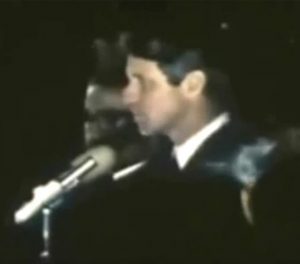
“Even in our sleep, pain, which cannot forget
falls drop by drop upon the heart until,
in our own despair, against our will,
comes wisdom
through the awful grace of God.
— Aeschylus
Paste into your browser and watch:
https://youtu.be/GoKzCff8Zbs
The pain that day did not go away, nor — as of this writing — has the promised wisdom arrived. In fact, two months later, June 6, 1968, two days before my high school graduation, Robert Kennedy was himself the victim of violent hatred. That was 48 years ago. And, across this nation, still we have not yet seen the wisdom nor the new heart.
What do we learn? If we’re paying attention, we earn that waiting for the wisdom and the new heart has not worked. I suppose that means that we have to do it ourselves, somehow. And, this week, we heard some suggestions – President Obama said,
“we can learn to stand in each other’s shoes and look at the world through each other’s eyes.”
And he said, “we can abandon the overheated rhetoric and the oversimplification that reduces whole categories of our fellow Americans, not just to opponents, but to enemies.”
And he said, “those protesting for change will guard against reckless language going forward.”
And he said, “police departments will acknowledge that, just like the rest of us, they’re not perfect. That insisting we do better to root out racial bias is not an attack on cops, but an effort to live up to our highest ideals.”
And he said, “we can worry less about which side has been wronged, and worry more about joining sides to do right.”
And, to bring us back to where he started, he said, “It turns out we do not persevere alone. Our character is not found in isolation. Hope does not arise by putting our fellow man down, it is found by lifting others up.”
These prescriptions for change sound simple. But, with the number of times we have tried to teach ourselves these lessons, and failed — that’s where the despair comes from — one can only hope that these things do not turn out to be impossible.
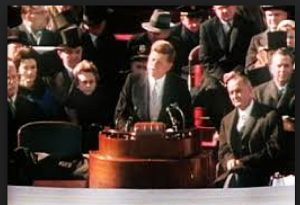 BUT, if we can persevere, we have been offered hope. Also in my lifetime, we were given another list of prescriptions for change that seemed daunting in their time. On January 20, 1961, President John F. Kennedy confronted the nation with such a list and summarized the challenge this way:
BUT, if we can persevere, we have been offered hope. Also in my lifetime, we were given another list of prescriptions for change that seemed daunting in their time. On January 20, 1961, President John F. Kennedy confronted the nation with such a list and summarized the challenge this way:
“All this will not be finished in the first one hundred days. Nor will it be finished in the first thousand days, nor even perhaps in our lifetime on this planet. But let us begin.”
Maybe the success is in the starting, not in the finishing. I suppose the “us” these leaders spoke of must be assembled one person at a time. So, where do I start? Where do you?
What answers can we offer? Even if they see too small and the challenges seem too great, let’s say them right out loud. “… let us begin.”
Download a PDF of this article: ConVivio_Dallas_July14_2016
![]()
An Election (Certainly Not Ours) — A Fable
“It’s what I DO.”
— Farley Forlock, July 2060
Click here for PDF of this post: THEIR_election_July7_2060
Not so long ago, in a country not far away, leaders of its two political parties began gearing up for their usual five-year election cycle. Halfway through the twenty-first century, the nation of Aqualandia had become justifiably proud of its new government structures. Years ago they had lengthened the presidential term to five years because, they observed, it took nearly two years to elect a president with the result that very little actual governing got done. Some elections early in the century, notably the infamous election of 2016, had been more chaotic than they preferred, so they took action to restore order and propriety to the process. After cleaning up the mess caused by the disintegration of one of the major parties, they established rules covering every eventuality: rules to qualify candidates for the national primary (they had to have significant name recognition in all three states as determined by well-regulated polling); rules ensuring that all Aqualandian residents could vote after passing a simple advertising-susceptibility test (to make sure voters would be properly informed by political advertising); rules awarding all thirty-three electoral votes from each of the three states to the candidate winning the popular vote in that state, and rules governing the three carefully timed steps to the election of a president. “The Institution,” as the rules were lovingly called, was universally admired around the world, especially in the remaining three nations of the European Union where Aqualandian principles were closely observed and often imitated.
The Three States
 After many decades of experimentation with a larger number of states, Aqualandia’s Institutional Convention structured the nation into three regional states. Every ten years, the national census would adjust the boundaries of the three states. By law, the Coastal Region, geographically split because of the propensity of the coastal areas to be influenced by “non-continental” forces, was drawn to include thirty-three percent of the registered residents who lived closest to the two coasts. The Central Region included the thirty-three percent of residents who lived between the two inland edges of the Coastal Region extending south from Aqualandia’s northern border. The Southern Region was made of the thirty-three percent of residents closest to the southern border between the Coastal and Central states. Since those three states added up to ninety-nine percent of Aqualandia residents, those citizens whose wealth placed them in the top one percent do not vote in the primary election. The logic held that those among the ‘one percent’ are less likely to be influenced by political advertising and, therefore, do not qualify as primary voters. In an Institutional provision called the Manhattan Compromise, this disparity was remedied by requiring each ‘one-percenter’ to vote twice in the general election, since they had been unrepresented in the primary process. Their campaign contributions supplemented their participation and were considered ample recompense for their sacrifice.
After many decades of experimentation with a larger number of states, Aqualandia’s Institutional Convention structured the nation into three regional states. Every ten years, the national census would adjust the boundaries of the three states. By law, the Coastal Region, geographically split because of the propensity of the coastal areas to be influenced by “non-continental” forces, was drawn to include thirty-three percent of the registered residents who lived closest to the two coasts. The Central Region included the thirty-three percent of residents who lived between the two inland edges of the Coastal Region extending south from Aqualandia’s northern border. The Southern Region was made of the thirty-three percent of residents closest to the southern border between the Coastal and Central states. Since those three states added up to ninety-nine percent of Aqualandia residents, those citizens whose wealth placed them in the top one percent do not vote in the primary election. The logic held that those among the ‘one percent’ are less likely to be influenced by political advertising and, therefore, do not qualify as primary voters. In an Institutional provision called the Manhattan Compromise, this disparity was remedied by requiring each ‘one-percenter’ to vote twice in the general election, since they had been unrepresented in the primary process. Their campaign contributions supplemented their participation and were considered ample recompense for their sacrifice.
The fact that the census changed the shape of the three states every ten years caused an ongoing joke, especially popular among Europeans and late-night talk-show hosts. The map of Aqualandia was drawn to look, alternately, like a smiling face or a frowning face, depending on the population distribution. The current host of the CBS Late Night Show said, “to get this nation smiling again, fifty million people will have to move north.”
The Two Parties
Aqualandia’s history had shown that any deviation from a two-candidate election distorted the election process and its outcome. In previous centuries, third-party candidates like George Wallace, John Anderson, and Ross Perot were found to have splintered the natural ideological distribution of the nation in ways that appeared to subvert the will of the people. So, that eventuality was prohibited. The Institutional Convention called for exactly two political parties. While there were no regional requirements for party membership, the Blue Party found its members predominantly located in the Coastal Region. The Red Party dominated the Southern Region to a large extent. The Central Region was typically found to be divided between the Blues and Reds from election to election in less predictable patterns, as were the one-percenters.
The Three Steps in Electing a President
Step One required candidates to qualify for the primary ballot in their state by uploading their name-recognition data to the secure election website using a specially designed PresElect App downloaded from iTunes. After six months of streaming YouTube, Snapchat, and TechPol appearances, that same PresElect App was used by voters in a national same-day primary election to select the candidate who would represent their party in the general election.
Step Two required party leadership to meet with the nominee to establish the priorities, policies, and values that all party members would support in ‘down-ballot’ races for the Senate, House of Representatives, the three Governorships, and local elections. ‘One-percenters’ of both parties were included among the leadership of the party of their choice, ensuring that party platforms would not violate market-based business practices.
Step Three, of course, was the general election. Given the way the intellectual competence of the electorate had evolved in recent years, it needed to be the simplest step. With only two candidates to consider and two publically-debated policy platforms to choose from, how hard could it be? It was designed to be orderly, simple, and easy to understand (even in the Southern Region). However, this particular year, 2060, has all the earmarks of being . . . well, different.
The Candidates
After a messy primary season, one candidate from The Red Party emerged with the most votes – even though nobody in the party could stand being in the same room with him. Farley Forelock appealed to voters who were unhappy with government (sort of everyone) and by insulting everyone who didn’t agree with him (sort of everyone). In his youth, he had attended a little-known university in pursuit of a double major in marketing and law (specializing in bankruptcy law). While there was no record of a degree, he learned a lot from his mentor, the founder of the university. Farley went on to make a fortune in the construction business with bombastic marketing (“We’re the best and THEY are terrible!”) and minimizing construction costs by paying as little as possible for labor and materials (“Some of our nation’s laws can be very friendly if you know how to use them”). In an undergraduate course in election law, Farley recalled writing in his notebook, “If a person is successful enough to be a credible candidate for president, why would he or she want to actually BE president? It seems like a lot of work. All I’ve ever really wanted to do is WIN!”
The Blue Party primary season was also messy. The winning candidate, Ophelia Empath had long experience in various governmental roles at a sufficiently high level to make her nomination inevitable. Her candidacy, however, was a two-edged sword. On the one hand she appealed to many Blue voters because she had high-level government experience; but she was detested by the category of voters in both parties who were unhappy with government (sort of everyone) and held her accountable for the status quo. She also had the disadvantage of being part of a political family that had a well-earned reputation for personal controversy. So, voters who sought stability were wary of a candidate who was always followed around by high drama.
Many Aqualandians were anxious to vote AGAINST both candidates. It was harder to identify many who were enthusiastically FOR either of them.
The Winning Strategy
Farley Forelock had been studying the government of Aqualandia for some time and had formulated a plan. He observed that the people did not seem capable of selecting a president who was up to the job. The increasing distaste for government and a diminishing participation in it seemed to be making that condition worse. He reasoned that somebody had to choose a president who would put the government on a stronger path. “If only I could just choose someone … “ How to do that?
Farley had made some simple observations:
- The Red Party candidates likely to run against him were weak. There were so many of them, they would divide what little support they could generate.
- Red Party voters were willing to engage in a blame game if they were persuaded by the right kind of nationalist cheerleader.
- The Blue Party candidate was surrounded by potential land mines that could derail her candidacy. A clever opponent could win if he was willing to play hardball.
- Presidents in his lifetime had entered office as vigorous men in the prime of their lives and left it as grey-haired, aging, tired men. The job was a great burden. Who would want to DO such a job? The REAL power, he imagined, would be to unilaterally select the right president and bypass the burden of office.
Using his previous theatrical experience, Farley decided to play the part of a bigoted buffoon, inciting large crowds to fear and distrust people of different backgrounds. He predicted that the undereducated population at the bottom half of the economic spectrum would blame their lack of success on others. He also reasoned that they would not be interested in the complicated analyses offered by the other party. So, he embarked on a campaign of insults, division, and over-simplification. In a party accustomed to over-simplification and finger pointing, it should be easy to win the nomination.
After the vote count, the outcome astounded everyone except Farley Forelock (“I told you I would WIN, that’s what I DO”). He was now the Red Party nominee. That was that.
Once he had won the nomination, it was time for Step Two: party unification, platform development, and the vice-presidential selection. This step was easy – he merely said “no” to every policy position the party leaders proposed and reminded them that the voters had spoken. In front of a bevy of reporters, he told them — if the party wanted to win, they had to agree with the positions he had supported during his successful primary campaign and accept his choice for vice-president. He assured them he would make his VP announcement soon. His message appeared in headlines in every newspaper in Aqualandia: “Do you want to win? Then stick with me, that’s what I DO!” Polls showed widespread support among the Reds. Party leaders had no choice but to nod their heads and wait for his VP announcement.
As he had predicted, the Blue Party nominee was lambasted for serious security violations during her government service. She didn’t go to jail but her credibility was damaged. Many public figures expressed diminished confidence in an administration headed by Ophelia Empath. So, while her name would remain on the ballot, voters began pulling away from her. That was the signal for Farley Forelock to prepare the final step of his strategy. He named his vice-president — a long-planned choice that emerged from his usual behind-the-scenes deal-making — on the last day to put a name on the three state ballots. He then flew to Scotland for an extended visit to one of his golf courses.
Everyone looked at each other – “Whuh just happened?!” Of course they couldn’t know what Farley Forelock had planned as Step Three – that would be the clincher. But that would have to wait until the proper time.
Election Day was fairly straightforward. The South and Central states both voted for Forelock, earning him 66 of the 100 electoral votes. As soon as those numbers were confirmed, the votes from Coastal Region were meaningless. One percenters were also irrelevant. Farley paused on the 13th green before putting for par. His Twitter feed from Scotland acknowledged the outcome “I told you I would win, it’s what I do.”
In fulfilling the formality required by The Institution, the electors met on December 19th to confirm the outcome. That was that.
Mystery swirled around Aqualandia’s capital in anticipation of Inauguration Day on January 20. Adding to the tension, President-Elect Forelock decided to stay overseas and conduct what was billed as a “Final Presidential Tour” of his golf courses and casinos, finalizing three deals, selling one property and buying two more. The press had questions that went unanswered – Would he be putting his properties and businesses in a blind trust as other wealthy presidents had done? Would he announce a new CEO of Forelock Enterprises? Would announce his cabinet soon? Would The First Lady begin remodeling and painting the exterior of the Presidential Estate, as he had promised, “on Day One?” However, Forelock’s usually productive Twitter account (#WEWIN) was silent. With impeccable timing, Farley’s plane touched down at JFK airport and the usual array of microphones on the tarmac awaited the new president’s first words. His orange hair blowing in the breeze, without a teleprompter, he scowled his usual scowl and said, “As I had intended from the start, I have selected the president of my choice. I hereby resign from the presidency effective immediately. The Vice President-Elect, now the President I have chosen, will be inaugurated on January 20. I accept the thanks of a grateful nation and wish the new president well.” ![]()
Thanks to Gretta for some of the key ideas and to Lauren for her Editorial expertise.
Download a PDF of this post here: THEIR_election_July7_16
American Independence Day — Brexit Number One???
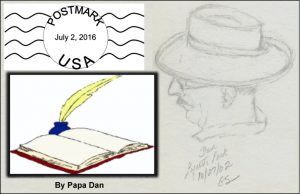
“It ought to be commemorated,
as the Day of Deliverance
by solemn Acts of Devotion
to God Almighty
. . . solemnized with Pomp
and Parade, with Bells,
Bonfires, and illuminations
from one end of this continent
to the other.”
— John Adams, July 1776
It’s here, America’s national birthday! Flags are flying, there will be fireworks, concerts, and parades all across the land. Our national anthem will be played by bands and sung by soloists at every opportunity, and well it should be! For our red, white, and blue flag and the nation for which it flies has endured through hard and confusing times – beginning at its founding in the turbulent 18th century through to the present hard and confusing times here in the turbulent twenty-first. Congratulations to us all!
These two hundred forty years haven’t been easy. Of course, like most of the major inflection points remembered along the span of our history, this one is remembered with a focus on winning a war – the war for independence from the British Empire. OK, yes, the cleverest among us are welcome to call it The First Brexit, well, the exit from Britain by the British colonies of North America.
As such, the military victory itself was a bit of a surprise. Military buffs may be interested to know the details of the strength of Washington’s American army that defeated the powerful military force of what was arguably the largest empire the world has ever known. What did it take? On May 12, 1776, General Washington reported the Duty Roster of the Continental Army in a dispatch to the Congress as follows:
- Commissioned officers 589
- Non-commissioned officers 722
- Present and fit for duty 6,641
- Sick but present 547
- Sick but absent 352
- On furlough 66
- Absent without leave (AWOL) 1,122
That was the total strength of the American army. Stunning, eh?! How did it happen? Well, lots has been written about the war . . . but . . . the short answer is . . . well:
The French helped us. (Shhhhhhhh. Don’t tell anybody; some are still embarrassed.)
The Declaration
Even though our national anthem doesn’t mention it, we all know, of course, that Independence Day commemorates more than just winning a war. There were powerful ideas at work that made it happen. The ideas that flowed from the pen of Thomas Jefferson are still revered today, across America and in many parts of the world. A declaration published for all the world to see enumerated twenty-eight major grievances against the British King and eloquently proclaimed the necessity “for one people to dissolve the political bands which have connected them with another, and to assume among the powers of the earth, the separate and equal station to which the Laws of Nature and of Nature’s God entitle them.” In the document, the king was defined as a tyrant “. . . unfit to be ruler of a free people.” Finally, after claiming the right “to do all other Acts and Things which Independent States may of right do,” the fifty-six signers of the document pledged their fealty to the values they held most dear: “And for the support of this Declaration, with a firm reliance on the protection of divine Providence, we mutually pledge to each other our Lives, our Fortunes and our sacred Honor.”
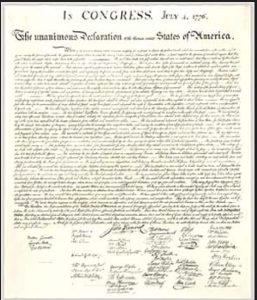
The debate in the Second Continental Congress on whether to adopt the declaration was vigorous and required some significant compromises – including what many refer to the ‘Original Sin’ of the American experiment in democracy. In Jefferson’s original draft, he included the following statement among his grievances against the king:
“he has waged cruel war against human nature itself, violating its most sacred rights of life and liberty in the persons of a distant people who never offended him, captivating and carrying them into slavery in another hemisphere, or to endure miserable death in their transportation hither. this piratical warfare, the opprobrium of infidel powers, is the warfare of the Christian king of Great Britain. determined to keep open a market where MEN should be bought and sold …”
This clause caused a loud uproar among the southern slaveholders (of which Jefferson was one). To prevent the southern colonies from walking out of the Congress, this clause in Jefferson’s original draft had to be removed. So, the required unanimous vote of the thirteen colonies to separate from England as a new nation required a commitment to slavery. John Adams predicted to Benjamin Franklin (his actual words) “Mark me, Franklin. If we give in on this issue, there will be trouble one hundred years hence. Posterity will never forgive us.” Remarkably, his ‘prediction’ (the Civil War) came true almost ninety years later. Formal recognition of equal rights for the descendants of American slaves wasn’t enshrined in law until a hundred years after that.
And, yes, we’re still working on it.
The Fourth of July
Finally, the solemn celebration of the historic day the Second Continental Congress voted unanimously to approve the declaration formally breaking away from Britain (Brexiting?) has taken place for the past 240 years on July 4. Once again, John Adams predicted how this occasion would be celebrated (again, his own words in a letter to his wife Abigail on July 3 1776):
“I am apt to believe that it will be celebrated, by succeeding Generations, as the great anniversary Festival. It ought to be commemorated, as the Day of Deliverance by solemn Acts of Devotion to God Almighty. It ought to be solemnized with Pomp and Parade, with Shows, Games, Sports, Guns, Bells, Bonfires and Illuminations from one End of this Continent to the other from this Time forward forever more.”
So, did we get it right? Well, almost. Adams was talking about the day the declaration was approved in the Second Continental Congress. The day to be celebrated? July 2nd, 1776.

Adams’ letter to Abigail, July 3, 1776 (the quote is top of page three)
Happy Independence Day!
Click to download a PDF of this article: ConVivio_July4_2016 ![]()
P.S. Why did the date July 4 appear on the declaration as it comes down to us today? While the vote was taken on July 2 (the actual event to be celebrated), July 4 was the date the document was printed, distributed, and read from street corners, churches, and other meeting halls throughout the colonies. An aside — the 56 signatures that appear on the document took several months to be actually penned. Congress made a rule that no one would be allowed to sit in the Congress without affixing their name to the founding document; so, some of those names represent people who were not present on July 2.
Holding On and Letting Go

“Some luck lies in not getting what you thought you wanted but getting what you have
— which, once you have it,
you may be smart enough to see
is what you would have wanted
had you known.”
— Garrison Keillor
OK, so I retired. I planned it; informed my colleagues at work of my retirement date; initiated some efforts to begin the process of replacing me; and started clearing out my office. Friends suggested I should begin to write about the experience; but, when I tried to find words to describe how I expected it would feel, no words came to mind (a relatively rare experience for me). But after a week or so, some words began to emerge.
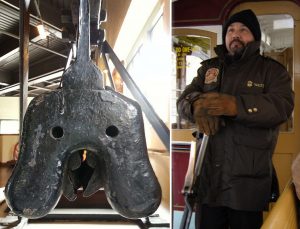
My 31-year career at Lawrence Livermore National Laboratory can be likened to the operation of a cable car, like those running on the streets of San Francisco. (Oh, really? you may ask.) Bear with me here; let’s try this out.
Cable cars are pulled along by a 1.25-inch-diameter cable beneath the streets of San Francisco. That cable runs at a constant speed of 9.5 mph, driven by an electric motor located in a central power house. The forward movement of the car is determined by a highly skilled gripman (left), who controls the way a “grip” (far left) grabs hold of the cable. When he grips the cable tightly, the car is pulled along at the speed of the cable. When he releases his grip, the car coasts, independent of the cable, until he again tightens his grip on the constantly moving cable. The many steep hills of San Francisco require a tight grip on the cable when there is a need for the car to travel uphill. When downhill is the right trajectory, the gripman must skillfully manage the right combination of holding on and letting go to ensure a smooth ride that takes him and his passengers safely where they need to go.
Over the years, traveling through the six laboratory organizations I have worked for, there were times of intense activity (most of the time) pulled along by goals, deadlines, and budgets, and other times when the pace could be slower, allowing time to think and plan and reconsider the next steps. Those typical ‘intense’ times were analogous to periods of holding on to the grip and allowing the ‘cable’ (i.e., the mission of the laboratory) to pull us along at its own required pace. Sometimes other people controlled the “grip,” and therefore determined the pace and intensity of the work; other times I found myself, and others around me, in a position to determine the pace and allow us the luxury of coasting awhile. Frankly, the times of ‘holding on’ far exceeded the times of coasting. Such was the working life that had become familiar to me for more than three decades.
Gradually, as the little voice in the back of my head spoke up to make itself heard, I began to listen to a new idea: perhaps the time had come to let go of the grip for good and let the constantly moving cable under the street move on without me. (This, of course, also meant moving on myself, in a different direction, without them; but more on that later.)
So, it became a plan. The plan included a decision about when to let go of the cable and how to prepare those around me for that decision. The work of the organization I belonged to is important and that work will continue. There was no question that they could do it without me; but I cared enough about it, and them, to want the transition to be smooth.
Letting Go . . . of What?
At this early stage, it looks like this decision means letting go of several obvious things of varying importance:
- Time pressures: you know, the six o’clock alarm, scheduled meetings,
- Patterns of behavior: when and where to have lunch, choosing the route to drive to and from work every day, etc.
- Responsibility to others: day-to-day commitments we all make to each other to get the job done
- The ever-present, over-arching commitment to a common mission, requiring us to look ahead beyond the present task
- The “Sunday-night yuckies” – admit it, you know what that means.
After some thought, over the first full week of this experience, it seems that there are a few more substantive and enduring things I may be ‘letting go’ of. These seem to take the form of questions, rather than answers:
? Given the fact that a significant portion (though not all) of my identity has been formed by this multi-decade working experience, a question lurks: how much of my identity – my own sense of who I am – will I be ‘letting go’ of? What will remain? What new elements of my identity are yet to be formed by this new experience?
? And what about “letting go” of “them?” – those terrific people who have been such a part of my life all these years? Given the fact that I have formed wonderful working relationships and friendships over these many years, another unavoidable question hangs in the air: how many of those will I be ‘letting go’ of? Some will inevitably move on without me as they continue to grip the constantly moving underground cable. Will some of those connections remain? Part of me wants to leave them with the popular Italian song: “Non ti scordar di me.” “Don’t forget me.”
I suspect that answers to these ‘letting go’ questions may come later. But there is no doubt that letting go of my grip on that cable is not a trivial change.
How Does It Feel Today?
In the past, days off, vacations – even long ones – always had the awareness of an end-point. Always in the back of my mind, sometimes consciously, sometimes not, was the lurking notion that the “Sunday Night Yuckies” waited at the end of periods of time off from work. One of my first observations of the past week is the absence of that feeling. Today is Monday the second of May – not the usual kind of Monday – and there is no feeling of any forced pattern to the days to come. Ahead, we have plans to spend some days in Lake Tahoe, some in San Diego, others in Ashland still others in Yosemite in the fall. I am suddenly aware that each one carries the new future that, when we come home from travel, near or far, I will not be going back to work on Monday.
What About Tomorrow?
There is much I don’t know about the future (OK, it’s everything that I don’t know about the future.) So I will rely on another of my favorite literary sources for understanding on that topic: Star Trek VI: The Undiscovered Country (1991). That movie was full of references to Shakespeare, but the title, set against this particular story of hope for the future, has a dual source of wisdom. It suggests that “the undiscovered country” does not have to be death (as it is in the source: Hamlet’s “To Be Or Not To Be” speech). By implication, it also doesn’t have to mean the imminent arrival of decline. For those of us willing to look forward with optimism, the ‘undiscovered country’ is the future. Captain Kirk’s final instruction to his crew is to set a course for the “Second star to the right and straight on ‘till morning.” That, of course, recalls Peter Pan’s directions to Neverland, where creatures never grow up or, at least, cease to age. In any case, this appeal to “the undiscovered country” is my expression of optimism – to reject the appearance of an ending — that the future, though unknown, is not a place to be feared, but something to anticipate with optimism.
Kirk: I think it’s about time we got underway ourselves. [sits on captain’s chair]
Commander Uhura: Captain, I have orders from Starfleet Command. We’re to put back to Spacedock immediately … to be decommissioned. [long pause as Kirk considers the order]
Spock: If I were human, I believe my response would be “go to Hell.” [Kirk looks at Spock. Spock repeats to Kirk] If I were human.
Chekov: Course heading, Captain?
Kirk: Second star to the right and straight on till morning.
Download a PDF of this post: ConVivio_Retirement_pt1
![]()
Staying Human: People Who Make Us Smile
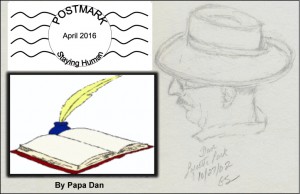
“Unless someone like you
cares a whole awful lot
Nothing is going to get better.
It’s not.”
— Dr. Seus
A month or so ago, with the presidential primary season just heating up, I couldn’t resist the need to step in it; so wrote a column about the future of the Democratic Party. In that piece, I cited David Brooks’ column about the future of the Republican Party, and followed it with another piece on the same topic: It Can’t Happen Here. In response, Gretta asked a thoughtful question: “Aren’t we tired of all that yet?”
OK. I agree. I am tired of all the negativity (for now). So, instead, I’d like to take a breather from all of that and contribute a little something positive to the mix. Let’s take a look at some evidence that the future, maybe even the present, is brighter than all of that political bloviation suggests. Let’s start with some people on the public stage who work hard to make us smile. Here is my candidate for “people who make us smile.” If you have another candidate, send me some details and we can all smile a bit.
Who is Jon Batiste?

Jonathon “Jon” Batiste is a singer, multi-instrumentalist, educator, and bandleader from Kenner, Louisiana. He has worked with acclaimed musicians in various genres, released his own recordings, performed in 40+ countries, acted in film and TV, and was appointed Associate Artistic Director of the National Jazz Museum in Harlem. Jon regularly tours with his band Stay Human and, in 2012, he was listed on ARTINFO among the “30 under 30” most influential people in the art world. He earned a master’s from Juilliard, and since Sept. 2015 has been the music director and bandleader for The Late Show with Stephen Colbert.
From his earliest days, his parents told him to “Go play” and especially, “Go play outside.” So, when he was six, they threw him out on the stage and said, “Go. Play”; so he started playing with the “Batiste Brothers Band.” From those early instructions, he has adopted “play outside” as his trademark and made a name for himself playing on the NYC subway. After being mentored at Julliard by Wynton Marsalis, he rose quickly in the music world, leading to a 2013 Carnegie Hall gig, which he began by playing from a seat in the audience.

His band, “Stay Human,” which appears nightly on Late Night With Stephen Colbert, draws its name from the belief that the human interaction of a live musical performance can uplift humanity in the midst of the “plug in/tune out” nature of modern-day society. Maybe live music can lift us above the … well, you know. Either on tour or during time off, the band can be seen spontaneously playing in nontraditional venues and starting impromptu demonstrations in the streets — events that Batiste and the band have termed “Love Riots.” He makes a lot of people smile, including Stephen Colbert (and me). Give this TV partnership a try – week nights on CBS — it will make you smile as well.
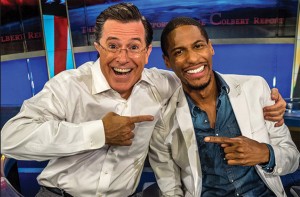
Well, OK. Enough about the bandleader.
What about the host?
Can Stephen Colbert make us smile?
Try it out . . .
https://www.good.is/articles/bernie-sandwiches
Now, tell me that didn’t make you smile, just a little, eh? – especially the sandwich part. These guys are fun and we need some of that. AND you don’t have to put your head in the sand just to laugh with these guys. If you listen carefully to the jokes, Stephen is telling us a story that we need to hear. If you haven’t seen the show, give it a try. If you don’t like it, I’ll give you a full refund.
Download a PDF of this post: Staying_Human_ConVivio ![]()
It Can’t Happen Here
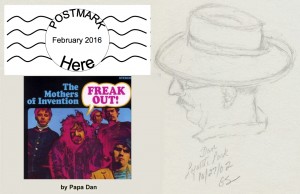
“Those who cannot remember the past are doomed to repeat it.”
— George Santayana
“I’ve got news for Mr. Santayana: we’re doomed to repeat the past no matter what. That’s what it is to be alive.”
— Kurt Vonnegut
Naw, Can’t Happen, Not Here
Now that we are within the last month of the 2016 election, I couldn’t resist the impulse to renew a “warning” that was written back in 1935. The temptation to write about the election has been strong. So, back in January, in the early days of the primary season, I wrote a column about the future of the Democratic Party. At the end of it, I cited a column by David Brooks about the future of the Republican Party. You probably noticed that neither of these were actually about the candidates; they are about a larger question about our political process. After posting that piece, I sat down to watch a series of interviews in which people who had attended the last Republican debate were asked what attracted them to the various candidates.
As I listened to what they liked about Donald Trump, it occurred to me that I had heard some of those messages before. Some wore hats that repeated his theme, ”Let’s make American great again.” They liked the fact that he wanted American to win more often – “We don’t win anymore. When I am president, we are going to win!” They cited his desire to restore what he considered “traditional American values” like order and corporate prosperity (“If we strengthen American corporations to they will bring profits back home”). They resonated with his interest in building a wall to keep them out but because they are coming here to do us harm. He blamed an incompetent and weak government in Washington, especially the Congress, for most of our troubles. They liked is plan to destroy our enemies. How? “We’ll carpet bomb them all,” he said. That all sounded familiar; I recalled hearing that somewhere before. But where?
And then I remembered.
For a high school book report, I read a novel recommended to me by my English teacher in 1966. It Can’t Happen Here is a 1935 novel by Sinclair Lewis, published during the rise of fascism in Europe. Let’s travel back to the world of that novel and see what happens, in the world of fiction, of course, when a fearful America elects an extreme charismatic corporate leader in a time of crisis.
An update –> Just this past week, four of us attended the stage adaptation of that novel at the Berkeley Repertory Theater. Although this play only slightly modified the details from the way the story was written in 1935, it was frightening in its similarity to the issues, characters, and divisions among Americans that we know so well in this 2016 election campaign. The story is a reminder — OK a warning — of what is at stake in this election. The play runs through November 6 (yes, two days before our own election day); so if you are interested, there is still time to see it. Here is my synopsis:
Back in time to the world of the novel
The novel describes the rise of Berzelius “Buzz” Windrip, a charismatic and power-hungry politician (patterned after an extreme corporate leader of the time). In the novel, Windrip runs for president of the United States and easily defeats Senator Walt Trowbridge and Franklin Delano Roosevelt, promising to restore the country to its former greatness and prosperity. He portrays himself as a champion of traditional American values. Foreshadowing some authoritarian measures that would emerge in the the fascist nations of Europe, Windrip reorganizes the US government — he rapidly outlaws dissent, arrests political enemies, and trains and arms a paramilitary force called the Minute Men, who terrorize citizens and enforce the policies of his “corporatist” regime. One of his first acts as president is to eliminate the influence of an ineffective Congress, which draws the ire of many citizens as well as the legislators themselves. The Minute Men respond to protests against Windrip’s decisions harshly, attacking demonstrators with bayonets to keep order, as he had promised. In addition to these actions, Windrip’s administration, known as the “Corpo” government, curtails the rights of women and minorities, and eliminates individual states by subdividing the country into administrative sectors managed by “Corpo” authorities. Those accused of crimes against the government are convicted in kangaroo courts presided over by Windrip’s hand-picked judges.
Despite these dictatorial measures — and this was not credible to my adolescent mind in 1966 — a majority of Americans in the novel approved of these policies, seeing them as necessary but painful steps to restore American power. Crowds cheered. Others, those less enthusiastic about the prospect of “corporatism,” calling themselves conservatives, reassure each other that fascism “cannot happen here.”
The novel foretells the results of electing a charismatic leader who offers these kinds of simple solutions to difficult problems. In time, Windrip’s hold on power weakens as the economic prosperity he promised does not materialize and many Americans, including many of the supporters who helped him gain power, flee to both Canada and Mexico. Chaos ensues as former supporters return to overthrow him, replacing him with weak government, creating a power vacuum, and a violent coup. New leaders try to restore popular support and patriotism by launching an unjustified invasion of Mexico, using mass conscription. Riots and rebellions break out across the country, with many realizing that they had been . . . misled. The novel ends with the outbreak of civil war and an underground movement emerging from occupied portions of southern Minnesota.
Minnesota?!
Back in the “Real World”
In 1936, back in the “real world,” a stage version, also titled It Can’t Happen Here,[5] premiered simultaneously on October 27, 1936 in 21 U.S. theatres in 17 states[6], in productions sponsored by the Federal Theater Project, a New Deal agency of WPA. A film version was in preparation at MGM, but studio head Louis B. Mayer canceled the production anticipating potential problems in the German market.
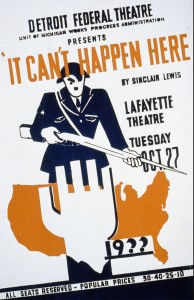
In 1982, an adaptation titled Storm Warnings was presented to NBC as a TV miniseries, but NBC executives rejected the initial version, claiming it was too cerebral for American audiences. To make the script more marketable, the American fascists of Windrip’s “Corpo” government were re-cast as man-eating extraterrestrials. The revised story became the miniseries V, which premiered in 1983. Other versions have appeared, with limited success and little of the intended influence.
Poster for the stage adaptation of It Can’t Happen Here,
October 27, 1936 at the Lafayette Theater.
Back to the 1960s, I went to the record store early in 1967 and bought a new album by a group called Frank Zappa and The Mothers of Invention. A very much “atonal” little song called “It Can’t Happen Here” got my attention. Click below to listen. The lyrics are below that.
Oh, and it won’t happen here.
Click to download this post in PDF: Cant_happen_here_ConVivio_OCT_update

Epilogue: As I finished writing this piece, Gretta asked a pointed question that deserves an answer, “Aren’t we tired of all that yet? Isn’t there something more positive you can contribute?”
I will attempt to address that question in my next post – wait for it.
The Democratic Future, Views from 2005 & 2016
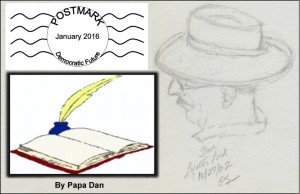
“The choice is fairly simple. It is a choice
between leading and following.”
— Dan Sapone
January 1, 2005
During the current early-primary political season, as I listen to the analyses of our current crop of pundits and campaign strategists, I have the feeling that I have heard some of it before. One of the key questions on the table, particularly regarding the future of the Democratic Party is this: which part of the political spectrum should the successful candidate “claim” as the basis for a path to victory. In simplistic terms, that spectrum spans a wide swath of territory from the “liberalism” of the far left to the “conservatism” of the far right. Since the middle of the 20th century, conventional political wisdom in America has held that either side of that divide must rely on some portion of the political center to supplement their own political base to win a national election. While our short-term focus here in the early weeks of 2016 is on the race for the nomination, that question applies directly to the general election in November. So, where have I heard this discussion before? Ironically it was in a column I wrote for the “New Century Muse” (no longer with us) on January 1, 2005 entitled “Finding Their Place: What Next for the Democratic Party?” Democratic_Future_2004
The Democratic Party faced this same choice after the 2004 election. In 2005, I wrote:
“In 1992, Bill Clinton and his strategists made the judgment that the country had moved to the right during the 12-year Reagan/Bush presidencies. Along with that judgment came the determination that Democrats could not win an election with a majority based on the left end of the political spectrum. So, to win a national campaign, Clinton reasoned that a majority must be found that includes as much of the center of the political spectrum as possible. So, the campaign strategy, and the subsequent election results, looked something like this.
This was an effective strategy in that it successfully isolated Republican candidates — George H.W. Bush in 1992 and the Bob Dole in 1996 — on the extreme right AND stranded the extreme left with nowhere to turn except Clinton (with the unpalatable third choice of Ross Perot). The good news for Democrats was that this strategy yielded a two-term Democratic presidency. The bad news was that it planted the seeds of the polarization we are experiencing today.”
That column from eleven years ago explained the details of how that happened. The most notable detail is that Clinton was beating Republicans on some of their own issues, attracting voters from that “Center.” What’s relevant today is that the “Center” that propelled Bill Clinton to two presidential terms in the 90s, does not exist today. Polls and recent experience tell us that there are not significant numbers of voters of either party who will cross the divide and vote for candidates of the other. So, in today’s polarized electorate, the winning strategy for any Democratic candidate for president in 2016 must look like the one predicted back in January of 2005. It will have to look like this:
To win both the Democratic nomination and the general election in 2016, any Democratic candidate must follow that old 2005 advice:
The choice is fairly simple. It is a choice between leading and following. Their task is to persuade a significant portion of the American people to follow Democratic leadership back to the left. In spite of the Clinton success of the 90s, a dispassionate analysis of that strategy was that it was a strategy to follow the perceived trend in the American electorate to the right. It was not a strategy to lead anyone. If Democrats are going to regain a position of influence in the U.S. government, they must stand up for their traditional core values and persuade Americans that those values are important. They must lead.
So, howya-gonna-do-that? Once again, let’s take a look back to 2005:
“Educating America
The central task is one of basic education. It does not take a terribly long memory to recall that, in the 1960s and 70s, the phrase “Christian moral values” meant basically one thing — in popular culture as well as in churches and synagogues: it meant taking care of the poor. Remember that Lyndon Johnson, before he got us mired in the Vietnam War, was a hugely popular and powerful Senator and President because he succeeded in painting the image of Republicans as uncaring toward poor and minority Americans. His Civil Rights Act and his “Great Society” legislation passed a reluctant Congress in part because it was portrayed from pulpits across American as the Christian and moral thing to do.So, what changed? The neo-conservative movement in America embarked on a brilliantly orchestrated and hugely successful “educational” campaign to redefine morality in America. The new definition of “Christian moral values” focuses on whether you support abortion rights and with whom you have sex. That definition, and the rhetoric that accompanies it, specifically excludes the question of taking care of the poor.
This re-definition was not difficult to do — and liberals helped. During America’s “neo-conservative re-education,” those who supported abortion rights failed to articulate their “Pro Choice” position as supporting poor, largely minority, pregnant teenagers who had no choices but back-alley illegal abortions and poverty. Anti-abortionists successfully labeled liberals who supported abortions as “baby killers.”
Campaign rhetoric and marketing surrounding gay and lesbian rights followed a similar path. Liberals failed to promote the idea that the right to marry is a basic building block of mainstream society. They could have argued that same-sex marriage would bring homosexuals into the mainstream of American life with all of the stabilizing forces and behaviors that strengthen communities. Instead, they allowed Republicans to associate their cause with particular sexual behaviors.
On economic issues, both religious and Democratic leaders simply failed to reinforce the connection between economic disparity and moral values, between the Bible and the Federal budget, and between tax policies and the widening gap between rich and poor. Republicans were free to define morality narrowly focused on marriage and abortion and ignore the morality of their economic policies.”
That’s what happened to get us where we are today. So, just as it was true in 2005, it is true today that the Democratic Party has work to do. If they are going to elect a president, whether it be a Bernie or a Hillary, and carry enough Democrats into the House and the Senate to actually implement progressive policies, they must lead. They will have to follow advice they were given eleven years ago:
“[It] must stand up for the distinctly American moral values that Americans have supported throughout their history and they must lead in the direction of basic human rights and economic justice. People will follow, Democrats and “Greens” alike, if Democrats do the hard educational work of reminding Americans who they are and what moral values have always meant to them.”
The bad news is that it may take awhile. The worse news is that there isn’t time. There is much at stake in 2016 – from the fate of the shrinking middle class to the long-fought-for human rights that the Supreme Court will certainly be called on to defend during the coming presidential term — and there is little doubt that the next president will shape the nature of that court for a generation. I hope that the candidates will exhibit the wisdom to promote these distinctly American values and resist the temptation to attack each other on the specifics. They must not lose sight of the reality that one of them must be elected president. The future depends on it.
Download PDF of this article: Democratic_future_ConVivioJan16
![]()
==========
Epilogue: Just as I finished this column about the future of the Democratic Party, I decided to write a parallel column outlining my view of the future of the Republican Party. Unfortunately, that same day, David Brooks (New York Times Op-Ed columnist and author) beat me to it. His column is found at:
http://www.nytimes.com/2016/01/19/opinion/time-for-a-republican-conspiracy.html.
I couldn’t have written it better myself. — DRS
Grace
I do not understand the mystery of grace
— only that it meets us where we are
but does not leave us where it found us.”
— Ann Lamott
Seeking Harmony in a Tradition of Grace
On Saturday, December 12, Gretta and I continued our nineteen-year tradition by attending “A Cathedral Christmas.” It is an annual Christmas concert of the Men’s and Boy’s Chorus, orchestra, and pipe organ, at Grace Cathedral in San Francisco.
For us, the tradition is in the music — for the music is truly magnificent. Usually, the concert focuses on two principal themes:
1) the joy associated with the birth of The Child — represented by well-known Christmas carols in the first and third segments of the performance — and
2) the peacefulness settling over the ‘Holy Land’ and the world, associated with the hope for peace that The Child would bring – represented by classic choral and orchestral music performed with sweetness and passion in the concert’s middle segment.
The signature piece of the Grace Cathedral Music Ministry has always been a tune called “Sleeps Judea Fair,” by Hugh MacKinnon. Gretta and I always look forward to this tune, in the middle segment of the concert, as the highlight of the season. The lyrics and the slow, soft harmony of the voices recreate the joy and peace associated with the season.
Settling into our usual seats on the aisle of Row S, at the acoustic center of the cathedral — one of America’s premier acoustical rooms — the stained-glass figures of the saints all around the cathedral, contributed to the warmth, peace, and harmony that we, and they expected. I opened the printed program to read the list of musical pieces. I had to study it several times before I realized that “Sleeps Judea Fair” was NOT listed.
It was NOT listed!
“What’s that about?!” I said out loud. As the choir emerged to begin the concert, I said to Gretta, “I’m surprised just how distressed I feel that it’s missing.”
“Me, too” she said.
The first segment of the concert contained the familiar choral pieces we had come to expect – like John Rutter’s The Holly and the Ivy — and others we all recognize. When the Men’s and Boys’ chorus left the altar for an intermission, a lively string quartet created a clever medley of carols interspersed within Bach’s Brandenberg Concerto #3.
Then, after applause for the quartet, the singers and the organist returned for the middle portion of the program, the segment that traditionally conveys the message of peace and serenity culminating in their signature piece, “Sleeps Judea Fair.” But, since that piece was not listed in the program, we weren’t sure what to expect.
What followed was a shock. The three pieces in this segment featured, from beginning to end, harsh spasmodic cascades of unresolved dissonance, typical of the more unsettling 20th century compositions. The last of these, clearly difficult to perform, included a few moments that sounded like small eruptions of harmony attempting to make themselves heard above the all-encompassing harshness, only to be musically shouted down and drowned out by the grating dissonance, ending without resolution. The faces of the saints in the stained-glass windows seemed to show the strain, their colors pale in the fading light. Then, in the final segment, the sing-along tunes like “Hark, the Herald Angels Sing” completed the program, as always. As Gretta and I attempted to sing along after the jarring experience of the middle segment, I realized what they had done. I said to Gretta, “I get it.”
It was a harsh message: there is no peace and harmony this Christmas season — not in the city, not in America, not across the world, and certainly not in Judea and the countries that surround it in the Middle East. The choir could not sing their signature piece, “Sleeps Judea Fair,” because the message would have been a false one.
I get it. I don’t like it, but I get it. We are being instructed to look harder for peace and harmony — and, finding none, create some ourselves.
Looking for Moments of Grace in a Grim Year
As we walked out of the cathedral on that beautiful December evening, humanity being what it is, our world remained a place of suffering and danger. I certainly didn’t have to look far to find many sources of harshness and struggle.
- Suffering and terror emanate from in the Middle East (yes, even ancient Judea) and have spread across the world in the form of war and poverty.
- The US continues to be plagued by gunfire — gunfire enabled by American leaders, local and national, determined to keep as many guns in the hands of as many people as possible.
- Our “tough-guy” politics is demonstrating its penchant for keeping us fearful and divided and promises to get louder and cruder in the heat of a presidential race.
- While unemployment has declined, under-employment and low wages are increasing across a shrinking middle class in America.
- Individuals with dark skin or who speak with foreign accents or in foreign languages are made to feel increasingly unwelcome or, worse, in danger in their own neighborhoods.
- In our cities, an increasing number of homeless individuals and families, who have dropped out of the middle class, are no longer looking for work, just struggling to find help — some sitting on street corners here on Nob Hill hoping for a few bills dropped in their basket by people emerging from expensive holiday concerts.
Looking around at all of this, we can find plenty of reasons to be discouraged. But Americans have often defied logic and looked around for moments of grace during hard times.
Looking at the sky on Christmas Eve, while some were hoping for a glimpse of Santa Claus, a rare Christmas full moon provided me with moments of willful optimism. I asked myself, “Can I look up at the brightness, tune out the rancor, and find reasons to believe in humanity’s better attributes: humility, conciliation, kindness, dignity, reason?
But, you know, if we look, there are hopeful signs everywhere, right down here on the surface:
- World leaders met in Paris this past month to reach an agreement that may yet stop our steady march toward an uninhabitable planet. The agreement offers our “last best hope” for meaningful global action to avert catastrophic climate change; and 195 countries promised to grab it. Can we succeed with so many industrial-strength forces working against us?
Can we?
- Pope Francis, naming himself after an Italian saint with a message of humility and peace, chose to visit the Americas and shine a mass-media spotlight on that message. He challenged the wealthy and powerful (including Congress) in the name of the poor and the weak.
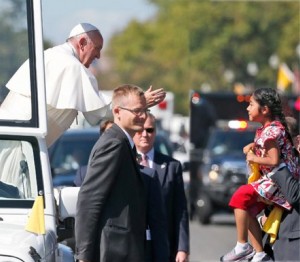
He prayed at ground zero and hugged a little girl who jumped a fence to approach his motorcade in Washington. Francis set a very public example of welcome for children, immigrants, the forgotten — asking us to follow.
Can we?
- Tens of thousands of refugees who fled their homes to escape the catastrophe in Syria found open doors and hearts in Germany and elsewhere. The response from some other nations continues to be fearful and inadequate, but the Germans sent a message to all of us that rebukes nationalist bigotry, defends human rights, and reminds countries like the US how to confront a humanitarian emergency. How long can they sustain it? In our own neighborhood, Canada has begun to follow the German example and may be teaching us how to respond as fellow humans. Is the challenge too big? Can we care for others on such a large scale?
Can we?
- This year, the US Supreme Court affirmed the marriage rights of same-sex couples who had been denied equal treatment under the law. Can our society accept them?
Can we?
- A bipartisan movement for criminal justice reform advanced in small steps, despite our ugly politics, asking “Can we find alternatives to mass incarceration and reduce the forces that sent so many Americans to prison?”
Can we?
- In neighborhoods long scarred by discrimination and police brutality, the Black Lives Matter movement spread a message of peaceable resistance. It is the method of that resistance that offers hope. Those small moments of progress are encouraging a similar struggle for a living wage for the lowest-paid workers in our prosperous land in a campaign for a $15 minimum wage. Small successes are emerging. Can we broaden those efforts across our workforce?
Can we?
- Dozens of states and cities, resisting vocal opposition, passed laws expanding rights and inclusion for undocumented immigrants, through driver’s licenses, legal services, and health care. Here in January, California has become the first state to forbid discrimination based on immigration status, language, or citizenship. Can we expand these moments of progress?
Can we?
In addition to these more visible, public efforts, some individuals led by example, opposing hatred and fear with compassion and courage in their own neighborhoods.
- Some Parisians opened their homes to strangers on the night of terrifying slaughter there.
- After a gunman’s rampage at an African Methodist Episcopal Church in Charleston, S.C., victims’ families publicly forgave the killer. The mayor said “A hateful person came to this community with some crazy idea he’d be able to divide us, but all he did was unite us and make us love each other even more.” President Obama sang a song (not among his core skills) at that South Carolina church — Amazing Grace. The congregation stood up and joined him and, a few days later, the Confederate battle flag came down at the South Carolina State Capitol. It was a symbol of a distinct piece of our American character that we cannot deny. Can we bring down more than just the symbols?
Can we?
Evil is everywhere; and anger and hatred are loud. The shouting and the dissonance can drown out the quiet voices and the moments of harmony, even in Grace Cathedral. Tragedy and disaster can block our view of goodness. Yes, it can. And yet, there are signs of progress toward a better future. We need to look carefully for those signs, or we may miss them. Better yet, can we create more of those signs of progress for others to see?
Can We?
After seven years, I haven’t forgotten the words, “Yes, we can.”
But, as I look at the state of the nation and the world here at the start of 2016, it is clear that the “We” in that optimistic phrase has not been enough. Could it be that the era of reliance on “We” is coming to an end? Perhaps it must begin with “Yes, I can.”
Can I?
What can I do, as an individual, to make a difference? Since “grace” does not seem to be emerging from the “We” of national and international institutions, I suppose it is going to have to begin with me.
But How? I suppose there are lots of options. What do I need to do?
Maybe I can start by contributing to organizations that do the work I can’t do on my own — some of our favorites: Planned Parenthood, Reach Out and Read, Boys and Girls Clubs, Sierra Club, Yosemite Conservancy, Valley Humane Society, American Civil Liberties Union, KQED, The Kidney Foundation, Hillary for America. All are hopeful efforts.
It’s not enough; but it’s a start.
Download a PDF of this post: Grace_Dec15_ConVivio_Jan9_2016_v2
A Village at a Bend in the River — A Fable
We thought that we had the answers, it was the questions we had wrong.
Bono
In school, we’re rewarded for having the answer, not for asking a good question.
Richard Saul Wurman
Once upon a time, a small village sat happily at a bend in a river that meandered through a green valley poised among some rolling hills. The shape of that bend was a pleasant feature that provided some simple benefits — boys could sit along the near bank on a summer’s day with fishing rods and catch the lazy catfish that the flow of the river generously delivered to them; holiday picnics could be set up by the wise Council of Elders in the grassy field across the river with the help of large rubber rafts; and the gentle lapping of water against the rocks on their side of the bend provided a soundtrack for wondering minds to imagine places up and down the river that they had never seen, occupied by people they had never met — for there was no reason for the people of this proudly self-sufficient village to venture beyond their field of vision, here at this bend in the river. The fields behind the village provided seasonal crops of fruit, vegetables, and other edibles year round, since they were fairly expert at rotating their well-tended fields to yield all they needed. The chickens and pigs raised in the barns at the south end of the village provided meat and eggs. They had what they needed and didn’t feel the need for more.
 One Wednesday afternoon in July, a 14-year-old boy named Tom was fishing at the bend – his feet up on a smooth rock, fishing rod in one hand and a beer can in the other (surreptitiously borrowed from his Dad’s fridge in the garage). Fish didn’t seem to be biting on this particular afternoon but, no matter, the sun was warm, the water was calm, and the beer was . . . well, it had started out cold. Tom was just about to call it a day when he noticed something floating toward him from the usual direction up the river. It was fairly large – maybe a log – nothing remarkable really; but as it got closer . . . you know when you see something unexpected that doesn’t quite fit with the surroundings and it takes a while to recognize it? It drifted right to him and bobbed gently against the rock beneath his feet. But it rolled a bit and . . .
One Wednesday afternoon in July, a 14-year-old boy named Tom was fishing at the bend – his feet up on a smooth rock, fishing rod in one hand and a beer can in the other (surreptitiously borrowed from his Dad’s fridge in the garage). Fish didn’t seem to be biting on this particular afternoon but, no matter, the sun was warm, the water was calm, and the beer was . . . well, it had started out cold. Tom was just about to call it a day when he noticed something floating toward him from the usual direction up the river. It was fairly large – maybe a log – nothing remarkable really; but as it got closer . . . you know when you see something unexpected that doesn’t quite fit with the surroundings and it takes a while to recognize it? It drifted right to him and bobbed gently against the rock beneath his feet. But it rolled a bit and . . .
Stunned, he scrambled to his feet, knocking the near-empty beer can into the river. He couldn’t quite believe what he saw – a person, or so it seemed, a man, an expressionless face . . . motionless except for the rising and falling caused by the lapping water. He opened his mouth and gasped but no sound came out. He had never seen a dead body before, but this certainly looked like one.
What to do? His eyes flashed right and left and then back to the apparition before him, his mouth still open, finally unable to take his eyes from the floating object in the water. He began to cough and then struggle for air. His arms reflexively reached for the body and then recoiled just as quickly. He wanted to yell, but this fishing spot was selected precisely because people didn’t often walk by. So, he was quite alone. A new thought was quickly dispelled — did this person need help? But he looked quite beyond help.
So, after staring for what seemed like a long time, he gingerly grabbed the nearest arm, and found it to be fairly easy to drag the rest of the floating body up on the smooth rock. Suddenly fearing he would throw up, he took some deep breaths and began to run up the bank, tripping twice on nothing in particular, looked back once more, and hurried back to town.
Half way there, still gasping, he realized that he didn’t quite know what he would do when he got there. The first person he met was Mr. Crenshaw, owner of Crenshaw & Sons Bait & Tackle, “Guess they’re not biting today, eh Tom?” And then, “You OK? You don’t look so good.”
Tom stopped, trying to catch his breath enough to talk, but all he could do was point down to the bend and gasp, and finally, “Dead! I think he’s dead! I don’t know . . . ”
“Well, now, Tom, get hold of yourself.” He put his hand on the boy’s shoulder; Tom was bent over, leaning on his knees. “What is it, boy?”
After Tom regained enough composure to recount the sparse facts, they both found their way down among the rocks to the bend. Tom stopped well short of the body and pointed. “There.”
Mr. Chenshaw tilted the body enough to see the face. “Well, yes, he’s beyond anything we can do for him. Doesn’t look familiar. I guess we’ll need some help.” Tom started scrambling again. “Tom. I don’t think we’re in a big hurry. We need some help, Tom; but he doesn’t.”
Back up at The Bait & Tackle, Mr. Crenshaw and his two grown sons pulled a plank and a tarp from the back of their flat-bed and brought the body up the bank to the truck and drove it to the fire station. Before long, the mayor, the fire chief, a police officer, and Ted Dawson from the mill gathered around the body, and reviewed the facts, as sparse as they were, and talked about what to do.
This town was proud of its ‘can-do’ attitude and believed in the principles of efficiency and well-practiced procedures that had served them so well for generations in the way they conducted their businesses, managed their homes, and taught their children. There were no problems that daunted them. When something new seemed to present a challenge, they relied confidently on established experience and sought the wisdom of the town’s Council of Elders to guide the way. The obvious decision was quickly made to respectfully bury this unfortunate visitor to their bend in the river in an unassigned section of the town’s well-tended cemetery and go back about their business. The task was completed before sundown.
As Al Crenshaw and Ted Dawson climbed out of Al’s flatbed in front of the Bait & Tackle, two boys came scrambling back from the bend with a familiar story, “Three more,” said Jack Knowland, breathlessly. Turns out that word had spread pretty fast about the morning’s surprise and a number of curious teenagers wandered down to the bend to see what they could see; and they saw more than they expected. Three more bodies had drifted into their bend in the river. Al and Ted knew what to do, got a few more neighbors to help and there were three more graves in the yard before midnight. There was the typical feeling of accomplishment from a challenge met, but as they said goodnight, the looks that were exchanged between them said, without words, “What’s going on here?” as they ambled their separate ways, home from a long day.
• • •
For most, Thursday morning started in the usual ways: Crenshaw & Son’s Bait & Tackle opened at the usual hour for those preparing for a weekend of fishing; Riverside Lumber Mill loaded a long-bed cut of pine from the woods just west of town; Barton’s Electrical had a handful of contractors preparing to install some lighting around the newly landscaped park; Dependable Building Supplies began work on a gazebo and bandstand in that park; and Europaville Coffee-n-Donuts served the usual collection of ‘to-go’ customers on their way to work along with the usual retired guys who sat their usual 90 minutes holding forth about the weather and the prospects for a good olive harvest. Donuts were still the favored breakfast, but bagels were starting to make inroads into the typical morning fare. Of course, there was some talk about the four unfortunate strangers who had to be quickly buried up the hill. Some were hearing about it for the first time. “Young Tom Egan found the first one.” It was Dave Abel: “Al Crenshaw says the kid could hardly talk he was so stunned. Thought he was going to puke. I guess he learned some grown-up things, eh?
Then, suddenly everything changed. Everything.
• • •
Mayor Bradley burst in – “Guys . . . I’m need’n’ some help. Lots o’ help. Right now, come ON!!”
What’s the matter, Jim, you look like . . .”
“This time it’s more than a dozen, come on. Right now.” Mayor Bradley never raised his voice for anything, so they knew to move. “Down to the bend. Al’s got his truck down there. It’s bad.”
On the way to the bend, they learned that fifteen more bodies had washed onto the rocks overnight. When they got there Chief Davis was clearly in charge, barking orders and making decisions. “Too many to bury individual. Gotta be common. Jake’s got his backhoe. Need to load ‘em up quick — get ‘em outta the water, fergodsake, and haul ‘em up the hill. Let’s move. This can’t wait.”
The men dispatched their assigned tasks with the same efficiency and focus as the smaller group had used on the original four the day before. It was their nature. But they didn’t have time to admire their teamwork and know-how in an emergency. By mid-afternoon the number coming down the river to settle against the rocks at the bend had doubled and they were piling up. They worked diligently to stay ahead of the flow and stack them up the hill to await the digging. By nightfall, nobody was counting. The steadiness of the volume was astounding, it just didn’t stop – until about nine when the numbers reduced to about a dozen an hour, giving them hope that they might get ahead of the task if they kept at it. Once a sizable crew had been organized and settled into a rhythm, the mayor left Ted Dawson in charge and assembled Europaville’s Council of Elders in the library for some planning.
“Gentlemen, I haven’t seen anything like it, well not since the war, but never in a town like ours. But I figure we know how to handle an emergency. Barton and Davis tell me they can fashion a conveyor. Crenshaw’s boys got Jake’s second backhoe running and figure they can dig the other side of the hill quicker and deeper where the soil’s softer. Dirt from the second set of holes can fill the first, and so on.” Decisions were made; sandwiches and water would be distributed; older guys would be rested every half hour; the mayor could be a commanding figure when there’s a need, “Barton’ll rig up some lights, we can keep it up all night if we hafta!” The mayor was conscious of the need for optimism.
Progress, even in the dark, was considerable; and in the early morning hours, under a sliver of moon, the work slowed to a halt for a few hours of rest.
• • •
Those who were thinking that the worst was over had a dramatic shock when the sun came up over the bend in the river. The cluster of bodies that had built up at the bend was an overwhelming sight, more than they had seen all day yesterday. After a few minutes of staring at the accumulation, the mayor gathered the men and a few of the teenagers, any who were within earshot, at a picnic table in the park, just a few yards from the conveyor. “Guys, we have to step this up. We’re gonna need some of you boys with us. Dawson, can you widen the conveyor? You know, double it? Barton can you get us some more power, it’s gonna have to carry some serious weight. We’ll need another patch of land for another graveyard, and we’ve got to reconsider the depth.”
The assembled group, less orderly and more breathless than the previous meeting, leaned in to study the drawing Barton was making of a structure to handle the larger conveyor, all nodding approval. Doc Samuels began a side conversation about the health issues for the water supply. Tom Egan, the boy who had found the first body, was hanging around the periphery of the meeting wanting very much to say something ‘grown up’ and maybe be of some use. He said something to nobody in particular: “God, I wish all these people could be coming down the river alive, you know?” Barton paused mid-sentence; someone said, “I just can’t imagine . . .” but Barton went back to describing how the rollers could move more weight uphill if they were double-belted. Then Tom spoke up a bit louder, surprising even himself with the forcefulness of his voice, “Hey, what if we sent someone up the river, you know, coupla guys maybe, and find out what’s killing all these people? D’ya think maybe there’s something we could do about this up there, you know, at the source?”
All three conversations stopped at once. Each of the men looked up at Tom for along moment, mostly blank expressions, some looked at each other and back at Tom, then, pretty much simultaneously, turned their attention back to the drawing of the conveyor, the electrical diagram, and the discussion of the water supply. “You know, I think we can get ahead of this with parallel crews alternating between the first hill and the second . . . Sure the water’s gonna be affected for awhile, but I think Crenshaw could fashion a filter, a FILTER, that could keep it clean enough . . . whaddayathink, Doc?”
And with the increasing magnitude of the challenge, they went on into the evening, demonstrating their optimism, stretching their capacity for an unprecedented workload, showing their ability to plan, and making use of their skills as builders, system designers, and innovators. They had elevated their response to this challenge to industrial levels of efficiency and follow-through, without asking each other questions like, “Who were these people?” “Why was this happening to them?” or “Who did they leave behind?” Meanwhile, Tom and his young friends, knowing their place, just listened . . . and learned from their elders.
![]() Download this story as a PDF: Bend_in_the_River_ConVivio_Sept2015
Download this story as a PDF: Bend_in_the_River_ConVivio_Sept2015
A Monday Afternoon On a Train to Paris
“You get old and you realize
there are no answers,
just stories.”
— Garrison Keillor
=================================================
We have ridden quite a few trains in Europe over the years — short rides between Milano and Varenna, longer rides across Italy, France, Austria. Overall, they have been smooth, comfortable, and convenient experiences. Some have provided stunning views of colorful, expansive countryside. Occasionally, they offered interesting conversations with fascinating people (take a look at one: https://convivio-online.net/?p=1073).
Our trip to Europe this past May/June included three. The first was a pleasant, five-hour ride from Varenna on Lake Como to Antibes at the tip of the French Riviera. The third was a swift, luxurious swoop to London under the English Channel on the Eurostar. In between those, we expected the most interesting part of our second high-speed train ride to be the swaths of bright yellow colza that carpet the three-hour ride from Avignon to Paris.
Instead, it turned out to be a dark page from the hard news stories that we hear nearly every day.
 I suppose we could have taken it as a warning sign when we had an unusually difficult time finding the right platform at the Avignon train station. The uniformed attendant we asked to help us find Platform Z dismissed us with a wave and a bored mumble: “Platform Z is the last one” as he walked away to do something more important. Finally, a gentleman in a suit confirmed that we had found the right one.
I suppose we could have taken it as a warning sign when we had an unusually difficult time finding the right platform at the Avignon train station. The uniformed attendant we asked to help us find Platform Z dismissed us with a wave and a bored mumble: “Platform Z is the last one” as he walked away to do something more important. Finally, a gentleman in a suit confirmed that we had found the right one.
So, we found our seats and sped along, passing a pleasant hour enjoying the scenery and talking to a businessman across the aisle who appreciated the on-time reputation of the TGV train service, giving him confidence that he would be able to make the tight connection to the next train so he could be on time for his meeting.
At what seemed to be about half way to Paris, quite in the middle of nowhere, the train slowed to a stop at a concrete facility — not really a station, just a place with flat surface beside the tracks and a sign that said, in English, “Check Point.”
After a minute or two, I began to notice out my window a collection of officers, wearing three different uniforms, assembling beside the train. They began boarding the train at the gap between our first-class car and the car ahead of us, climbing the stairs to the upper car. After a few minutes, a pair of them re-appeared, each gripping with both hands the arm of a short-haired, clean-shaven man, whom they removed from the train and escorted forward out of our sight. Then another pair, similarly escorting another young man, and another, and another, until after an hour or so, we had counted seven who had been removed in the same way. We didn’t see any struggle, as each of those who were being removed walked as directed, eyes straight ahead, while in the firm grip of a pair of large uniforms.
I remember being struck by the fact that no one in our car said a word, we all just watched in silent attention until the businessman across the aisle from me leaned over and murmured, “Libyans, I guess.”
The train slowly began to move until, after 100 yards or so, I heard an audible gasp from the people in our train car. I looked out the window and saw what they saw — about 200 or so men, like those seven we saw escorted from our train, were sitting cross-legged, a few yards apart, hands behind their backs, guarded by an ample number of heavily armed men in uniforms. I gasped myself, as we passed in silence.
After a while, conversations in our car agreed on an estimate of 250-300 individuals. It was stunning to think that so many had been removed from our train — the train we had searched for along the platforms of Avignon station in the bright sunshine of a Monday afternoon, on our way to Paris. The train was an hour late at Paris Nord train station, but we arrived by taxi at our hotel on Rue de Saint-Louis-en-l’ille well in time for dinner.![]()
Headlines Come to Life: This Week in the New York Times
Tourists Traveling Through Europe’s River of Migrants
150 Migrants Feared Dead after Boat Sinks Off Libya
Migrants Transiting Through Macedonia Jam Trains
Hundreds of Migrants Try to Cross English Channel on Trains
Britain and France to Announce Measures to Contain Migrant Crisis
Migrants Race North As Hungary Builds a Border Fence
Bodies of 71 Migrants Found In Truck In Austria
Epilogue
On our second day in Paris after the train ride from Avignon, we walked from our hotel on Rue de Saint-Louis-en-Ille, across the footbridge over the Seine to I’ille de Cité, to visit Notre Dame cathedral. We had been there before and, over the years, we’ve thought of it as one of the most serene places in Europe. We crossed the familiar garden, passed a student group rehearsing a dance performance of some kind, circled around to the front of the church, and stopped at the sight of something we hadn’t quite seen before. We had certainly seen security guards before, around major monuments in Europe, but this was different. Three soldiers — not security guards, but fully uniformed, helmeted, flak-vested, heavily armed members of the French military — were walking purposefully across the courtyard in front of the church, scrutinizing the hundreds of tourists standing in line to go through metal detectors. These two held automatic weapons ‘at the ready.’ A third soldier stood at a distance in the same pose, appearing to be watching out for the other two. We sat down on a bench and watched as two more armed soldiers turned the corner from behind the cathedral.
They looked familiar.
I didn’t photograph them, just as I had not photographed the soldiers I had seen on the train two days before — it somehow didn’t feel like a good idea at the moment.
Europe is changing. Perhaps we are the last to notice.
Click here to download a PDF of this article: ConVivio_Afternoon_train_to_Paris_Aug29_2015
Chasing the Shade
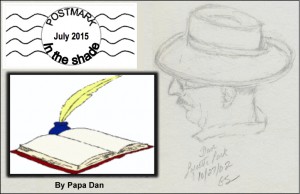 I am sitting at my desk staring at the tip of my fountain pen, hoping for some inspiration; but the words are not coming — not an unfamiliar experience for me. Ideas, of course, come and go in various stages of completeness, sometimes stimulated by world events, other times from personal experience or reading, and most often from observing other people.
I am sitting at my desk staring at the tip of my fountain pen, hoping for some inspiration; but the words are not coming — not an unfamiliar experience for me. Ideas, of course, come and go in various stages of completeness, sometimes stimulated by world events, other times from personal experience or reading, and most often from observing other people.
Among those ‘other people,’ I have had the privilege of being exposed to some terrific writers over the course of my lifelong education, people like Wilder and Poe, Hemingway and Fitzgerald, Steinbeck and Twain, Frost and DeVore. Some of them made a habit of offering advice to other writers. So, at times of ‘drought’ like these, I’ve dutifully looked to them for guidance.
Staring again at the tip of this fountain pen trying to write my own story, I find that those writers offer a wealth of advice that sometimes seems to be aimed directly at me. Hemingway, the writing teacher I will quote today, is particularly generous with what sounds at first like such simple advice. He compares himself to other writers to provide guidance on the use of language: “Poor Faulkner – does he really think big emotions come from big words? He thinks I don’t know the ten-dollar words. I know them, alright, but there are older and simpler and better words, and those are the ones I use.” That sounds reassuring: use simple words, tell simple stories about real people.
But then, sometimes he can also be a powerfully intimidating teacher of what it takes to be a writer. “All good books,” he wrote, “are alike in that they are truer than if they had really happened; and, after you are finished reading one, you will feel that all that happened to you and afterwards, it all belongs to you; the good and the bad, the ecstasy and the remorse and sorrow, the people and the places, and how the weather was. If you can get so that you can give that to people, then you are a writer.”
Oh. That’s what I have to do?! Can I do that? Seems like such a tall order! At least I can emulate his occasional use of long sentences.
I think he tried to be comforting with simpler advice when he wrote: “The most essential gift for a good writer is a built-in, shock-proof shit detector. This is the writer’s radar and all the great writers have had it.” And then, he offers more comfort: “I write one page of masterpiece to ninety-one pages of shit. I try to put the shit in the wastebasket.”
And then, he provides specific guidance from his own process: “Write drunk. Edit sober.”
Having gotten the specific advice out of the way, I look for examples to imitate and I find one – simple instructions for improving one’s mood, again from Hemingway, no shit for the wastebasket, strung together into a single long sentence:
“As I ate the oysters with their strong taste of the sea and their faint metallic taste that the cold white wine washed away leaving only the sea taste and the succulent texture, and as I drank their cold liquid from each shell and washed it down with the crisp taste of the wine, I lost the empty feeling and began to be happy and to make plans.”
From the small and simple details of taste and texture can come powerful feelings that can make a difference. Hemingway sneaks up on you. I look up from his words and say to myself. “I could have written that.” But I stare at the fountain pen and acknowledge the equally simple truth: ”But I didn’t.”
Staring again at the tip of my fountain pen, my mind wanders from Hemingway’s sentence to two simpler, shorter, and more powerful sentences than anything I could have written. These came from two friends of mine, both of whom have been fighting cancer – one for a short time, one for a long time. Katie had shared her feelings in an email shortly after her diagnosis. She wrote about her attempt to bring back the comfort of the time before the cancer. She described an afternoon in the backyard with a task that seemed simple — walk out to the Adirondack chair and sit in the shade with a book and a glass of cold chardonnay. Seeking comfort in the backyard turned out to be a search for a respite from too much of even a good thing like sunshine. A few feet away a lemon tree was providing shade; so the next task was to seek the protection of the stationary tree from the glare of the sun.
As she positions the chair under the tree and gets comfortable in its shade, it didn’t take long to confront the illusion. The shade seemed stationary; and yet, in the words of Galileo (as an apology for having saved himself by denying the truth) “eppur si muove” “and yet it moves.”
We always seem to seek that illusion of permanence, don’t we — that the sunshine or the shade, whichever we prefer at the moment, will stay put, right where we want it? After some experience, we know better, don’t we? Is it merely the subconscious hope that something comfortable, stable, and safe, can be captured and held close to us? Maybe we eventually learn that growing up is the act of admitting to ourselves, and accepting, that everything in the universe, everything in the world, everything in ourselves, is moving. After that ‘simple’ observation, we try to anticipate that motion and move the chair to the place where the shade will end up, and we experience the further truth that nothing really moves in a straight line.
Damn. It was looking simple there for a while.
And then, there’s my oldest friend Lew. We met in the dorm at Santa Clara University in 1968 and I have watched him fight cancer for years in one successful battle after another, and then again more recently, leading to a series of treatments that concluded just before flying off to Europe for our long-planned vacation to Italy and France. On the train in Italy, Lew, his wife Rita, and Gretta and I joked that Italian food and French wine were probably the most powerful weapons he could wield against the disease. It was a great trip: the sweetness of Varenna on Lake Como, the bright warm sunshine of the French Riviera, and the calm pastoral setting of the wine country of Provence – a series of ‘treatments’ as healing as anything one could imagine.
Now for the simple, powerful sentences I promised —
A few days after returning to California came the lab tests and an appointment with the doctor to learn how effective the treatments had been. And our phone rang. It was Lew with as simple and powerful a sentence as anything Hemingway might have written: “My PSA is zero and they can’t find cancer anywhere in my body.”
Back to Katie in the Adirondack chair, after getting test results from her doctor, it became simple once again. “There’s news,” she wrote, “I’m clean; I’m clean.”
And now, with all of us back in the shade once again, I’m ready to put the pen to the paper …
Download a PDF of this post: Chasing_The_Shade_ConVivio_July22_2015
Le Flaneur: Getting Lost, Artfully, Passionately, On Purpose
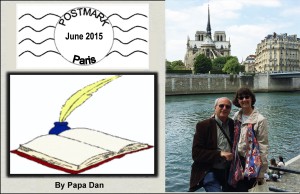 Paris (again and still) — Sitting thirty-some thousand feet above the Atlantic, on our way back from our visit to Varenna, Provence, Paris, and London with a glass of French wine in one hand and a fountain pen in the other, I’m considering what might be worth writing about. As always, one of our goals on this trip was to follow Rick Steves’ advice and become what he calls “a temporary local.” Not sure we did that –it’s hard to do that in a short time. But, I do think we met another goal in the ten days we spent in France: I had hoped once again to imitate one of the most enduring characters of French culture — a character held in admiration for centuries as the personification of all things French. The French have a name for this character: they call him le Flaneur.
Paris (again and still) — Sitting thirty-some thousand feet above the Atlantic, on our way back from our visit to Varenna, Provence, Paris, and London with a glass of French wine in one hand and a fountain pen in the other, I’m considering what might be worth writing about. As always, one of our goals on this trip was to follow Rick Steves’ advice and become what he calls “a temporary local.” Not sure we did that –it’s hard to do that in a short time. But, I do think we met another goal in the ten days we spent in France: I had hoped once again to imitate one of the most enduring characters of French culture — a character held in admiration for centuries as the personification of all things French. The French have a name for this character: they call him le Flaneur.
Le Flaneur has been a literary type since Charlies Baudelaire made this character famous in his poetry in the 1860s. Le Grand Dictionaire Universal in 1872 described Le Flaneur with equal parts curiosity and laziness, an artist-poet of the boulevards, parks, and cafés of Paris; “the closest thing to a sovereign the French should ever have,” he claimed. So, that’s the experience we wanted to have. For at least part of our time in France, I’d like to take a shot at being a Flaneur. So, who is he?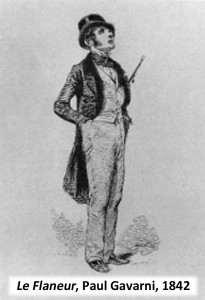
According to a long tradition of French writers, Le Flaneur is the perfect urban spectator, Baudelaire’s “gentleman stroller of the city streets,” engaged in the act of flanerié: aimless strolling, wandering to nowhere in particular, observing everything that presents itself, savoring the multiple flavors of the city. So passionate is his strolling that the act of flané has been described as “the opposite of doing nothing.” In short — it is the act of artfully, passionately getting lost on purpose.
You may ask — what kind of silly goal is that for an American with an Italian name? With all the beautiful and historic sights you can see in Paris, or in the wine-country of southern France, isn’t it sensible to use all of the tools at our disposal to make a schedule, get directions, and make sure we don’t miss a thing in the limited time we have? Well, you’re right – and we’ve done that before. In our first visit to France (Paris and Bourgogne in 2006), we tried to “cover” a lot of the touristy things — le Louvre, le Tour Eifel, le Jardin de Luxembourg, le Museé d’Orsay, Versailles, a boat ride down the Seine . . . But having done that, we set out this time, as we did during our visit to Paris and Giverney in 2012, explicitly to have an experience that doesn’t require (or even allow) a map. So, how does the traveler reconcile the goal of flanerié with the stream of guidebooks and websites full of maps and lists of “must see” things and places, all described with careful instructions on when to go there, how to get there, and what to do when you get there? Well, I’d like to describe a handful of small flanerié experiences we had, quite by accident, during our visits in Paris.
The Madmen of the Island: Le Fous de l’Ille
In 2012, we had the privilege of staying in Paris for nine days. That afforded us the luxury of walking out of our hotel on Rue Saint Louis en I’lle, stopping on the sidewalk, and taking some time to consider the first big decision of the day – should we turn left and cross the bridge toward I’lle de Cité or turn right toward unexplored territory. It seemed kind of obvious that turning left made the most sense. Turning left across the bridge would take us to Notre Dame cathedral. Sometimes there are musicians on the bridge. There is a beautiful park surrounding the cathedral where groups of artists often display their work. Sometimes there are interesting little boats floating down the Seine. And, of course, a couple of doors up from the bridge was the famous ice cream shop le Bertillon – and even though we had just finished breakfast, that would certainly be worthy of my attention.
So, we turned right.
Up the street from our Hotel de la Lutéce, there were a couple of souvenir shops, a French restaurant called Le Med, another hotel, some clothing stores, and some hidden treasures. Even though this is a crowded, narrow street, it hides some cavernous courtyards hidden behind some innocuous doorways –like this one:
[Click to get a look inside (after it loads). Private_entrance]
We may have gotten turned around, so to catch our bearings, we decided to turn left toward the river. (OK, on this little island every direction is ‘toward the river’). So, not having a destination, we drifted past an antique store. It was not especially noteworthy except that it had a graceful little perfume bottle in the window that got Gretta’s attention. Nothing else in the shop seemed particularly remarkable; so we moved on. Another block and we reached the river, turned right (why not?), and wandered past some ordinary-looking buildings. Then it got interesting. We passed a small bistro called Le Fous de L’Ille (translation: the Madmen of the Island). I looked in the window. It looked familiar. To my surprise, the interior layout was the same as the bistro in San Francisco owned by two of our sons – Ben and Will Sapone. It’s called The Flying Pig Bistro, in the Mission District. Very much the same:
- central front door between two large windows,
- alcoves behind the windows with barstools,
- inside, the bar down the left side,
- tables down the right side,
- art and interesting objects on display on the walls,
- kitchen in the back,
- turns out to have a reputation for good food and drink, and friendly service,
- This one has a “rooster” theme, ours back home has a “pig” theme.
Left: Flying Pig, 433 South Van Ness, San Francisco;
Right: Le Fous de L’Ille: 33, rue des Deux-Ponts, Paris
 After the amazement wore off, we decided to find our way back to our hotel (or at least to Bertillon’s ice cream store). Gretta said, “What are the chances we could find that antique store? That perfume bottle is calling to me.” So, after a few rights and lefts, we found it and Gretta became the proud owner of a treasure that resides in our home today.
After the amazement wore off, we decided to find our way back to our hotel (or at least to Bertillon’s ice cream store). Gretta said, “What are the chances we could find that antique store? That perfume bottle is calling to me.” So, after a few rights and lefts, we found it and Gretta became the proud owner of a treasure that resides in our home today.
Le Flaneur Goes Left
The next day, walking out of our hotel after breakfast, we confronted the same critical decision – left or right? Today it’s left. Crossing the bridge to I’lle de Cité, there were still no musicians (a story for later). As the windows of Notre Dame cathedral sparkled in the morning sun, Gretta observed “We’ve seen the outside of the cathedral many times, but never the inside. What do you think?” So, we crossed the playground, passed a student group rehearsing a dance performance of some kind, circled around to the front of the church, and stopped at the sight of something we hadn’t quite seen before.
We had seen security guards around major monuments in Europe, but this was different. Three soldiers – not security guards, but fully uniformed, flak-vested, and heavily armed members of the French military – were walking purposefully across the courtyard in front of the church, scrutinizing the hundreds of tourists standing in line to go through the metal detectors. These two held automatic weapons ‘at the ready’ with fingers on the trigger. The third soldier stood at a distance in the same pose, appearing to be watching out for the other two. We had heard that security had been upgraded in Paris since the Charlie Hebdo terrorist attack and other deadly incidents, but for some reason this felt like ‘more’ than I expected. We sat on a bench and watched as two more soldiers turned the corner along the back of the cathedral. “They are serious. This is real.” We talked for a few minutes whether their presence made us feel safer or more at risk. I admit to a bit of sadness at the sight of them. I fully understood and appreciated their presence; but the scene felt more threatening than I had expected. We speculated that this was only the ‘presence’ we could see. There was undoubtedly more that we could not see. We have to arm ourselves this well to feel safe, even here at one of the more serene locations in Europe. Even le Flaneur acknowledges this truth in his observations. After hesitating awhile, we joined the others and entered the cathedral. A beautiful spot, inside and out. Apparently, well protected. Le duex Flaneurs take a taxi – to the Touleries where the afternoon calm and a Provençal Rosé took over.
[Click the link here —> Gretta_cheers_Paris (after it loads)]
Not All Taxis Are Alike
After a glass of rosé and a plate of frites, it’s time to go back “home” to our hotel le la Lutéce. Too far to walk. So the gentleman in the sidewalk, trained to sense when le Flaneur Americane needs a ride, said as we walked by, “Where you headed?”
“Rue de I’lle de Saint Louis,” I said in my best French accent.
“Twenty-five euro.”
After a few seconds of hesitation, he negotiated, “Twenty?”
“Twenty-five if the ride is smooth.” (As you can tell, I’m a tough negotiator.)
[Click on the two links below to take a ride with us – it may take a minute to load.]
A Musician on the Bridge
The bike taxi dropped us off on the Cité side of the bridge. In previous visits to Paris, this bridge had provided a venue for accordion players, saxophone players, trios, and quartets. Today, as we crossed to ‘our’ side of the bridge, we watched two policemen remove a guy who had set up what appeared to be a puppet show on the bridge and gesture to an accordion player that he needed to ‘move along.’ We watched as the policemen walked away, down the street beside the river, and finally out of sight. When they were gone, I greeted the accordion player and gestured toward the policemen and asked “Pourquoi?” “Three time they confiscate my accordion.” He shrugged, looked where they had gone, and brought his instrument into playing position. I handed him ten euro and he began playing. He smiled while he played, but every half-minute or so, he looked over his shoulder, apparently to see if the policemen had returned.
 [Click on the link below for a few seconds of his music — it takes a minute to load]
[Click on the link below for a few seconds of his music — it takes a minute to load]
—> Our Musician_on the bridge,_looking
Later that afternoon, we asked why we hadn’t seen many musicians and a waiter at the sidewalk café at ‘our’ end of the bridge he told us “Paris now has laws against asking for money on the bridge.”
Oooooooops.
Finally: Two Lovers In Paris Tell Their Story
One day we wandered to a shady spot overlooking the Jardin de Luxembourg and found a spot with a grand view. Gretta was drawing the scene of Parisians enjoying one of their unique spots of shared public beauty and I was sitting with my notebook and my fountain pen, trying to look like a writer. An older couple walked up and leaned on the stone wall in front of us and we struck up a conversation. They showed an interest in what we were doing. “Gretta paints with watercolors,” I said, stating the obvious.
“And you are a writer?” she asked, pointing at my notebook.
“Oui,” I grinned.
In reply, she said, “Let me tell you a story.” Sensing an opportunity, I pushed the video record button on my iPhone, surreptitiously, I thought.
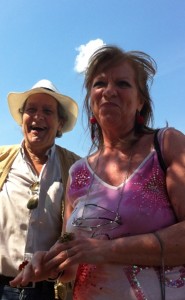 Turns out that they had met a very long time ago as teenagers at a dance, fell in love, but went the two separate ways that life took them — he to the army and a town near Rome, she to marriage and children 600 kilometers away. Decades later, now a widow, she told the story “of my first big love” to her grown son who suggested that she look him up on Facebook. She did. He immediately flew to Italy, and after much back and forth, now, here they are, in Paris together, where they belong. As she told her story, the gentleman and I exchanged glances at each other and at my iPhone and he nodded approval. When she was done, I gestured to the phone and said, “With your permission, I have been …” She interrupted, “Yes, I noticed. It’s a good story. Perhaps you’ll write it down.” We bid each other good day and they were off.
Turns out that they had met a very long time ago as teenagers at a dance, fell in love, but went the two separate ways that life took them — he to the army and a town near Rome, she to marriage and children 600 kilometers away. Decades later, now a widow, she told the story “of my first big love” to her grown son who suggested that she look him up on Facebook. She did. He immediately flew to Italy, and after much back and forth, now, here they are, in Paris together, where they belong. As she told her story, the gentleman and I exchanged glances at each other and at my iPhone and he nodded approval. When she was done, I gestured to the phone and said, “With your permission, I have been …” She interrupted, “Yes, I noticed. It’s a good story. Perhaps you’ll write it down.” We bid each other good day and they were off.
A good story.
[Download and watch Julietta tell her full (5 minute) story, told in her own words at the end of the file below, along with the rest of this post.]
Le_Flaneur_July4_2015_Complete
—–> The flaneur’s lesson:
There are things you will miss if you know where you’re going.
Varenna, 2015: We’re Back — This Time It’s Different
Varenna, Lago di Como, Lombardia, Italia —
 American Airlines brought us to New York, where we stayed overnight. Then — back on the plane to Milan. This is our sixth visit to Varenna, but this time it is different. This time Gretta and I have two old friends with us, Lew and Rita Bell — well, uh, I hope they will pardon the expression “old friends” . . . it’s not that they are old, not exactly, I mean, same age as me, you know, we’ve been friends for a long time, through a lot, you know: Old Friends, right? The point is that on this return to Varenna, they were with us and, borrowing a line from Robert Frost, “that has made all the difference.”
American Airlines brought us to New York, where we stayed overnight. Then — back on the plane to Milan. This is our sixth visit to Varenna, but this time it is different. This time Gretta and I have two old friends with us, Lew and Rita Bell — well, uh, I hope they will pardon the expression “old friends” . . . it’s not that they are old, not exactly, I mean, same age as me, you know, we’ve been friends for a long time, through a lot, you know: Old Friends, right? The point is that on this return to Varenna, they were with us and, borrowing a line from Robert Frost, “that has made all the difference.”
[Click on the image to get better look.]
I met Lew in the dorm at Santa Clara University back before . . . well . . . back before Richard Nixon was elected to a career of making “one thing perfectly clear,” almost a full year before Woodstock and Abbey Road, and before I had any idea what it might mean to have a ‘brother.’ Gretta and I had been telling Lew and Rita about this tiny village we keep visiting on Lake Como in northern Italy since our first visit in 2001. Finally, they decided that they needed to go with us, perhaps to verify that we had not been exaggerating the sweetness of this place (take a look at “The Sweetness of Doing Nothing — Il Dolce Far Niente” at: https://convivio-online.net/?p=271).
So, that was that. They were going with us. We are thrilled that we made it so.
After landing at Malpensa International Airport, we took the usual 63-minute train ride from Milano Centrale train station to Varenna/Esina/Perledo station. That is usually an easy process, but this time Milano Centrale was quite a bit more of a complication than usual. With so many people (millions, they say) in town for the World Expo here in Milan, it took some effort to board the train even with our advance-purchased tickets. But, once we got on board, the view of the Italian countryside along the way was as delightful as ever; so we’re not complaining. Once in Varenna, Albergo Milano, our ‘home’ in Varenna, is only a few minutes from the train station (OK, so is everything else in Varenna) and, as we approached our little ‘street,’ just a narrow stone alleyway (pictured here), everything seems to be just as we left it. The ‘streets’ that are parallel with the lakefront are alleyways like the one on the left. The ‘streets’ perpendicular to the lake are stone stairways, like the one on the right
After a rest, it was time to achieve our first major goal: dinner at Egidio’s La Vista restaurant at our usual dinner table on our own terrace at Albergo Milano. The food and the wine? Well, Egidio’s kitchen is still terrific.
As is typical in this part of Italy, the dinner table is yours all night, so we enjoyed the evening mist, a spectacular sunset, and the sounds of music as the stars came out. Click on the link below for a few seconds of Dinner_at_LaVista. 
The following night, just about twenty yards down our ‘street,’ we found another sweet dinner table at Borgovino. They put us ‘out in the street,’ eh? (Do I detect a bottle of French Rosé from Provence on the dinner table? Shhhhh!
Villa Monastero
Of the many beautiful places here around what they call ‘mid-lake,’ we also spent an afternoon wandering the length of Villa Monastero, along the southern edge of Varenna. Here are a couple of images (that’s Lew at the top of the ancient stone stairs).
Moreno’s Cooking Class at Il Caminetto
Gretta and Rita spent an afternoon at Moreno’s cooking class up the hill at his restaurant. Il Caminetto is located on a winding one-lane road up the hill behind Varenna. They drive to Varenna’s town square to pick up their guests, because they don’t trust tourists to negotiate this road successfully (once you get on this road you can see why this is a wise decision). Moreno taught them everything one needs to know about tortellini.
 Click to hear a bit of Moreno’s Lesson about the history of Italian noodles (warning: it’s shocking).
Click to hear a bit of Moreno’s Lesson about the history of Italian noodles (warning: it’s shocking).
Rita, already a storied chef,
tries her hand at making tortellini.
And click here for a bit of Rita video:
Rita makes tortellini
And the product:
And, of course, Bellagio
The original Bellagio (not the fake one in Las Vegas) — just a fifteen-minute ferry ride across the water.
Lew & Rita (left) at lunch outdoors at Albergo Firenze in Bellagio; Gretta (right) expressing surprise at having wine from southern France (our next stop) here in Italy.
So, after five days, we say goodbye to Varenna and board a high-speed train to Antibes on the French Riviera. Our next installment of ConVivio will come from southern France.
See you there.
![]() Click to download a PDF of this post: Return_to_Varenna_ConVivio
Click to download a PDF of this post: Return_to_Varenna_ConVivio
A Morning Conversation
It felt like the start of a workday like any other. The look and feel of my office and my desk were familiar and unmistakable. My ‘to do’ list was the usual combination of two or three quick and easy tasks, one or two difficult but do-able ones, and a handful of things that I was probably never going to get done so would still be on my list later in the week. I could still feel the optimism associated with the first hour of the day, when the phone rang.
= = = = = = =
The screen on my phone showed an area code I didn’t recognize. “Hello, this is Dan.”
“Mr. Sapone, I apologize for calling you at work, but Linked-In only showed your workplace and your switchboard operator was kind enough to put me through. My name is Aaron Sorkin. An acquaintance of mine sent me a link to a story you posted on your blog. It’s the one-act play called “Some Explaining to Do.” I was hoping to have an opportunity to talk to you about it.”
It took a long moment for all that to sink in. I understood the words all right, but it all took awhile to make sense and the voice sounded a bit distant. My mind quickly went from ‘Wow’ to ‘Ah-come-on-now,’ to ‘What is this?’ Words did eventually come out of me. I said, “OK, this is a good joke but . . . I, uh, yes I do have a blog, and . . . look, several people know how much I admire your work, well, that is, Aaron Sorkin’s work, well enough to play this trick on me — but forgive me, I don’t mean to be rude, but I have no way of knowing that you are who you say you are and I have a hard time believing that Aaron Sorkin would be calling me.”
“So you know my work?” he said.
“Of course, you . . uh, Aaron Sorkin that is, has produced and written some of the best television I have ever seen. I mean, if I had to rank all-time TV shows, well, at the top of the list there’s “The Newsroom” and then “The West Wing” and way down below that there’s everything else I’ve ever seen in my life. So, who is this really?”
“Well, Mr. Sapone, I appreciate the kind words, but I happen to be acquainted with your Poet Laureate there in Pleasanton from a writing conference she invited me to on the West Coast. You can call her and she’ll confirm that, if you like. She sent me the link to your story on your blog ConVivio, and it got my attention. It really stands out from the rest of your . . . I mean the other pieces on your blog are, well, they’re fine if a bit obvious and, I wouldn’t exactly call them trite, but well, look, I really didn’t call to insult you; but I liked the one-act play very much. It had some of the qualities I admire in American short fiction, you know, it revealed the character quickly with your dialogue, it got to some serious issues with a little humor without hitting me over the head, and it happens to be on a theme I am interested in. And starting with ‘Act One’ and ending with ‘Intermission,’ it made me want more. I mean I can really imagine that there are some interesting places to go with an Act Two and an Act Three . . . . .”
“Dan, are you still there?”
“Yes, so you’re telling me that you’re really Aaron Sorkin? Really.”
“Yes, sir, as awkwardly as I’ve introduced myself, yes, I am. Listen, I am coming out to San Francisco next month and I’d like to talk to you more about your play. For example, do you have plans to extend it? You sort of imply that you have more in your back pocket. I mean, what happens to your main character when he goes back to Earth, presumably in Act Two? And then, does he come back up there in Act Three, as you imply? And who is the voice behind the door? Does he do the ‘explaining’ that you suggest he must? I actually want to hear what he might have to say.”
I’m still finding all this hard to believe — “Well, sir, to be honest, I do have a plan for Acts Two and Three but they haven’t quite made it onto the paper, if you know what I mean.”
“Yes, Dan, I do know what you mean. It took me awhile to figure out that the whole Newsroom story was really about Charlie Skinner, not so much Will and Mackensie. I mean ‘’that’s how I got to Memphis,’ if you know what I mean.”
“Yes, I get it. I saw the final episode. And I do have answers to your questions about my main character, but . . . why exactly are you interested in my little story? I mean, you can write circles around me and what could you possibly want with my little 1500-word play?”
“Well, Dan, I am kinda between projects right now, what with ‘The Newsroom’ series all over, I’ve been wanting to do a movie and, your story got my attention. I can imagine . . .”
An annoying buzzing sound interrupts him in the background.
“Oh, excuse me, Dan . . . my other line . . . oh, I’ve got to take this, I’m really sorry. Look, can I call you back? I’ll get back to you — perhaps this afternoon — I’d like to talk some more.”
I heard a click, but the buzzing didn’t stop.
Oh, right. I suppose my alarm clock had been buzzing for a while. Of course . . . time to get up.
Download a PDF of this post: A_Call_from_Sorkin
The Saxophone Guy: Where Does It Come From?
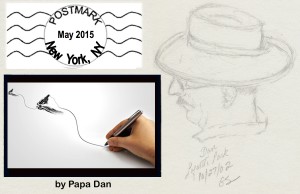 We hear evidence of him long before we see him. The long meandering notes from his saxophone alternately sprayed . . . poured . . . erupted . . . oozed . . . out of his horn in a dazzling array of colors that originated in his mind, from under his hat — a gift to anyone who happened by to hear it. But, where does it all come from?
We hear evidence of him long before we see him. The long meandering notes from his saxophone alternately sprayed . . . poured . . . erupted . . . oozed . . . out of his horn in a dazzling array of colors that originated in his mind, from under his hat — a gift to anyone who happened by to hear it. But, where does it all come from?
= = = = = = =
So, Gretta had been painting with watercolors for years and I wanted to try. Looks interesting. Gotta start with a drawing . . . saw a picture of a saxophone guy somewhere. . . figured maybe I could draw it . . . maybe. Grabbed a big piece of paper and a pencil.
Now what?
First observation: where do I start? In writing, one might just begin at the beginning — certainly at the top of the page. But this is different. Where on the blank piece of paper do I place the pencil first? Should I start with what he’s sitting on? Should I draw the guy first? And the bigger question: what do you do when you have no skill, no training, no experience?
OK, right, start with the hat.
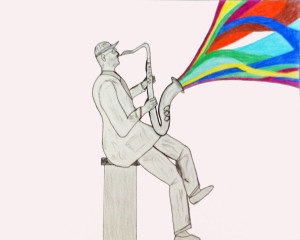 Second observation: the eraser turns out to be more important than I realized, just as useful a tool as the pencil — in my case, perhaps more useful.
Second observation: the eraser turns out to be more important than I realized, just as useful a tool as the pencil — in my case, perhaps more useful.
The shape of the jacket seems to define the guy. Pants. Spend some time on the head and face. What is he thinking? (And, if I knew, how would I show that? It’s just an outline really, after all that erasing.) Are the proportions right? I suppose. So, his clothing will have shadows, wrinkles, folds, contours, bits of shading. And shoes. What kind of shoes? Then, of course, the instrument itself has lots of curves and small features (a trumpet would have been easier). Maybe it doesn’t need so much detail.
Time to stop and take a hard look. Have I captured, or hinted at, his concentration; have I implied that he was lost in his music, enthralled by it, maybe with his eyes closed. Fingers! Have you ever tried to draw fingers? Fingers are harder than they seem. Way harder!
Take another look. OK, I’ve got a guy and a saxophone. Not too bad, I mean, you know, mostly.
Third observation: So, what’s happening in my picture? It’s just shades of gray; but now for the hard part. How do I represent the music? What does music look like? Does it change the scene? Is there a relationship between the surroundings, the way the guy looks, and the kind of music? Does the music just happen? Where does it come from?
As the artist (well, the guy with the pencil), it might be worth asking where does the drawing come from? Why am I drawing this guy? Is there something about the saxophone that appeals to me? What is it about him that got my attention? Where is he sitting? Is he on a stage? In a coffee shop? On a park bench? On a stoop in his neighborhood? Are people listening? If they are, how does it affect them? Have they chosen to sit and listen to his music or has he interrupted the quiet of their public space? I guess I’ll think about the foreground and background later.
Time for some speculation. Maybe it didn’t used to be this quiet when it was an ‘actual working-class neighborhood’ a couple of years ago, before the bottom fell out of everything. There may have been dozens of people going to and from work at several small businesses around the corner and a block over; and there haven’t been many cars on Hauser Street since the drugstore moved uptown, the grocery went out of business, and the upholstery shop closed. Not many of the garages on this block have cars in them these days; so there isn’t much traffic to interfere with the music.
Maybe he selected this spot a few months ago — as an exercise in calmness — because the configuration of these two-story wood-frame houses created a natural sound stage here in the middle of the block where the notes bounced back to him, amplifying individual notes into a more full, more dignified sound. When he closed his eyes, could he imagine a concert hall full of silent listeners enjoying the subtle combination of minor keys and alternating rhythms he was so proud of. It had been awhile since anyone actually listened to his music; so his imagination provided his only appreciative audience.
Actually, when he first selected this spot, I suppose the only audience responses he got were the “can’t you take that somewhere else?” and “Oh, no, not again” blurts from the near neighbors. But, even that reaction seems to have died away as locals stopped expecting to have any control, or even influence over their surroundings.
 His own third-floor walk-up at the corner of 14th is comfortable, if small, with a street-side window that looks out on a billboard advertising a mini-storage company. “Raising a baby in an NYC apartment is like growing an oak tree in a thimble,” it said. He still thinks of the sign as an expression of optimism; but he doesn’t notice it much lately. Three days a week he takes the bus to his job at the Laughing Cavalier where he waits tables and washes dishes. It was a bit of a shock when his hours were reduced from full time, but he learned to make do without a car; and he was amazed how much it cut his expenses. It turned out to be a decent trade-off, for now, at least.
His own third-floor walk-up at the corner of 14th is comfortable, if small, with a street-side window that looks out on a billboard advertising a mini-storage company. “Raising a baby in an NYC apartment is like growing an oak tree in a thimble,” it said. He still thinks of the sign as an expression of optimism; but he doesn’t notice it much lately. Three days a week he takes the bus to his job at the Laughing Cavalier where he waits tables and washes dishes. It was a bit of a shock when his hours were reduced from full time, but he learned to make do without a car; and he was amazed how much it cut his expenses. It turned out to be a decent trade-off, for now, at least.
Two days a week he looks at the job ads on the bulletin board at the laundromat; but that doesn’t take more than a few minutes. The newspaper says that an ‘economic recovery’ has started to show itself across the country; but he’s not sure what that is supposed to look like in his neighborhood. He typically gets to his ‘spot’ by about ten and the music begins. He plays mostly songs made-up on the spot — not so much ‘songs,’ really, as attempts to reconstruct the sounds he remembered from the days when his Dad played ‘smooth jazz’ from Pandora back when he had an iPhone. But the days of free Internet ‘Aps’ are gone. Advertising revenues that used to pay for the ‘free Internet’ are not as lucrative today as they were back in the 2020s, now that retail sales are so weak. The old notion that name recognition from website advertising contributed significantly to consumer purchasing has been all but abandoned by this time. While the commercial sector was looking for another business model to reinvigorate the value of the Internet, the consumer economy was in temporary free fall. Surely it was ‘temporary.’ Optimists believed that another innovative business model was ‘just around the corner’ and would come to the rescue as it had done back in the 20th century and early in this one. But, in the mean time, most of what used to be the middle class was just trying to survive in this new world of lowered expectations.
Our saxophone guy, while not so much an optimist, was trying to survive with his part-time job and afternoons with his music. He didn’t think much these days that he was waiting for better times to start; his is a simpler goal – just trying to find enjoyment in hearing his own music bounce back to him on this quiet street. It wasn’t so bad as long as he didn’t think much beyond the present moment. When he was a kid, he had been taught that “living in the present” was an important ‘spiritual’ value to pursue. But now, in his late twenties, it was pretty much the only practical choice for the moment.
And me, the guy with the pencil? What have I learned? I learned that our Saxophone Guy makes the music look easy even if it isn’t, and for me, drawing the picture is harder than it looks.
Download a PDF of this post: Saxophone_Guy_ConVivio_May2015
Guest Poet: Lauren de Vore, National Poetry Month 2015 Continues . . .
 Well, this is a completely new experience for me, a coming out of my poet’s closet so to speak. After spending my working years as a science writer/technical editor, it’s a real treat now to spend time writing what I want to write! To my surprise, I find myself writing poetry.
Well, this is a completely new experience for me, a coming out of my poet’s closet so to speak. After spending my working years as a science writer/technical editor, it’s a real treat now to spend time writing what I want to write! To my surprise, I find myself writing poetry.
I’ve always loved the sound and rhythm of words, and some of my earliest memories are of being read to—fairy tales, classic children’s stories, and poems, lots and lots of poems. Remember “Lines on the Antiquity of Microbes” (subtitled “Fleas” by Strickland Gillilan): “Adam/Had ‘em.”, reputedly the shortest poem ever published? Or how about the hypnotic verses of Robert Service: “There are strange things done in the midnight sun by the men who moil for gold…”?
As I found pleasure in the writing of the following poems, I hope you find pleasure reading them.
==================== Click here for a PDF of this post: ConVivio Guest Post ldv r2
Like Dan, I love Yosemite. As spectacular as spring and early summer can be, fall is actually my favorite time there; the days are still warm but the nights are crisp and, with the crowds gone, the valley is quietly settling down for the winter. Regardless of season, there is something spiritual about the place. I wrote the following poem last June after an early morning walk.
Morning Walk
Lauren de Vore (July 3, 2014)
I rose at dawn one summer morn
Something was calling me
A gift to see the day new born
Here in Yosemite
The forest duff held yestreen’s heat
Meadow grass bowed with dew
I watched the silent stars retreat
Dark eased its sable hue
With reverence I inhaled deep
All was hushed, nothing stirred
So perfect, pure that I could weep
Silver song of first bird
Such sanctity in every rock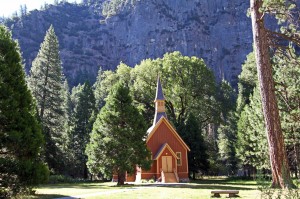
Waterfall river pool
All mysteries reveal, unlock
Here in God’s vestibule
I walked till gray gave way to light
Granite in bas-relief
A simple chapel met my sight
Edifice for belief
Seems strange that midst this majesty
Man constructs walls and roof
In searching for divinity
Indoors he turns for proof
Perhaps too much to face full-blazed
Unfiltered gaze of God
Within a structure man has raised
There finds it safe to laud
A gentle breeze whispered my way
Gratia domini
Whate’er the day it’s Sabbath day
Here in Yosemite
===================
I’ve long been a fan of Walt Whitman, even before I went to Whitman College. And no, the college was not named for the poet but for a missionary, Marcus Whitman, who in settling the Walla Walla valley managed to wipe out most of the native inhabitants with a measles epidemic; the understandably irate survivors then massacred Marcus and his settlers. History lesson aside, do you remember Apple’s commercial for last year’s Superbowl, “…the powerful play goes on, and you may contribute a verse.”? That’s a line from the poem “O Me! O Life!” (http://www.poetryfoundation.org/poem/182088) in Whitman’s “Leaves of Grass.”
My verse is below. I think everyone, at some point or another, contemplates legacy. Very few of us have the opportunity, talent and/or fortitude to make a difference in the grand scheme of things. But on the smaller, more human scale…
My Verse
Lauren de Vore (Feb 27, 2014)
My verse, Mr. Whitman,
Is but a small verse, a simple verse,
One of quiet striving to find a place to fit in,
A way to leave the world better, if only a bit, than before.
I have asked the larger questions but only lightly,
For I am one more inclined to nurture dragons than slay them;
I have loved well but without grand passion,
For I am better suited to live on the plains, in the lea not the face of the storm;
I have shed tears over the struggle and injustice,
But cried also over the beauty and sheer joy of it all.
Many are the times I should have done, could have done,
But more are the times I did.
And so, mine is a simple verse—a son, a handful of friends,
A smattering of follies and kindnesses, of ordinary tragedies and triumphs.
I have not shaken the earth for good or ill,
But I have lived. I am here.
====================
Since we’re recognizing National Poetry Month, here are several poems about words, poets and poetry. There’s a lot of verbiage about poetry being transcendent, sublime, profound, etc. I’m always a bit put off by these superlatives. Some poetry is indeed extraordinary and inspiring, and I suspect many poets have ambitions toward that end. But such characterizations can make poetry seem intimidating and set it beyond the ken and interest of ordinary writers and readers. It’s important to remember that poetry is also fun, and that less-than profound poems are every bit as valuable, and often more enjoyable, than the critically acclaimed “greats.”
====================
This is my little rebuttal to literary critics who extol poetry in highfalutin terms and to poets who cultivate the abstruse in an attempt to be profound. As an aside, I’m very fond of sonnets. I like the challenge of working within the constraints of the sonnet’s structure, meter and rhyme—specifically, 14 lines consisting of three quatrains and a concluding couplet in iambic pentameter with an ABAB or ABBA rhyming scheme. (If you’ve ever taken a music theory class, writing a sonnet is similar to being presented with the melody line and figured bass for a Bach chorale and working to fill in the other three parts. And then, of course, comes the lesson in humility when, after hours of struggle on your own composition, Bach’s version is revealed! The same thing happens when I read Shakespeare’s sonnets.)
Thoughts Profound
Lauren de Vore (Apr. 10, 2014)
The poet’s task can be formidable
For if one’s aim is poetry profound,
One must, as precedent, think thoughts profound
(Though not completely inexplicable).
But if a thought seems deep or sage to me,
I wonder is it so? Perhaps it’s just
My ignorance, something that’s been discussed
And shelved long since by those more scholarly.
But then I think, ne’er mind those dusty tomes,
Th’idea’s new to me. And so I pense
The thoughts and images as they make sense
To me, and in the process pen my poems.
I think it matters not what’s deemed profound,
But that one thinks and ventures to expound.
====================
Standing in the shower, hot water streaming over my shoulders, is often a creative time for me. Possibilities for new poems emerge, solutions to difficulties with in-progress poems arise. But then, dripping wet, I have to quickly find something to scribble on before the ideas evaporate with the steam!
Musing
Lauren de Vore (Feb. 19, 2014)
Why is it that when inspiration strikes,
I’m always in the shower or in bed
Near sleep with naught to write upon to catch
Those fleeting sparks of wit, those crystal drops
Of insight evanescent in the light
Of day? Perhaps there is some muse who likes
To tease, to pendulate a slender thread
Of perfect prose or rhyme sublime, then snatch
It back while laughing from the mountaintops.
Yet if these tricks amuse the muse, no spite
I’ll hold, for any hint poetic psyches
Me up and sets thoughts spinning in my head.
Come morn, with pen in hand I’ll chicken-scratch
Till phrases coalesce in starts and stops,
Like smoke rings that shine brightly then take flight.
And though I might prefer some clearer spikes
Of inspiration, mileage posts instead
Of traces drawn by bits of straw and thatch,
I welcome any literary sops
That come my way. For I know when the right
Words finally align in proper queues,
The poem belongs to me and not the muse.
====================
Words are like people. Some are practical and purposeful. Some are demanding and ambitious or exuberant and frivolous. Others are somber and melancholy or perhaps persnickety and precise. And playing with them is just plain fun.
Old Friends
Lauren de Vore (June 14, 2014)
One of the nicest things now I have time to write
Is chance to reacquaint myself with long-lost friends.
In searching for the perfect phrase or rhyme just right
As thought in prose or poem sinuously wends
Its way from brain to page, I’ve happened on a host
Of lovely words I met, oh, years ago, but long
Forgot midst press of workday life. So here’s a toast
To all the vocables that make a language song,
An art, a mental exercise, a game of tones.
Some are celebrities, imposing cynosures
That daunt for fear their inept use engender groans.
Others inveigle as they dangle sapid lures
To those who strive to find t’exact mot juste
As anodyne for verbal hebetude. The twee
And chary, risible and coy’ve returned to roost
Within my newly ‘larged vocabulology,
And in their company I’ve wambled far and wide
Through literary dingle, kloof and weald. Although
At times I balter in their syllables, beside
Their usual kith and kin they’re far more apropos
And much more fun to know. And so I set myself
The goal each day to use at least one quirky word
That else would molder on some dusty reference shelf.
Eyebrows may rise and people think me most absurd,
But words unused are eas’ly lost, and in their loss
Is language dimmed, for words are more than letters in
A row but filled with meme and meaning stretched across
The years. When words are lost, the concepts held within
Are also lost and soon or late th’ability
To think those thoughts recedes beyond recall. And so
My game of tones is more than vain legerity
But quest to save the tools we need to think and know
And understand. And after all, these words are friends,
And friendship true perdures despite mere fads and trends.
====================
I was always the nerdy kid, the one with glasses and braces who actually liked school and read poetry even when it wasn’t assigned. In fact, one of my favorite poems was (and still is) Robert Browning’s “The Bishop Orders his Tomb at Saint Praxed’s Church” (http://www.poetryfoundation.org/poem/173002). On a recent rereading, it struck me how much one’s enjoyment of such poems depends on knowledge of the “cultural literacy” of the era in which the poem was written. The verse below attempts to reflect on this realization.
A Poet’s Admonition
Lauren de Vore (Dec. 6, 2013)
A passing survey of lauded poets of yore
Reveals what may be a vexing predicament
For would-be bards of today, for tis evident
That the sonnets and odes English teachers adore
Are brimming with analogies from history,
Legend and myth. These allusionary subjects,
While once in common grasp, now baffle and perplex
All but the super-erudite and scholarly.
For who today knows ‘nough of Ozymandias
Or Cuchulain or Lochinvar to apprehend
The poet’s nuance? Be they villain or godsend,
Their deeds are lost to time, their names are powerless.
Thus must the twenty-first-century poet ask,
What is the current coin of history and myth,
The people and places that will register with
Readers today and in years to come? Quite a task
To choose amongst Lincoln, Mandela, or Gandhi,
‘Twixt Birkenau and Abu Ghraib. And which of these,
If any, will have meaning in the centuries
Ahead when poet too is part of history?
No matter how important now, most everyone
And every deed will likely be forgot in time
As memory must pick and choose which are sublime
And worth remembering, the rest to jettison.
Perhaps this is the poet’s task, to search the dross
And find the diamonds bright, and by the craft transform
Mere mortals into myth.
Mere mortals into myth . Bard choose well, for you form
The future’s view of history, a heavy cross
Indeed to bear. But every age has need of lore,
And hist’ry books though filled with facts are dreary works.
But stories tell with rhythm and with rhyming verse,
And oft the parables evolve to something more.
So poet hone your tales and wisely wield your pen,
For they may well have powers far beyond your ken.
====================
These next two poems started out simply as observations of scenes but evolved into something a bit more.
Big Sur Coast
Lauren de Vore (Feb. 24, 2015)
On high I watch the breakers pound the shore.
With foaming wrath they protest journey’s end,
As if through sound and fury they could rend
The cliffs and force the land to yield before
Their watery might. No restful overlook
This bluff of mine, with naught for company
But screaming gulls and one lone cypress tree.
Though meager shelter ‘gainst the wind, in crook
Of twisted trunk I stand, eyes squinting in
The glare. With every thundering crash I feel
The temper in each surge of liquid steel,
Frustration that the race is run and win
Or lose ‘tis done. Thus so I reckon feels
The river as it empties in the sea,
As well th’explorer trekking westerly
Till dry land ends and squatting on his heels
Curses the ocean now his westering days
Are done. And yet the rivers ever run,
And though the strand is strewn with those who shun
The sea’s untamed expanse, the restless gaze
Beyond the known and venture ever on.
Around the globe, by tempests tossed, by ice
And fire burned, be’t hell or paradise
They tarry not as onwards they are drawn.
And when at last the last frontier’s been breached,
When all the empty lands are overrun,
What of the ones who chase the setting sun,
Now that the questing’s done, the limit’s reached?
I watch the breakers crash upon the shore
Refusing to accept that journeys end.
As daylight fades, down from my bluff I wend
And know the waves will pound forevermore.
====================
I’m convinced that all cats, just before they are born, are sworn to secrecy about all things feline!
Cat
Lauren de Vore (April 15, 2015)
So sleek and elegant, tuxedo-clad, my cat
Sits crouched upon the hearth and stares unblinking at
The dancing flames and glowing coals. What see you there,
Oh cat who deigns to share my bed and meager fare,
Deep in the fire’s heart? Across the eons do
You gaze, when deepest darkest Africa was new,
When mighty beasts, not man, did rule the plains and you
Perhaps the leader of some simban pride? Or do
You see the ancient pyramids when cats were viewed
As gods, were worshipped, idolized, their favors wooed?
Can you tap mem’ries from the days beyond recall?
You’ve prowled the fetid alleys and the king’s great hall
As Black Death carried off both rich and poor. You’ve sailed
Around the world, in countless armies’ van you’ve trailed,
You’ve watched as tempests swirled and battles raged and seen
The course of hist’ry changed. Oh cat of midnight sheen,
The flick’ring flames reflect within your slitted eyes,
Their ever-changing scintillations hypnotize.
Can you not give me just a hint of what you see,
Of all that’s feline, foreign and thus hid from me?
Still as a statue, full of secrets, staring at
The swirling fire, so sits my sleek and silent cat.
====================
Every writer is, I suspect, an avid reader—a good thing too, since where would writers be without readers?
Selfish
Lauren de Vore (Jan. 6, 2014)
My reading time is precious time, my selfish time.
So if you see me with a book, don’t talk to me,
Don’t ask me what I’m doing—reading, duh—or if
It’s good—it is, I wouldn’t read it otherwise.
And if you do, don’t be surprised or captious when
I scowl as I reluctantly reply. And should
You then decide to choose a book or magazine
Yourself to read, please be forewarned that reading’s not
A group activity. Repress, nay kill the urge
To interrupt to ask to read me “just one thing.”
Though I may acquiesce with barely stifled sigh,
The answer’s really “no.” For I am far away
Within the pages of my book—another time,
Another place—and hauling back to here and now
Is maddening beyond belief. Tis selfish, true,
Such solitude to seek and churlish to resent
Its breach. But since I have no secret place in which
To hide away and read, domestic bliss would be
Enhanced by silence till I’ve closed my book and joined
Again the present day and ever-patient spouse.
===================
And finally a little something haiku-ish…
Birdsong in a minor key
Shatters the fragile shell of dawn.
Daybreak.
Many thanks to my husband, Paul Jackson, for the photos. (You should have an exhibit some day!)
— Lauren de Vore
Yosemite: Of Permanence, Change, and a Sense of Wonder
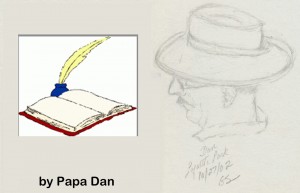 Even (maybe especially) after a few dozen visits to this magical place, a powerful sense of wonder is always present. I am sitting near the back of the Ahwahnee Hotel’s Great Room in Yosemite Valley, accompanied by the family artist (Gretta), a glass of Sonoma County Pinot Noir (from Flowers Winery), and an iPad; my eye drifts up to the gigantic ceiling, built in 1927 and festooned with an Ahwahneechi tapestry, woven deep red, blue, gold, and black, above the six-by-ten-foot fireplace and illuminated by four immense iron candelabra, electrified only in recent decades.
Even (maybe especially) after a few dozen visits to this magical place, a powerful sense of wonder is always present. I am sitting near the back of the Ahwahnee Hotel’s Great Room in Yosemite Valley, accompanied by the family artist (Gretta), a glass of Sonoma County Pinot Noir (from Flowers Winery), and an iPad; my eye drifts up to the gigantic ceiling, built in 1927 and festooned with an Ahwahneechi tapestry, woven deep red, blue, gold, and black, above the six-by-ten-foot fireplace and illuminated by four immense iron candelabra, electrified only in recent decades.
The view from here, positioned behind two thickly covered grand pianos, speaks of enduring elegance, respectfully built on ancient Native American roots, offered here for those who would take their place where presidents, magnates of industry, backpackers, and parents with children on Spring Break have quietly relaxed since before anyone knew there would be either a Great Depression or Great Recession from which to recover. A crew of uniformed servers quietly prepares the afternoon tea-and-cookies service for those who drift in from their day in the woods.
 From recent experience, I know that the grandest of the pianos will be uncovered soon, to be employed with the collaboration of Mozart and others to set a mood that alternates between quiet contemplation and festive revelry. Remarkably for those of us mired in the 21st century, the wood-carved sign at the entrance to this Great Room, reminding those who enter to be on their best behavior, is respected and obeyed, evident in the obviously coached youngsters who speak in hushed (for them) tones as they enjoy surroundings that even they know deserve some respect.
From recent experience, I know that the grandest of the pianos will be uncovered soon, to be employed with the collaboration of Mozart and others to set a mood that alternates between quiet contemplation and festive revelry. Remarkably for those of us mired in the 21st century, the wood-carved sign at the entrance to this Great Room, reminding those who enter to be on their best behavior, is respected and obeyed, evident in the obviously coached youngsters who speak in hushed (for them) tones as they enjoy surroundings that even they know deserve some respect.
Today is a surprise. Yosemite has not been immune to the ravages of California’s four-year-and-counting drought, demonstrated by weaker-than-usual waterfalls, above-average temperatures, and NO recent snowfall. But today, April 5th, is different — today we all woke up to falling snowflakes as big as cottonballs and the low temperatures that Yosemite’s regular visitors had come to expect this time of year. So, the snow clothes and smiling faces began gathering in front of the giant fireplace by mid-afternoon.
Precisely at four, a well-dressed gentleman arrives, wheels in his own particular chair, uncovers the piano, becomes comfortable before the keys, and changes entirely the color and flavor of the giant room, using his own particular brand of concentration, without need of sheet music. Activity in the room, however, does not change — gentlemen wearing baseball caps still relax on colorful sofas, dads in snow clothes still wheel baby strollers into the space in front of the fire, accompanied by moms directing toddlers and school kids to their appointed places to divest themselves of wet clothes, carefully hung to dry on the hearth, revealing the activities of the season — gloves and mittens that had been throwing snowballs, stocking hats that had kept ears warm but not dry, boots that had been crunching across the first (and last?) thick snow of Spring, and snow pants that had been crawling on the snow as the older children rolled big balls of ice to create the torsos of snowmen. The music rises to the rafters, not needing volume to command the attention of the room, but not interrupting the business of families doing what they came here to do.
Chopin makes an appearance, again without benefit of sheet music – the gentleman lost in his own enjoyment — not limiting himself to the first movements of pieces most may recognize, but retelling masterworks in their entirety. The room is now filled with the dual majesty of the music inside and the mountains outside. People from multiple generations, classes, and ethnicities read their books, discuss their topics, sip their teas and wines, draw their pictures, and yes, write their words — all under the watchful eyes of Half Dome and Yosemite Falls, peering in through the high windows on opposite sides of this magnificent room.
The multiple personalities of the Spirit of Yosemite make their presence known, even through those high windows — Half Dome, out one window, stands as a dark chocolate truffle, sprinkled with powdered sugar that someone cut in half to see if it’s the one with a raspberry inside. It’s not, but worth the cut to find out. Out the opposite window, Yosemite Falls, diminished in volume by a drought-ish and warm winter, pours its modest goodness into a splash of mist just visible between tall, straight evergreens and bare, spreading oaks.
 Tchaikovsky appears, as does sheet music for the first time, as a young girl slides up to look over the gentleman’s shoulder at the piano. She steps progressively closer as the music gets more animated, eyes wide, alternately staring at the sheet music and at hands on the keys, all the while bouncing with her hands and arms, revealing some experience of her own at the keyboard. At the end of the piece, he leans back, points at the sheet music, and says to the girl, “Look. It’s not that hard. You could do it.”
Tchaikovsky appears, as does sheet music for the first time, as a young girl slides up to look over the gentleman’s shoulder at the piano. She steps progressively closer as the music gets more animated, eyes wide, alternately staring at the sheet music and at hands on the keys, all the while bouncing with her hands and arms, revealing some experience of her own at the keyboard. At the end of the piece, he leans back, points at the sheet music, and says to the girl, “Look. It’s not that hard. You could do it.”
This is, of course, just a snapshot, a small glimpse in time and space. We can wander from this room to stand before — or even atop — other great natural wonders of our continent: Vernal and Nevada Falls, Mirror Lake, the Merced River, Glacier Point, and rock faces carved by forces we humans cannot duplicate and that we do not live long enough to witness in our collective lifetime on this planet. A snapshot is all we have ever seen; but we continue to imagine the part of the snapshot cropped out of our view, before and after the time and space we occupy.
Why do we come here? Is it for the mountains – appearing larger and more permanent than anything that has surrounded us anywhere else? Or is it the water — to see what it can do when it arrives with power from far above us? Do we come here to be in the presence of creatures — bears and deer, birds and coyote, and their compatriots — not familiar in our neighborhoods back home? Maybe, without realizing, we come to experience the simultaneous work of permanence and change: two illusions who conspire to fool us into thinking we understand the rhythm of this life, only to surprise us by revealing things and ideas hiding in plain sight, that have always been there waiting for us to discover them anew. Are we proud to see that we can erect what we believe to be enduring human elegance, like this grand hotel, amid the seemingly transitory elegance that pours out of the granite for moments and is then gone — over and over, across millions of years that we believe we can count but can really only imagine? Do we come here to listen to the voices that remind us that the things we consider ‘permanent’ are not so permanent to Yosemite — that permanence and change might just be two sides of the same stream? Do we come here to escape the hopelessness we read in the newspaper, which I am reminded to put away when I enter this cathedral of nature? Does our presence here expose a glimmer of hope that parents still bring their children here — as an investment in the future? Perhaps it is that same ever-present sense of wonder, with which I arrived, that brings me back and back again.
Celebrating National Poetry Month — Welcome Back to ConVivio
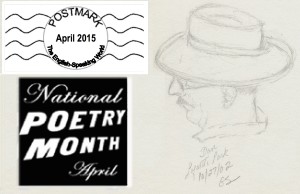 OK, so National Poetry Month is as good an excuse as any to welcome you back to ConVivio —
OK, so National Poetry Month is as good an excuse as any to welcome you back to ConVivio —
Welcome back! It’s been awhile. How’ve you been? Some of you with long memories may remember that I started this blog around harvest time in 2009, and named it after our little amateur winery. In Italian, ConVivio means “festival.” In English, it derives from words like welcoming, friendly, lively, and hospitable — literally “with life.” I began this experiment in storytelling to celebrate all things related to that broad theme. Our media include fiction, non-fiction, poetry, art, travel, music, food, and wine — in no particular order. Today, we re-introduce ConVivio in honor of National Poetry Month, just as we did five years ago this month, with a handful of poems. Even though my own writing is mostly prose, I have long been an admirer of poetry and poetic language. I would like to dispel the notion that poetry is somehow an old, dead art, forced on young people by vengeful English teachers to build character through suffering. I assert that poetry is alive and well and found giving pleasure in a number of places in popular culture. Some of our best known writers of prose are also purveyors of artful language.
The poems I offer today have at least one thing on common — each was written in response to another ‘work of art.’ I include my own unspectacular attempts at poetry and those of a few much more accomplished living poets. You are welcome to participate today, and in the future, by reading what you find here and, if you feel the urge, responding with your own comments and contributions, using the “comments” field at the end of each post. We hope you will join us here often.
============================
A Local Tri-Valley Poet: Lauren de Vore
Since we’re honoring National Poetry Month, it seems appropriate to start with “what is poetry?” Contrary to what some may think, poetry is not an archaic genre or something forced on schoolchildren to inflict pain. Rather poetry is for everyman and by everyman, as relevant today as in the time of Homer and before. As Lauren says…
Poetry Is
by Lauren de Vore (April 14, 2015)
Poetry is a song Poetry is outrage
Where the words themselves For times when prose
Make the music. Is insufficient.
Poetry is a painting Poetry is passion
By hands inept In all its excess
With pigment and brush. And abandon.
Poetry is a love letter Poetry is laughter
For a heart too shy For the simple joys
To speak the words. Of everyday life.
Poetry is the pulse Poetry is crystal
Of memory Pure and transparent
Echoing round the fire. As clear water.
Poetry is a rainbow Poetry is profound
Of dreams tinted Fathomless and dark
With rhythm and rhyme. As the human soul.
Poetry is a prayer Poetry is ageless
Where the poet cries Timeless for as long
Out to his god. As man has words.
This is whiter space without any text at all Poetry is.
============================
Next is a poem I started to write while Gretta and I were sitting in Bryant Park in midtown Manhattan and finished a few blocks away in the lobby of the Algonquin Hotel (where much greater writers did their work in times gone by). What struck me most about Bryant Park was its rhythm — and island of green at the center of the world’s most intense city. This poem is inspired by the rhythm of another poem (OK, a song lyric) by Antonio Carlos Jobim. So, it is truly a response to two other works of art: Jobim’s Waters of March (copied below my poem for your comparison) and Bryant Park itself — a work of urban art on a large scale. It is an experiment in rhythm and image.
Bryant Park: An Island of New York Rhythms Amid the Tall City
By Dan Sapone
Rhythmic inspiration provided by Antonio Carlos Jobim (see below)
A step
outside
both ways to the park
past the guys playing chess
until long after dark.
And the park is alive with the young and the old
reading books on iPads eating ice cream that’s sold . . .
right here
right now
‘mid the tall glass and steel,
‘round this island of green,
where the jugglers are real.
To see and be seen all four classes are there:
Low, middle, and high, and “I don’t really care.”
A beer
A dog
And some ‘kraut on a roll
with a pickle and chips
it’s all food for the soul.
Oh, there’s nori on sushi, and wasabi peas
Chorizo, chipotle, chiabata, and cheese.
Bizz-ness,
all kinds,
being done all around
selling personal jets
and some stuff on the ground.
And the rhythm of now is as old as the land;
it’s as new as the kids playing marbles in sand.
Non-stop
You hear
Varied sounds of the day.
It’s a city at work.
It’s a city at play.
Taxis, busses, and bikes’ polyphonic cacophony,
plays a twenty-first-century version of harmony.
Destination, way station, place to go and to be,
here together alone, plugged in cordlessly.
At night
Gets dark?
No, no, not at all,
For the bright-lit skyscrapers
Shine down on us all.
It changes from everyone’s front porch and yard,
To comf’terble living room with ceiling that’s starred.
It’s here; it’s now; it’s there; it’s then.
And the change ev’ry hour brings us back again . . .
Why here?
Why now?
Are we looking inside?
Or escaping a burden
in plain sight to hide?
In the world spinning faster and faster each day,
We ask, “Will it carry us near or away?”
Our park answers softly, “You can stay just right here.
I’m not changing, honest, you’ve nothing to fear.”
============================
In 2001, “Águas de Março” was named as the all-time best Brazilian song in a poll of Brazilian journalists, musicians and other artists. The central metaphor of The Waters of March gives the impression of the passing of daily life and its progression towards death, just as the rains of March mark the end of a Brazilian summer. But, the translated lyrics speak of “the promise of life,” “the joy in your heart,” and the “promise of spring,” suggesting a much more affirming theme. [iTunes will bring Jane Monheit’s wonderful performance of this song to your iPhone for ninety-nine cents.]
The Waters of March
By Antonio Carlos Jobim
A stick,
a stone,
it’s the end of the road,
It’s the rest of a stump,
it’s a little alone.
It’s a sliver of glass, it is life, it’s the sun
It is night, it is death, it’s a trap, it’s a gun.
The oak when it blooms,
a fox in the brush,
the knot in the wood,
the song of a thrush.
The will of the wind, a cliff, a fall
A scratch, a lump, it is nothing at all.
It’s the wind blowing free,
it’s the end of the slope.
It’s a beam, it’s a void,
it’s a hunch, it’s a hope
And the riverbank talks of the waters of March
It’s the end of all strain, it’s the joy in your heart.
The foot,
the ground,
the flesh and the bone
The beat of the road, a slingshot’s stone.
A fish, a flash, a silvery glow
A fight, a bet, the range of a bow.
The bed of the well, the end of the line,
The dismay in the face, it’s a loss, it’s a find.
A spear, a spike, a point, a nail
A drip, a drop, the end of the tale.
A truckload of bricks in the soft morning light
The sound of a shot in the dead of the night
A mile, a must, a thrust, a bump,
It’s a girl, it’s a rhyme, it’s a cold, it’s the mumps.
The plan of the house, the body in bed
And the car that got stuck, it’s the mud, it’s the mud.
A float, a drift,
a flight, a wing
A hawk, a quail,
the promise of spring.
And the riverbank talks of the waters of March
It’s the promise of life, it’s the joy in your heart.
A snake,
a stick,
it is John, it is Joe,
It’s a thorn on your hand and a cut in your toe.
A point, a grain, a bee, a bite
A blink, a buzzard, a sudden stroke of night.
A pin,
a needle,
a sting, a pain
A snail, a riddle, a wasp or a stain.
A pass in the mountains, a horse and a mule
In the distance the shelves rode three shadows of blue.
And the river bank talks of the waters of March
It’s the promise of life in your heart, in your heart.
A stick, a stone, the end of the road,
The rest of a stump, a lonesome road.
A sliver of glass, a life, the sun,
A knife, a death, the end of the run.
And the river bank talks of the waters of March
It’s the end of all strain, it’s the joy in your heart.
==================
Inspiration from The Lady in the Harbor
Lauren wrote this poem in response to two other works of art: Emma Lazarus’ famous 1883 poem The New Colossus (copied below this one), and the colossal work of art that inspired that poem, The Statue of Liberty, in New York Harbor.
Cry Shame
By Lauren de Vore (September 5, 2014)
I. Hypocrisy
Not like Ms. Liberty whose outstretched hand
And flaming torch did bid world-wide welcome
To exiles seeking sanctuary from
Injustice in their far-off native land,
A barrier in fact and mind’s been built
Against newcomers yearning to breathe free.
Whence came such coldness and hypocrisy?
Have we forgotten all the blood t’was spilt
For freedom’s sake on foreign shores that would
Deny such liberation here at home?
I fear America is passing into gloam
When we forget for what this country stood.
A travesty, the border fence doth shout
“You homeless, poor, and tempest-tost—keep out!”
II. Truths Self-Evident
How short and fickle is the memory
Of those who’d shut this country’s golden door,
And in the closing guilefully ignore
That not so long ago t’was they, t’was we
Who were the immigrants. For then, as now,
The hunger for a better life didst drive
Us all to seek a place where we could thrive,
A land where founding fathers did avow
As truths self-evident that all men are
Created equal, with God-given right
To life and liberty and chance to fight
For happiness ‘neath freedom’s beacon star.
That which was true for generations past
Still’s true for all the wretched and outcast.
III. Cry Shame
Cry shame on all false patriots, on all
Who smirch their heritage fear-mongering
‘Gainst incomers with nonwhite skin, who sling
Their vitriol on any who’d forestall
Such bigotry. There is no honor in
A land that claims to champion liberty
Yet fences out th’oppressed, that piously
Hides prejudice behind flag-waving din.
Who dares’t forget this country’s built upon
The blood and backs of immigrants? They are
Our past, they are our future too, they are
America. If welcome be withdrawn,
Our day will dim, our greatness fade away
Unless Ms. Liberty re-light our way.
==================
And here is the original, when times were different . . .
The New Colossus
By Emma Lazarus (1883)
Not like the brazen giant of Greek fame,
With conquering limbs astride from land to land;
Here at our sea-washed, sunset gates shall stand
A mighty woman with a torch, whose flame
Is the imprisoned lightning, and her name
Mother of Exiles. From her beacon-hand
Glows world-wide welcome; her mild eyes command
The air-bridged harbor that twin cities frame.
“Keep, ancient lands, your storied pomp!” cries she
With silent lips. “Give me your tired, your poor,
Your huddled masses yearning to breathe free,
The wretched refuse of your teeming shore.
Send these, the homeless, tempest-tost to me,
I lift my lamp beside the golden door!”
==================
This next poem, was inspired by a painting Gretta and I discovered in a hotel lobby in Philadelphia on our way to the patio at the back of the hotel beside the river. Walking into the hotel for the first time, the painting called Figures In a Boat by a local artist, caught my attention and made me ask, “What’s the story?” I recorded that first impression in the first part of the poem (“First Look”). At the end of the afternoon, walking back through the lobby past the painting again, it made a different impression, recorded in “Second Look.” THEN, after I sent a copy of the poem and the photo to my nephew Joseph Faletti, he reported that he saw it an entirely different way. His poem, A Different Look, is copied below mine. Joe Faletti is not a poet, or so he says. But as a programmer and software designer he is quite accustomed to making ideas to fit within a predetermined framework. So given the topic and structure he saw in First Look, Second Look, he was able to fit words for the different vision he saw in reaction to what I had seen. He also grew up with an artistic sensibility for the harmonious merger of words, images, and powerful feelings.
First Look
By Dan Sapone (October 2013)
Not alone Here
Accompanied only by responsibility For the one with all the burden
on a wine-dark sea, no oar propels nor rudder guides.
before a fearful scene, Mercy, we must hope, resides in other hands
she stands, and looks, and wonders. if it lives at all.
Here Now
The sea below and sky above No wave nor tide nor wind-filled sail
do not meet with usual grace. moves us anywhere but here.
Between the two, But where to go?
the horizon burns Where is home?
with violence and anger. Were we transported here for safety?
There Or did we drift here into danger?
Do the flames a homeland burn? Was it inattention, mindful negligence, or trust,
Whose? Mine? that brought us here?
An unintended consequence in pursuit of warmth?
Or did someone choose to burn it down, And I
a preferred replacement to install? Sleeping on a steady shoulder
Will the sea between us and danger knowing none of this,
quench the flames can only sleep
us carry safely to a calmer port to wake into whatever destination
or to destruction? that awaits.
Second Look
By Dan Sapone
Alone Here
Accompanied only by the future The one who holds the promise
on hopeful waters, Needs no oar nor rudder to arrive.
before a welcome dawn, Welcome, we learn, resides in other hands
she stands, and looks, and knows. Stretched out to us.
Here Now
Stars that ruled the night An ebbing tide is all it takes
are washed away by a warming sun. to draw us home on well-lit waters
The sky and sea, alike in darkness, Lest we drift away to danger,
conspire to reveal a destination must it be earned
ripe with promise, as the light ascends. through attention, vigilance, and trust
There that brought us here?
Does home await in this morning light? And I
Theirs? And now mine, ours? Sleeping on a steady shoulder
Will the light that brought them here Knowing none of this,
give sight as well to other eyes. can only sleep
What did they offer? to wake into whatever destination
What do we? that awaits.
A Different Look
By Joe Faletti (inspired by First Look, Second Look by Dan Sapone)
Part of a chain
Filled with relief – and awe,
on a wind-swept lake,
as the never-old dawn diffuses through the fog;
he absorbs the moment, and the tossings as of the boat
and is content.
Here
His father taught him to fish here,
arising in darkness to paddle into moonlight.
And to love the water, and the quiet,
and the soft, steady, yet random undulation
and the arrival of dawn –
time to return to land and breakfast.
And perhaps a nap!
There
The wife and mother sleeps in comfort,
secure in the knowing that all is well,
because all is quiet.
Or is she still uneasy —
unable to rest completely,
sensing the half-empty bed
and the empty crib nearby.
Here
The new father sighs at his success
in comforting a colicky child
less desperately than driving the pitted lake road.
And revels in the warm cushion
of a sleeping child, breathing quietly
beside his ear.
Now
One task remains,
more daunting than the recent triumph:
To row back to the dock,
climb the ladder,
and place the baby in a waiting crib,
without disturbing its sleep.
Perhaps he’ll stay
and watch the sun rise a bit longer!
And I
Relaxed and secure in his strong hold,
knowing none of this,
can only sleep
and dream of past and present.
=========================
Of course, many of us — certainly of my generation — have experienced poetry in song lyrics almost more than any other way. I would be remiss if I didn’t acknowledge National Poetry Month without one especially poetic song. Again, this one is a poem written in response to another work of art and its artist, Vincent Van Gogh.
Vincent (Starry, Starry Night)
by Don McLean (inspired by Starry Night by Vincent Van Gogh)
Paint your palette blue and gray
Look out on a summer’s day
With eyes that know the darkness in my soul.
Shadows on the hills
Sketch the trees and the daffodils
Catch the breeze and the winter chills
In colors on the snowy linen land.
This is a blank line
Now I understand
What you tried to say to me
And how you suffered for your sanity
And how you tried to set them free.
They would not listen, they did not know how
Perhaps they’ll listen now.
This is a blank line
Starry, starry night
Flaming flowers that brightly blaze
Swirling clouds in violet haze
Reflect in Vincent’s eyes of china blue
Colors changing hue.
Morning fields of amber grain
Weathered faces lined in pain
Are soothed beneath the artist’s loving hand.
This is a blank line
Now I understand
What you tried to say to me
And how you suffered for your sanity
And how you tried to set them free.
They would not listen, they did not know how
Perhaps they’ll listen now.
This is a blank line
For they could not love you
But still your love was true
And when no hope was left in sight
On that starry, starry night,
You took your life, as lovers often do.
But I could’ve told you, Vincent,
This world was never meant for
One as beautiful as you.
This is a blank line
Starry, starry night
Portraits hung in empty halls
Frame-less heads on nameless walls
With eyes that watch the world and can’t forget
Like the strangers that you’ve met.
The ragged men in ragged clothes
The silver thorn of bloody rose
Lie crushed and broken on the virgin snow.
This is a blank line e
Now I think I know
What you tried to say to me
And how you suffered for your sanity
And how you tried to set them free
They would not listen, they’re not listening still
Perhaps they never will.
===========================
A Pentameter Fistfight Between Iambs (u /) and Trochees (/ u)
by Dan Sapone (2014)
And now something ridiculous for those who remember, from freshman English class, being taught about the strategic use of iambic pentameter vs trochaic pentameter (right, I’m talking about you). It is poetry making fun of itself — because — poetry is supposed to be fun. [Sorry about the blurry image — ain’t technology grand?]
===========================
Our last poem is another by our own local poet, Lauren de Vore. It’s a bit of a teaser — in two weeks, ConVivio will feature an entire post featuring a set of Lauren’s poems. This one is written in the classic sonnet form —about sonnets . . . well sort of.
Poetical Tweets
Sententious and obscure, archaic with
It’s prejudice ‘gainst feet trochaic, curse
Of students forced to parse the poet’s pith.
One hundred forty syllables is all,
Three quatrains and a couplet short and sweet,
Profane, profound or scribbling on a wall.
A free-for-all. The art is knowing when
To bend or break the rules as best befits
The poet’s vision and the poem’s zen.
Tweet sonnets from the subways and sidewalks.
Well, I hope you enjoyed this little tribute to National Poetry Month. If you got this far, let us know what you think.
Although I don’t agree with everything in the articles below, if you’d like some further reading: try this:
http://www.huffingtonpost.com/pam-allyn/why-poetry-matters_b_5185399.html
Or this: http://www.edgemagazine.net/2012/08/why-poetry-matters/
–> Next week: look for a piece of prose — this time a column about the place that Gretta and I have decided is our favorite place in all the world.
Regards — PapaDan
Some Explaining To Do — Act One
The Scene: The curtain opens revealing an office with a desk flanked by a small couch. The sign on the desk reads “A. Gabriel, Chief Messenger, Deputy Associate Admittance Officer.” Behind the desk is a wall with three doors. The door in the center is labeled with a “G” and is open revealing a spiral staircase The door on the right is labeled with an “Up” arrow, as an elevator might. The left door has a “Down” arrow. The Angel Gabriel sits at the desk, writing in a notebook, his famous golden trumpet resting on the desk. A Man named Anthony from the back of the audience walks up the center aisle, climbs three steps to the stage, stands at Gabriel’s desk, hat in hand, and waits.
Gabriel: [Without looking up, gestures to his left.] “Please, take a seat.”
Man: [Looks at the three doors, back at Gabriel and the trumpet, sits, places his hat beside him on the couch. After a pause] “It’s not what I expected.”
Gabriel: “I know it’s not much, but nobody else spends much time here.”
Man: [Matter-of-factly.] “No. Dying. It’s not what I expected.”
Gabriel: [Looks up.] “I suppose it never is; but to tell the truth, you haven’t actually died. Not yet.”
Man: “Well, the scene back there looked pretty … final.”
Gabriel: “I’m sure it may have seemed that way. Sometimes there are surprises.”
Man: “Surprises?” [Looks around, dismisses the idea.] “I didn’t have time to think this over much — look, I’m sure He [Pointing to the center door with the “G.”] will have some hard questions. I guess that’s what this is all about; I’m not sure I’m prepared.”
Gabriel: [He’s heard it before.] “Well, surely you knew there’d be questions?”
Man: “Yes, of course.” [Thinks about it, frowning. After awhile:] “But, you know, I suppose I’ve got some questions … for Him. He’s got some explaining to do, don’t you think?”
Gabriel: [Looking up.] “Questions? [Suppresses a grin.] You actually think you would be the one with the questions right now?”
Man: [Another pause.] “Right.” [Thinks about it some more. Takes a deep breath.] “Well, I’m not so sure. I mean, I guess I only get one shot at this … I’ve seen some pretty confusing stuff back there.” [Points toward the audience.] “You know, some things just don’t add up.”
Gabriel: “Really. And what are those things?” [Not taking this seriously.]
Man: [Very seriously.] “Well, He’s supposed to be all powerful. I mean, if a guy can create the universe and all — and don’t get me wrong it’s magnificent, and creating humans from nothing … well, OK that’s pretty awesome — I’ll give Him that.”
Gabriel: [Sarcastic.] “I’m sure your approval is appreciated.”
Man: [Getting agitated.] “Look, don’t patronize me. This is kinda new territory for me, if you know what I mean.” [Calmer, thoughtful.] “So, the things that happen back there, that must be what He intends, right? The way it happens is ‘the way it’s supposed to be,’ right?”
Gabriel: “Sure, [Quoting.]
“ ‘… in erring reason’s spite, one truth is clear,
Whatever is, is right.’ ”
Man: “Excuse me?”
Gabriel: “Alexander Pope, one of your poets.”
Man: [Not sure what to make of the Angel Gabriel quoting an 18th-century English poet, at this particular moment. Recovers his train of thought.] “I was taught that God loves each of us and created us in His image to be happy with Him [Points at the doors] forever, right?” But what about back there?” [Points to the audience.] “If taking billions of years to create the universe had the sole purpose of paving the way for us precious humans, He sure hasn’t treated us very well.”
Gabriel: “You’re complaining?”
Man: “OK, I’ve had it pretty easy.” [Taken back a bit.] “But, you know, ‘the least’ of His creatures do some serious suffering. Life’s not a bed of roses. Justice isn’t part of the deal. Love can be pretty scarce. Life didn’t come with an instruction manual. And I’m not sure I buy this idea that all of life should be some kind of test. So, is God the ultimate terrorist who threatens us all with the worst just to get what He wants? I wasn’t taught to respect that kind of thing very much. Were you?” [Realizes he may have stepped over a line.]
Gabriel: “Look, you can go on ahead if you want.” [Gestures dismissively toward the door in the center, and turns back to his notebook.]
Man: [Picks up his hat, steps toward the door.] “You know, it’s not just me. Many of us have questions.”
Gabriel: “Again, with your questions.”
Man: “There are many, questions like: ‘Where was God during the Holocaust.’ Many people think that, if a powerful God could have prevented it, a loving God would have. We’ve been taught that allowing evil to happen, if you have the power to prevent it, is the same as doing it yourself. He holds us accountable for that … so I’ve been taught. And evil like that happens every day back there. So, unless he is powerless to intervene …
Yes, I think He’s got some explaining to do.”
Gabriel: “So, you’ve got a proposal for Him?” [Gestures again to the doors.]
Man: [Defiant.] “Well, you know, I’m not so sure He’s the right one for the job. He doesn’t have much of a track record. I’m sure He takes good care of those who end up behind one of those doors, but where I come from, [Points to the audience.] He’s not much good as far as I can see. The good things I’ve seen seem to be done by people and not all of them ‘religious.’ You know, we’ve got people with hungry kids and no way to feed them; we’ve got new diseases every day; rich powerful people got it all and poor people got nothing – millions of them; we’ve got guys with guns killing kids in schools and theaters; we get, floods, famines, droughts, earthquakes; homeless people all over the place; I could go on. He doesn’t seem to be working on it.”
Gabriel: “So, you think you can do better.”
Man: “Well, better than THAT — if I had the power He’s got. If He’s all-powerful, I think He’s got some responsibility for all that. You know, it’s worse than that. [Steps closer to Gabriel.] We’ve got powerful, wealthy institutions that claim to be speaking IN HIS NAME.” [They stare at each other. Gabriel blinks.] “The vulnerable among us listen to their every word, like it is the revealed truth or something. [Notices the irony, but goes on.] Groups with power and wealth support some awful stuff and do their best to make sure that women are kept quiet and poor and have more children than they can feed. And it’s the weakest and poorest who suffer the most, you know. [Realizes he’s ranting.] The bottom line is that these things are done IN HIS NAME. I would think that He would feel some responsibility for that.”
Gabriel: [He’s heard enough, looks up.] “Since you have all the answers, maybe your time has come. Go ahead and take you chances.” [Waves at the door.]
Man: [With some trepidation, picks up his hat, decides he is ready, walks to the middle door, looks back at Gabriel, looks into the audience, and reaches for the doorknob.]
Gabriel: “I suppose there’s another option.”
Man: [Pulls back from the door.] “Another option?”
Gabriel: [Without looking up.] “Before you put it all on the line in there [Points at the door], is there something more YOU could have done?”
Man: “Well, just before I … came up here, there was a guy … well, I didn’t … he looked like he needed … I mean, you know, every day there are so many … ”
Gabriel: [Turns and looks at him directly, interrupting.] “So, what if you had the chance to make it right. Do you think you could make a difference? I mean, you know, with …” [Points at the door in the center, the one with the “G.”]
Man: “You mean I could go back?”
Gabriel: “It happens, on occasion. For a few days, maybe a week or two. Since you’re so unsatisfied with what OTHERS have done [Nods at the door in the center], I suppose you could demonstrate, you know, something better. [Turns back to his notebook] It hasn’t been long, I’m sure nobody noticed you were gone.”
As the curtain slowly begins to close — the Man steps past the curtain, down from the stage, pauses to look back at Gabriel, who isn’t paying attention to him, and walks slowly back down the center aisle. He stops half way, puts on his hat, straightens up, and walks quickly out the back of the audience.
As the Man exits the theater, the middle door, the one with the “G,” opens a crack.
Voice from behind the door: “Is he gone?”
Gabriel: [As the curtain closes.] “Yes, he’s gone; but he’ll be back and you’ll have some explaining to do.”
Intermission
A Glass of Wine Among Friends
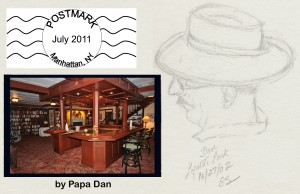 Manhattan, New York — Edward was the first to speak. “So, Walter, this is a lovely place, but why do I feel like you brought me here to steal my money?”
Manhattan, New York — Edward was the first to speak. “So, Walter, this is a lovely place, but why do I feel like you brought me here to steal my money?”
From behind a polished mahogany bar, Walter Morganstern pours dark red wine into crystal port glasses. “Eddie, you haven’t had any money since the crash of ’87, but I invited you anyway.”
Six men, four in suits, two in jeans, all except Walter in their forties, sit in Walter’s personal library — surrounded by hard bound books, some collectibles, mostly law, history, economics, and philosophy. No fiction, no paperbacks.
“Yes, but the millions he has buried in real estate are harder to steal.” This was Patrick Fitzgerald, founder of New England Energy — the youngest of the group.
“Sure, millions . . . unless he tries to sell it.” This was Al Sabo, CEO of USAMortgage. “For that you need buyers.”
“Sure, Al, but lenders like you make your fortune lending to companies who don’t need a lender — just a hiding place. I’d love to introduce you to some REAL buyers. Walter, if you didn’t have the best wine collection in Manhattan I wouldn’t have time for this. But what are these rich guys doing here? John doesn’t even drink.”
Walter places a glass of 1948 Taylor Floodgate in front of four of them, tea in front of John. “You’re all here because you have enough money to have decisions to make about this world-wide financial mess we’re in, and you’re young enough to actually care about the outcome. Pat, your twins are, what, Juniors at Yale?”
“Sophomores, and its Princeton.”
“Of course. My apologies. So for you — all of you — the future isn’t just somebody else’s problem.”
“So, what’s Al doing here?” Laughter and raised glasses all around.
“Hasn’t the mortgage crisis taught you anything? Buyers think they own things, but lenders know the truth, don’t they, Al?”
“Ah, the truth — and it ain’t pretty. So, what ARE we doing here Walter?”
“We’ve got two more guests coming before we get serious.”
“UH-oh, Walter’s going to get serious on us.”
“If you saw the label on that port you wouldda guessed something’s up. Walter, not even you can get a bottle of 1948 Floodgate for less than $800.”
“If you know your labels that well, Al, you know that the best ports drop off a cliff after 60 years. He may have paid that much for it, but he couldn’t get that much for it today. Either he’s been saving it for us or he’s unloading it on us. Which is it Walter?”
“Nothing we bought in the last decade is worth what we paid for it; and that’s part of what you’re doing here.” A buzzer sends him off to answer the door. “I’ll be back. Pour two more of those, will you Ed?”
Walter comes back with his last two guests. “Gentlemen . . . you too, Sabo . . . I want you to meet a couple of people I went to school with. Lew Frazier’s the only one of us still selling anything in this economy, owns a small chain of grocery stores in Virginia — is it six stores, Lew?”
“A dozen. People still gotta eat.”
“I think those of you who can read know Maureen. She writes for the local fishwrapper. She’s here to remind us that we guys aren’t as smart as we think we are.”
“Yes, I’ve read your stuff. You and my wife gang up on me twice a week. Tuesday and Friday, right?”
“Glad you’re paying attention.”
“Lew, Maureen, his is Albert Sabo, our own token predatory lender.”
“Ouch.”
“An endearment, Al. This is Pat Fitzgerald, he’s trying to keep us warm this winter without bankrupting us.”
“Pleased to meet you.”
“Edward Faletti is a venture capitalist. He buys small software companies and tries to call it investing.”
“Don’t you have to make a profit once in awhile to call it investing?” More laughter.
“The snide one there, that’s Dan. He’s a travel writer, sells tours to Italy, and makes fun of the rest of us. Says an economy based on products is doomed. Prefers to let other people pay his way to Europe twice a year instead. He sells experiences; says they hold their value better than commodities.”
“Sounds good to me. Walter, aren’t you going to let them sit down. Here, have a seat.” Ed hands them each a glass. “His port is better than his manners, honest.”
Walter sits on a barstool. “I suppose I could ask all of you how your businesses are doing and you’d all give me bunch of numbers. But if I asked if you were having any fun, I suppose I’d get a different answer.”
“Fun? Whoa, boy. When was that on the menu? I haven’t had ‘fun’ at work since . . . ”
“Right, you can’t remember, can you?”
Remembers. “. . . since I sold Al that bridge in . . . where was it, Al, Brooklyn?”
“OK, Walter, now that we’ve all insulted each other, what’s on your mind?”
Walter looks at each one of them. They have had some fun together over the years —and they’ve worked some serious problems. They all thought of themselves as powerful optimists, capable of making a difference when the market needed an adjustment. “So, let’s sum it up: nobody’s making any money, nobody’s having any fun, except maybe Dan here, and nobody thinks there’s much of a future for any of us. Have I got it about right?” Silent agreement all around.
“Future? It’s tough to see past the end of this bottle you’re pouring from . . . you’ve got another one around here somewhere, I hope.” Nobody laughs, so he drops the frivolity. “OK, I get it. These are hard times. But haven’t we pulled everyone out of hard times before? At least once in this very room, if memory serves, eh Walter?”
“Yes, a couple of you were here in ’87 when we pulled a few strings and got the train back on the track. And some of us know that Patrick’s grandfather sat with a similar bunch of guys at Hyde Park with Roosevelt back in the ‘30s. Each time, somebody had the foresight — and optimism — to imagine a future even though it wasn’t obvious to most people that there was one. Would it surprise you to know that I invited you here for just that reason? Who knows, if you guys are as smart as I think you are, maybe you’ll think of something that Maureen will decide is worth writing about.”
Walter peels back the first sheet on a large pad of flip charts on an easel in front of the bar and takes the cap off a blue marking pen. “Here are the kinds of ideas we’re hearing [starts writing]. Now, I think we can do better . . . perhaps we have an obligation to do better, eh?”
“Walter, forgive me . . . I know you’ve been around longer than the rest of us; but do you actually think a bunch like this can make a difference this time? The world has changed a lot, don’t you think? I can imagine what you want to do; but I’m not sure we can get there from here. We’ve heard plenty about being too big to fail, but is it possible that we’ve gotten too big to succeed?”
“When I was your age, Pat, that’s what I thought. Let me understand — you believe that the problems we have are too great, the solutions too decentralized, and the global economy is too big to get our hands around.”
“Sure, but it’s tougher than that. I recall Professor Belotti telling us back in Econ 101 that the amount of money involved in macroeconomics is only part of the story. It’s the velocity of money that is at the core of both problems and solutions.”
“So, you believe that economic activity has gotten too fast for us to influence it?”
“With respect, Walter, when my grandfather was your age, that’s what he thought. The problem with the economics at work today is that it has gotten so slow that it barely moves. Many of us in this room survived the recession, at least so far, because we do have access to cash; but the cash we can lay our hands on today is the result of slowing everything down, laying people off, stopping the supply chain, letting inventories draw down, investing in nothing — sure that gives us all a pocketful of cash; but whatta you gonna do with it? Al, here’s got money to lend, but who’s he gonna lend it to? Surely not people who are unemployed; not those facing foreclosure. Lew’s got money in the bank — but that’s because his payroll is two-thirds of what it was. Ed isn’t promoting new products because customers aren’t buying new products — heck, they’re barely buying his established products; and if they are, they’re paying bargain prices, right Ed? So, lots of the people we do business with are holding on to cash because hiring people won’t increase sales, unemployed customers don’t get excited about new products, and lending money to optimists isn’t going to reduce foreclosures and bankruptcies — we tried that, eh?”
“So, Walt, what do you think we can write on those flip charts that will get people to save more and spend more at the same time? What will we plan for the day when we wake up and realize that the federal budget goes almost entirely to pay the salaries of American employees; and budget cuts just toss them out of work? What plan can we pour out of that bottle that will get the Congress to do anything to increase tax revenues to keep paying those salaries? If we cut the budget without increasing revenue, can our unemployed workers produce products that the world will buy? How long will other countries keep lending us money when they realize that our consumers can’t afford to buy their products?”
“We can all sound pretty smart when we ask the questions, Lew; but we don’t sound so useful when we get around to answering them. The bottom line? — The one thing everybody needs is customers. Customers need to have jobs. Who has enough money to hire ten million people with little hope of return on the investment? I don’t. Do you?”
The silence was complete and prolonged. Finally, Walter put the cap back on his blue marking pen. John put down his cup of tea.
After awhile, Maureen broke the silence. “So, this is what you guys want me to write about? That you can’t get there from here?”
More silence.
“Not yet,” Walter said. “We’ve got to wait until Dan plans his next vacation — then at least we’ll know where we’re going.”
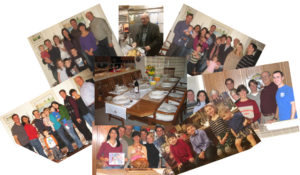

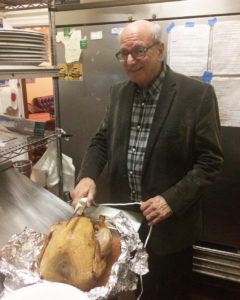

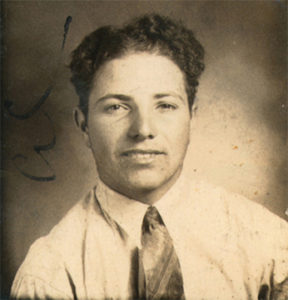

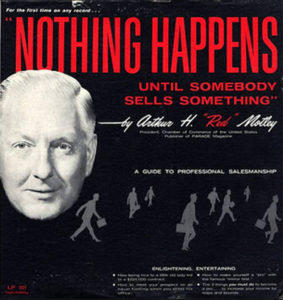




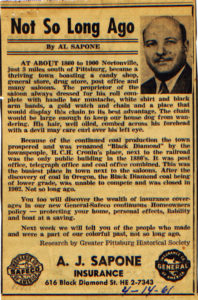

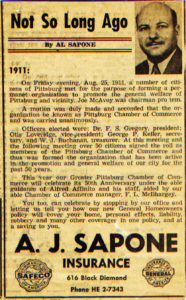
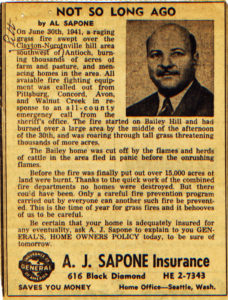

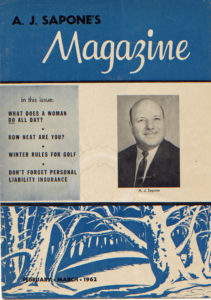
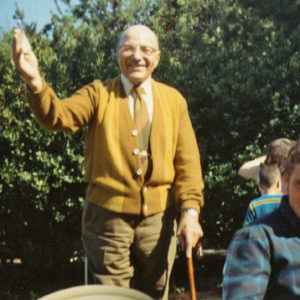
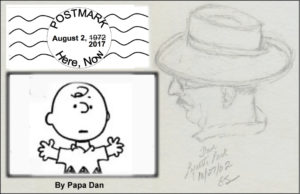

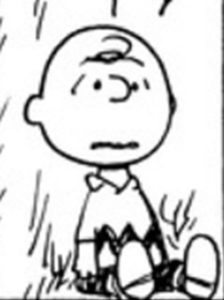

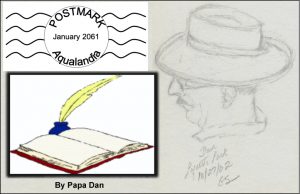
 A Field, In Your Dreams
A Field, In Your Dreams 





